Cabletron Systems 6H128 08 Users Manual Ch1Book
6H129-08 to the manual 229b1dd0-ec9a-4cad-b1b4-fda8c783e01e
2015-02-05
: Cabletron-Systems Cabletron-Systems-6H128-08-Users-Manual-530336 cabletron-systems-6h128-08-users-manual-530336 cabletron-systems pdf
Open the PDF directly: View PDF ![]() .
.
Page Count: 172 [warning: Documents this large are best viewed by clicking the View PDF Link!]
- Notice
- Contents
- Introduction
- Network Requirements
- Installation
- Troubleshooting
- Local Management
- 5.1 Overview
- 5.2 Local Management Keyboard Conventions
- 5.3 Management Terminal Setup
- 5.4 Accessing Local Management
- 5.5 The Main Menu Screen
- 5.6 Chassis Menu Screen
- 5.7 Chassis Configuration Screen
- 5.8 SNMP Community Names Screen
- 5.9 SNMP Traps Screen
- 5.10 Chassis Environmental Screen
- 5.11 Port Redirect Function Screen
- 5.12 Module Selection Screen
- 5.13 Module Menu Screen
- 5.14 Module Configuration Menu Screen
- 5.15 General Configuration Screen
- 5.15.1 Setting the IP Address
- 5.15.2 Setting the Subnet Mask
- 5.15.3 Setting the Default Gateway
- 5.15.4 Setting the TFTP Gateway IP Address
- 5.15.5 Setting the Module Date
- 5.15.6 Setting the Module Time
- 5.15.7 Entering a New Screen Refresh Time
- 5.15.8 Setting the Screen Lockout Time
- 5.15.9 Setting the Operational Mode
- 5.15.10 Setting the Management Mode
- 5.15.11 Configuring the COM Port
- 5.15.12 Clearing NVRAM
- 5.15.13 Enabling/Disabling IP Fragmentation
- 5.16 SNMP Community Names Screen
- 5.17 SNMP Traps Screen
- 5.18 Switch Configuration Screen
- 5.19 Ethernet Interface Configuration
- 5.20 Module Specific Configuration Menu
- 5.21 System Resources Screen
- 5.22 Flash Download Screen
- 5.23 Port Redirect Function Screen
- 5.24 Broadcast Suppression Screen
- 5.25 Module Statistics Menu Screen
- 5.26 Switch Statistics Screen
- 5.27 Interface Statistics Screen
- 5.28 RMON Statistics Screen
- 5.29 Network Tools
- Specifications
- FE-100TX, FE-100FX and FE-100F3 Specifications
- Optional Installations and Mode Switch Bank Settings
- Index
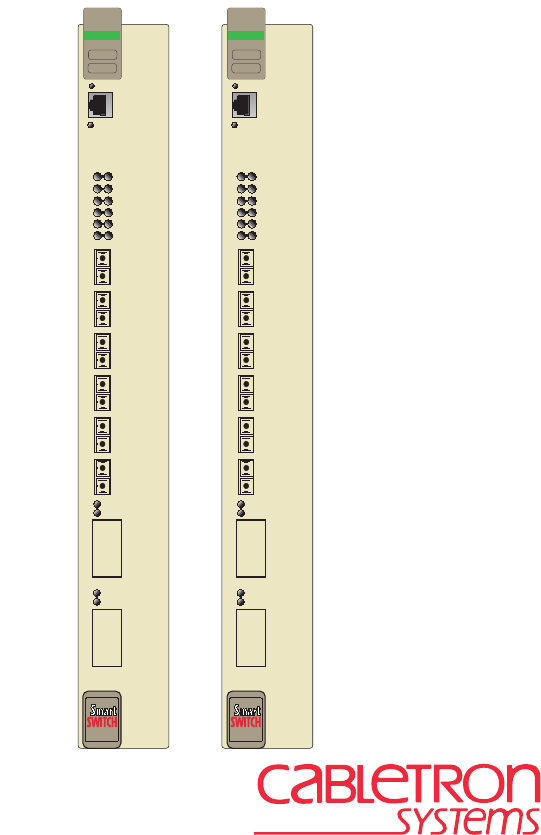
6H128-08 and 6H129-08
SmartSwitch 6000 Modules
User’s Guide
2
3
4
5
6
1
COM
CPU
RESET
2
3
4
5
6
1
COM
CPU
RESET
1
2
3
4
5
6
1
2
3
4
5
6
7
8
6H129-08
FAST ENET
7
8
6H128-08
FAST ENET
9032364-02


6H128-08 and 6H129-08 User’s Guide i
NOTICE
Cabletron Systems reserves the right to make changes in specifications and other information
contained in this document without prior notice. The reader should in all cases consult Cabletron
Systems to determine whether any such changes have been made.
The hardware, firmware, or software described in this manual is subject to change without notice.
IN NO EVENT SHALL CABLETRON SYSTEMS BE LIABLE FOR ANY INCIDENTAL,
INDIRECT, SPECIAL, OR CONSEQUENTIAL DAMAGES WHATSOEVER (INCLUDING BUT
NOT LIMITED TO LOST PROFITS) ARISING OUT OF OR RELATED TO THIS MANUAL OR
THE INFORMATION CONTAINED IN IT, EVEN IF CABLETRON SYSTEMS HAS BEEN
ADVISED OF, KNOWN, OR SHOULD HAVE KNOWN, THE POSSIBILITY OF SUCH
DAMAGES.
1998 by Cabletron Systems, Inc., P.O. Box 5005, Rochester, NH 03866-5005
All Rights Reserved
Printed in the United States of America
Order Number: 9032364-02 September 1998
Cabletron Systems
,
SPECTRUM
,
LANVIEW
,
QuickSET
, and
SecureFast
are registered
trademarks and
SmartSwitch
is a trademark of Cabletron Systems, Inc.
All other product names mentioned in this manual may be trademarks or registered trademarks of
their respective companies.
FCC NOTICE
This device complies with Part 15 of the FCC rules. Operation is subject to the following two
conditions: (1) this device may not cause harmful interference, and (2) this device must accept any
interference received, including interference that may cause undesired operation.
NOTE:
This equipment has been tested and found to comply with the limits for a Class A digital
device, pursuant to Part 15 of the FCC rules. These limits are designed to provide reasonable
protection against harmful interference when the equipment is operated in a commercial environment.
This equipment uses, generates, and can radiate radio frequency energy and if not installed in
accordance with the operator’s manual, may cause harmful interference to radio communications.
Operation of this equipment in a residential area is likely to cause interference in which case the user
will be required to correct the interference at his own expense.
WARNING:
Changes or modifications made to this device which are not expressly approved by the
party responsible for compliance could void the user’s authority to operate the equipment.
Only qualified personnel should install the 6H128-08 and the
6H129-08.

Notice
ii 6H128-08 and 6H129-08 User’s Guide
INDUSTRY CANADA NOTICE
This digital apparatus does not exceed the Class A limits for radio noise emissions from digital
apparatus set out in the Radio Interference Regulations of the Canadian Department of
Communications.
Le présent appareil numérique n’émet pas de bruits radioélectriques dépassant les limites applicables
aux appareils numériques de la class A prescrites dans le Règlement sur le brouillage radioélectrique
édicté par le ministère des Communications du Canada.
VCCI NOTICE
This is a Class A product based on the standard of the Voluntary Control Council for Interference by
Information Technology Equipment (VCCI). If this equipment is used in a domestic environment,
radio disturbance may arise. When such trouble occurs, the user may be required to take corrective
actions.
CABLETRON SYSTEMS, INC. PROGRAM LICENSE AGREEMENT
IMPORTANT:
Before utilizing this product, carefully read this License Agreement.
This document is an agreement between you, the end user, and Cabletron Systems, Inc. (“Cabletron”)
that sets forth your rights and obligations with respect to the Cabletron software program (the
“Program”) contained in this package. The Program may be contained in firmware, chips or other
media. BY UTILIZING THE ENCLOSED PRODUCT, YOU ARE AGREEING TO BECOME
BOUND BY THE TERMS OF THIS AGREEMENT, WHICH INCLUDES THE LICENSE AND
THE LIMITATION OF WARRANTY AND DISCLAIMER OF LIABILITY. IF YOU DO NOT
AGREE TO THE TERMS OF THIS AGREEMENT, PROMPTLY RETURN THE UNUSED
PRODUCT TO THE PLACE OF PURCHASE FOR A FULL REFUND.

Notice
6H128-08 and 6H129-08 User’s Guide iii
CABLETRON SOFTWARE PROGRAM LICENSE
1. LICENSE. You have the right to use only the one (1) copy of the Program provided in this
package subject to the terms and conditions of this License Agreement.
You may not copy, reproduce or transmit any part of the Program except as permitted by the
Copyright Act of the United States or as authorized in writing by Cabletron.
2. OTHER RESTRICTIONS. You may not reverse engineer, decompile, or disassemble the
Program.
3. APPLICABLE LAW. This License Agreement shall be interpreted and governed under the laws
and in the state and federal courts of New Hampshire. You accept the personal jurisdiction and
venue of the New Hampshire courts.
EXCLUSION OF WARRANTY AND DISCLAIMER OF LIABILITY
1. EXCLUSION OF WARRANTY. Except as may be specifically provided by Cabletron in
writing, Cabletron makes no warranty, expressed or implied, concerning the Program (including
its documentation and media).
CABLETRON DISCLAIMS ALL WARRANTIES, OTHER THAN THOSE SUPPLIED TO
YOU BY CABLETRON IN WRITING, EITHER EXPRESSED OR IMPLIED, INCLUDING
BUT NOT LIMITED TO IMPLIED WARRANTIES OF MERCHANTABILITY AND
FITNESS FOR A PARTICULAR PURPOSE, WITH RESPECT TO THE PROGRAM, THE
ACCOMPANYING WRITTEN MATERIALS, AND ANY ACCOMPANYING HARDWARE.
2. NO LIABILITY FOR CONSEQUENTIAL DAMAGES. IN NO EVENT SHALL
CABLETRON OR ITS SUPPLIERS BE LIABLE FOR ANY DAMAGES WHATSOEVER
(INCLUDING, WITHOUT LIMITATION, DAMAGES FOR LOSS OF BUSINESS,
PROFITS, BUSINESS INTERRUPTION, LOSS OF BUSINESS INFORMATION, SPECIAL,
INCIDENTAL, CONSEQUENTIAL, OR RELIANCE DAMAGES, OR OTHER LOSS)
ARISING OUT OF THE USE OR INABILITY TO USE THIS CABLETRON PRODUCT,
EVEN IF CABLETRON HAS BEEN ADVISED OF THE POSSIBILITY OF SUCH
DAMAGES. BECAUSE SOME STATES DO NOT ALLOW THE EXCLUSION OR
LIMITATION OF LIABILITY FOR CONSEQUENTIAL OR INCIDENTAL DAMAGES, OR
ON THE DURATION OR LIMITATION OF IMPLIED WARRANTIES, IN SOME
INSTANCES THE ABOVE LIMITATIONS AND EXCLUSIONS MAY NOT APPLY TO
YOU.
UNITED STATES GOVERNMENT RESTRICTED RIGHTS
The enclosed product (a) was developed solely at private expense; (b) contains “restricted computer
software” submitted with restricted rights in accordance with Section 52227-19 (a) through (d) of the
Commercial Computer Software - Restricted Rights Clause and its successors, and (c) in all respects
is proprietary data belonging to Cabletron and/or its suppliers.
For Department of Defense units, the product is licensed with “Restricted Rights” as defined in the
DoD Supplement to the Federal Acquisition Regulations, Section 52.227-7013 (c) (1) (ii) and its suc-
cessors, and use, duplication, disclosure by the Government is subject to restrictions as set forth in sub-
paragraph (c) (1) (ii) of the Rights in Technical Data and Computer Software clause at 252.227-7013.
Cabletron Systems, Inc., 35 Industrial Way, Rochester, New Hampshire 03867-0505.

Notice
iv 6H128-08 and 6H129-08 User’s Guide
SAFETY INFORMATION
CLASS 1 LASER TRANSCEIVERS
THE FE-100F3 FAST ETHERNET INTERFACE MODULE USES CLASS
1 LASER TRANSCEIVERS. READ THE FOLLOWING SAFETY
INFORMATION BEFORE
INSTALLING OR OPERATING THESE MODULES.
The Class 1 laser transceivers use an optical feedback loop to maintain Class 1 operation limits. This
control loop eliminates the need for maintenance checks or adjustments. The output is factory set, and
does not allow any user adjustment. Class 1 Laser transceivers comply with the following safety
standards:
• 21 CFR 1040.10 and 1040.11 U.S. Department of Health and Human Services (FDA).
• IEC Publication 825 (International Electrotechnical Commission).
• CENELEC EN 60825 (European Committee for Electrotechnical Standardization).
When operating within their performance limitations, laser transceiver output meets the Class 1
accessible emission limit of all three standards. Class 1 levels of laser radiation are not considered
hazardous.
SAFETY INFORMATION
CLASS 1 LASER TRANSCEIVERS
LASER RADIATION AND CONNECTORS
When the connector is in place, all laser radiation remains within the fiber. The maximum amount of
radiant power exiting the fiber (under normal conditions) is -12.6 dBm or 55 x 10
-6
watts.
Removing the optical connector from the transceiver allows laser radiation to emit directly from the
optical port. The maximum radiance from the optical port (under worst case conditions) is
0.8 W cm
-2
or 8 x 10
3
W m
2
sr-1.
Do not use optical instruments to view the laser output. The use of optical instruments to view
laser output increases eye hazard. When viewing the output optical port, power must be
removed from the network adapter.

Notice
6H128-08 and 6H129-08 User’s Guide v
DECLARATION OF CONFORMITY
Application of Council Directive(s):
89/336/EEC
73/23/EEC
Manufacturer’s Name:
Cabletron Systems, Inc.
Manufacturer’s Address:
35 Industrial Way
PO Box 5005
Rochester, NH 03867
European Representative Name:
Mr. J. Solari
European Representative Address:
Cabletron Systems Limited
Nexus House, Newbury Business Park
London Road, Newbury
Berkshire RG13 2PZ, England
Conformance to Directive(s)/Product Standards:
EC Directive 89/336/EEC
EC Directive 73/23/EEC
EN 55022
EN 50082-1
EN 60950
Equipment Type/Environment:
Networking Equipment, for use in a
Commercial or Light
Industrial
Environment.
We the undersigned, hereby declare, under our sole responsibility, that the equipment packaged
with this notice conforms to the above directives.
Manufacturer Legal Representative in Europe
Mr. Ronald Fotino Mr. J. Solari
___________________________________ ___________________________________
Full Name Full Name
Principal Compliance Engineer Managing Director - E.M.E.A.
___________________________________ ___________________________________
Title Title
Rochester, NH, USA Newbury, Berkshire, England
___________________________________ ___________________________________
Location Location

Notice
vi 6H128-08 and 6H129-08 User’s Guide

6H128-08 and 6H129-08 User’s Guide vii
CONTENTS
CHAPTER 1 INTRODUCTION
1.1 Using This Guide......................................................................... 1-1
1.2 Structure of This Guide................................................................ 1-1
1.3 6H12X-08 Overview .................................................................... 1-3
1.3.1 Connectivity .................................................................... 1-3
1.3.2 Full Duplex Switched Ethernet (FDSE)........................... 1-3
1.3.3 Runtime IP Address Discovery ....................................... 1-5
1.3.4 Management................................................................... 1-5
1.3.5 Remote Monitoring (RMON) ........................................... 1-6
1.3.6 Switching Options ........................................................... 1-6
1.3.7 Standards Compatibility.................................................. 1-6
1.3.8 Year 2000 Compliant ...................................................... 1-6
1.3.9 LANVIEW Diagnostic LEDs ............................................ 1-7
1.4 Local Management Features.......................................................1-7
1.4.1 Broadcast Suppression................................................... 1-7
1.4.2 Port Redirect Function .................................................... 1-7
1.4.3 Distributed Chassis Management................................... 1-7
1.4.4 SmartTrunk ..................................................................... 1-8
1.5 Optional Features........................................................................ 1-8
1.6 Document Conventions ............................................................. 1-10
1.7 Getting Help............................................................................... 1-11
1.8 Related Manuals........................................................................ 1-12
CHAPTER 2 NETWORK REQUIREMENTS
2.1 SmartTrunk.................................................................................. 2-1
2.2 10BASE-T Network ..................................................................... 2-1
2.3 100BASE-TX Network................................................................. 2-2
2.4 100BASE-FX Fiber Optic Network .............................................. 2-2
CHAPTER 3 INSTALLATION
3.1 Unpacking the 6H12X-08 ............................................................ 3-1
3.2 Installing 6H12X-08 Options........................................................3-2
3.3 Installing the 6H12X-08 into the 6C105 Chassis......................... 3-3
3.4 Connecting to the Network .......................................................... 3-5
3.4.1 Connecting Fiber Optic Cables to Ports 1
Through 6 ....................................................................... 3-5
3.4.2 Connecting a Twisted Pair Segment to the FE-100TX ... 3-8
3.4.3 Connecting a Fiber Optic Segment to the
FE-100FX and FE-100F3 ............................................. 3-10
3.5 Completing the Installation ........................................................ 3-12

Contents
viii 6H128-08 and 6H129-08 User’s Guide
CHAPTER 4 TROUBLESHOOTING
4.1 Using LANVIEW...........................................................................4-1
4.2 FE-100TX LED.............................................................................4-5
4.3 Troubleshooting Checklist............................................................4-6
4.4 Using the RESET Button .............................................................4-7
CHAPTER 5 LOCAL MANAGEMENT
5.1 Overview ......................................................................................5-1
5.2 Local Management Keyboard Conventions .................................5-3
5.3 Management Terminal Setup.......................................................5-4
5.3.1 Console Cable Connection..............................................5-4
5.3.2 Management Terminal Setup Parameters ......................5-6
5.3.3 Telnet Connections .........................................................5-7
5.3.4 Monitoring an Uninterruptible Power Supply...................5-7
5.4 Accessing Local Management .....................................................5-8
5.4.1 Navigating Local Management Screens........................5-10
5.4.2 Selecting Local Management Menu Screen Items........5-12
5.4.3 Exiting Local Management Screens..............................5-12
5.5 The Main Menu Screen..............................................................5-14
5.6 Chassis Menu Screen................................................................5-15
5.7 Chassis Configuration Screen ...................................................5-17
5.7.1 Setting the IP Address...................................................5-20
5.7.2 Setting the Subnet Mask ...............................................5-20
5.7.3 Setting the Chassis Date...............................................5-21
5.7.4 Setting the Chassis Time ..............................................5-22
5.7.5 Entering a New Screen Refresh Time...........................5-22
5.7.6 Setting the Screen Lockout Time ..................................5-23
5.7.7 Setting the Operational Mode........................................5-23
5.8 SNMP Community Names Screen.............................................5-25
5.8.1 Establishing Community Names ...................................5-27
5.9 SNMP Traps Screen ..................................................................5-28
5.9.1 Configuring the Trap Table............................................5-29
5.10 Chassis Environmental Screen..................................................5-30
5.11 Port Redirect Function Screen...................................................5-31
5.11.1 Displaying the Source and Destination Entries .............5-34
5.11.2 Changing Source and Destination Ports .......................5-34
5.12 Module Selection Screen ...........................................................5-35
5.12.1 Selecting a Module........................................................5-37
5.13 Module Menu Screen.................................................................5-37
5.14 Module Configuration Menu Screen ..........................................5-38

Contents
6H128-08 and 6H129-08 User’s Guide ix
5.15 General Configuration Screen................................................... 5-40
5.15.1 Setting the IP Address .................................................. 5-44
5.15.2 Setting the Subnet Mask............................................... 5-46
5.15.3 Setting the Default Gateway ......................................... 5-46
5.15.4 Setting the TFTP Gateway IP Address......................... 5-47
5.15.5 Setting the Module Date ............................................... 5-48
5.15.6 Setting the Module Time............................................... 5-48
5.15.7 Entering a New Screen Refresh Time .......................... 5-49
5.15.8 Setting the Screen Lockout Time.................................. 5-50
5.15.9 Setting the Operational Mode ....................................... 5-50
5.15.10 Setting the Management Mode..................................... 5-51
5.15.11 Configuring the COM Port ............................................ 5-52
5.15.11.1 Changing the Com Port Application ............. 5-54
5.15.12 Clearing NVRAM .......................................................... 5-55
5.15.13 Enabling/Disabling IP Fragmentation ........................... 5-56
5.16 SNMP Community Names Screen ............................................ 5-56
5.16.1 Establishing Community Names................................... 5-58
5.17 SNMP Traps Screen.................................................................. 5-60
5.17.1 Configuring the Trap Table ........................................... 5-61
5.18 Switch Configuration Screen ..................................................... 5-62
5.18.1 Setting the STA............................................................. 5-65
5.18.2 Setting the Age Time .................................................... 5-65
5.18.3 Setting (Enabling or Disabling) the Port Status ............ 5-66
5.19 Ethernet Interface Configuration................................................ 5-66
5.19.1 Configuring an FE-100FX/F3 Interface or a Port 7
or 8 FE-100FX/F3 Interface .......................................... 5-69
5.19.2 Configuring an FE-100TX Interface .............................. 5-70
5.19.3 Setting the FE-100TX Operational Mode...................... 5-70
5.19.4 Setting the FE-100TX Advertised Ability....................... 5-70
5.20 Module Specific Configuration Menu......................................... 5-71
5.21 System Resources Screen........................................................ 5-72
5.21.1 Setting the Reset Peak Utilization ................................ 5-74
5.22 Flash Download Screen ............................................................ 5-74
5.22.1 Image File Download Using TFTP................................ 5-76
5.22.2 Image File Download Using RUNTIME ........................ 5-77
5.22.3 Image File Download Using BootP ............................... 5-78
5.23 Port Redirect Function Screen .................................................. 5-79
5.23.1 Displaying the Source and Destination Entries............. 5-81
5.23.2 Changing Source and Destination Ports....................... 5-81
5.24 Broadcast Suppression Screen................................................. 5-82
5.24.1 Setting the Threshold.................................................... 5-84
5.24.2 Setting the Reset Peak Switch ..................................... 5-84
5.25 Module Statistics Menu Screen................................................. 5-84

Contents
x 6H128-08 and 6H129-08 User’s Guide
5.26 Switch Statistics Screen.............................................................5-86
5.26.1 Using the Clear Counters Command ............................5-87
5.27 Interface Statistics Screen .........................................................5-88
5.27.1 Displaying Interface Statistics .......................................5-91
5.27.2 Using the Clear Counters Command ............................5-91
5.28 RMON Statistics Screen ............................................................5-92
5.28.1 Displaying RMON Statistics ..........................................5-95
5.28.2 Using the Clear Counters Command ............................5-96
5.29 Network Tools ............................................................................5-96
5.29.1 Built-In Commands........................................................5-98
5.29.2 Special Commands .....................................................5-106
APPENDIX A SPECIFICATIONS
A.1 Device Specifications.................................................................. A-1
A.2 Physical Properties ..................................................................... A-1
A.3 Environmental Requirements...................................................... A-1
A.4 Input/Output Ports....................................................................... A-2
A.5 COM Port Pinout Assignments ................................................... A-2
A.6 Regulatory Compliance............................................................... A-3
APPENDIX B FE-100TX, FE-100FX AND FE-100F3
SPECIFICATIONS
B.1 FE-100TX.................................................................................... B-1
B.1.1 Auto-Negotiation............................................................. B-2
B.2 FE-100FX.................................................................................... B-3
B.3 FE-100F3 .................................................................................... B-4
APPENDIX C OPTIONAL INSTALLATIONS AND
MODE SWITCH BANK SETTINGS
C.1 Required Tools............................................................................ C-1
C.2 Setting the Mode Switch .............................................................C-1
C.3 Installing Optional Fast Ethernet Interface Modules ...................C-4
INDEX

6H128-08 and 6H129-08 User’s Guide 1-1
CHAPTER 1
INTRODUCTION
Welcome to the Cabletron Systems
6H128-08 and 6H129-08
SmartSwitch 6000 Modules User’s Guide
.
This guide describes the
6H128-08 and 6H129-08 interface modules and provides information
concerning network requirements, installation, troubleshooting, and the
use of Local Management for these modules.
1.1 USING THIS GUIDE
Read through this guide completely to understand the features,
capabilities, and Local Management functions of the 6H128-08 and
6H129-08 modules. A general working knowledge of Ethernet and IEEE
802.3 type data communications networks and their physical layer
components is helpful when using these devices.
1.2 STRUCTURE OF THIS GUIDE
This guide is organized as follows:
Chapter 1,
Introduction
, outlines the contents of this manual, describes
the features of the 6H12X-08, and provides instructions for getting
additional help. This chapter also includes a list of technology and user
guides that may help the user to set up and manage the 6H12X-08.
Chapter 2,
Network Requirements
, outlines the network requirements
that must be met before installing the 6H12X-08 into the 6C105
SmartSwitch 6000 chassis.
NOTE
The 6H128-08 and 6H129-08 have identical features and
functions with the exception that the 6H128-08 supports
multimode fiber, and the 6H129-08 supports single mode fiber
on their fixed ports.
If the information discussed in this document applies to both
the 6H128-08 and 6H129-08, they will be referred to as either
the 6H12X-08 or the module. If the information applies
specifically to one module, that module will be referred to by its
specific name, such as the 6H129-08.

Chapter 1:
Introduction
1-2 6H128-08 and 6H129-08 User’s Guide
Chapter 3,
Installation
, provides instructions on how to install the
module in the chassis and connect segments to the device.
Chapter 4,
Troubleshooting
, details the 6H12X-08 LANVIEW LEDs
that enable quick diagnosis of network/operational problems.
Chapter 5,
Local Management
, describes how to access Local
Management and use the Local Management screens to manage the
6H12X-08 and 6C105 chassis.
Appendix A,
Specifications
, contains information on functionality and
operating specifications, connector pinouts, environmental requirements,
and physical properties.
Appendix B,
FE-100TX, FE-100FX and FE-100F3 Specifications
,
contains information about FE-100TX pinouts and cable types used with
the FE-100FX and FE100-F3.
Appendix C,
Optional Installations and Mode Switch Bank Settings
,
describes how to install optional Fast Ethernet Interface Modules and how
to set the mode switches.

6H12X-08 Overview
6H128-08 and 6H129-08 User’s Guide 1-3
1.3 6H12X-08 OVERVIEW
The 6H12X-08 (the 6H128-08 is shown in Figure 1-1) is a Fast Ethernet
interface module for the Cabletron Systems 6C105 chassis. The module
has six switched fiber optic ports and two optional ports for Fast Ethernet
Interface Modules.
The 6H128-08 has six multimode fiber optic 100BASE-FX switched
ports using SC connectors, while the 6H129-08 has six single mode fiber
optic 100BASE-FX switched ports also using SC connectors.
The 6H12X-08 supports IEEE 802.1D switching (bridging), Port Based
VLANs (IEEE 802.1Q), and Cabletron Systems SecureFast Switching
Virtual Network technology. The 6H12X-08 is used to connect individual
high-bandwidth user devices, such as workstations, and to provide a
central switching point for multiple 10/100 Mbps Fast Ethernet segments.
1.3.1 Connectivity
The 6H12X-08 connects to Ethernet networks or workstations through six
fiber optic ports with SC connections on the front panel. The 6H128-08
supports multimode fiber SC ports, and the 6H129-08 supports single
mode fiber SC ports. The multimode ports are IEEE 802.3u 100BASE-FX
compliant.
The 6H12X-08 has two front panel slots (ports 7 and 8) for optional Fast
Ethernet Interface Modules (FE-100TX, FE-100FX, and FE-100F3) to
support an uplink to 100 Mbps Fast Ethernet backbones or a high speed
connection to a local server using twisted pair, multimode or single mode
fiber optic cabling.
1.3.2 Full Duplex Switched Ethernet (FDSE)
Each switched Fast Ethernet port on the 6H12X-08 supports 100 Mbps
operation and can be configured to operate in Full Duplex Switched
Ethernet (FDSE) mode. FDSE allows each Fast Ethernet port to provide
up to 200 Mbps of throughput.
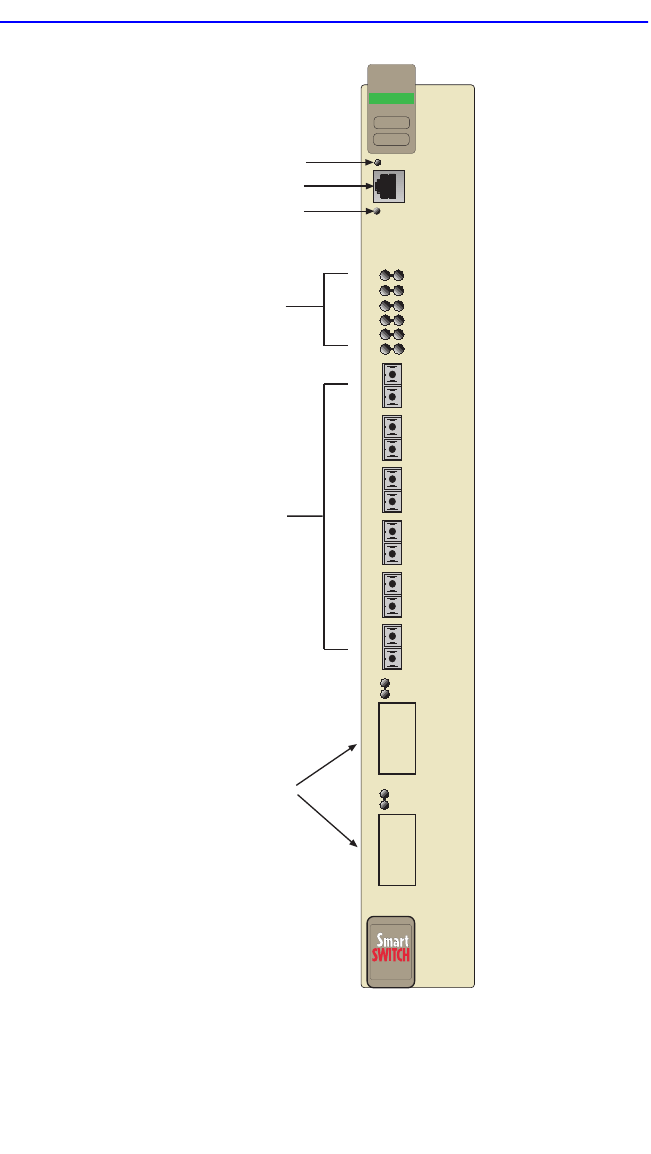
Chapter 1:
Introduction
1-4 6H128-08 and 6H129-08 User’s Guide
Figure 1-1 The 6H12X-08
23640101
7
8
6H128-08
FAST ENET
COM
CPU
RESET
Reset Button
CPU LED
Port Status LEDs
Network Ports 1-6
Optional Fast Ethernet
Module Ports 7 and 8
COM Port
2
3
4
5
6
1
1
2
3
4
5
6

6H12X-08 Overview
6H128-08 and 6H129-08 User’s Guide 1-5
1.3.3 Runtime IP Address Discovery
This feature enables the 6H12X-08 to automatically accept an IP address
from a BootP server on the network into NVRAM without requiring a
user to enter an IP address through Local Management.
When the 6H12X-08 is connected to the network and powered up,
Runtime IP Address Discovery (RAD) checks the 6H12X-08 for an IP
address. If one has not been assigned (6H12X-08 IP address set to
0.0.0.0), RAD checks to see if any of the 6H12X-08 interfaces have a
link. If so, RAD sends out Reverse Address Resolution Protocol (RARP)
and BootP requests to obtain an IP address from a BootP or RARP server
on the network.
The RAD requests start out at an interval of 1 second and doubles after
every transmission until an interval of 300 seconds is reached. At this
point, the interval remains at 300 seconds. The RAD requests continue
until an IP address is received from a BootP or RARP server, or an IP
address is entered using Local Management.
1.3.4 Management
Management of the 6H12X-08 is accomplished using Local Management
tools or remote Simple Network Management Protocol (SNMP)
management stations. In-band remote management is possible using any
SNMP compliant Network Management Software. Out-of-band Local
Management is provided through the RJ45 COM port on the front panel
using a VT100 terminal, or a remote VT100 terminal emulator via a
modem connection, and in-band via a Telnet connection.
Local Management provides the ability to manage the 6H12X-08 and any
of the optional Fast Ethernet Interface Modules installed in ports 7 and 8
of the 6H12X-08.

Chapter 1:
Introduction
1-6 6H128-08 and 6H129-08 User’s Guide
1.3.5 Remote Monitoring (RMON)
The 6H12X-08 supports all Ethernet RMON groups, which include
Statistics, Alarms, Events and History. These groups are enabled on all
ports by default.
Cabletron Systems RMON Actions is a vendor specific extension of
RMON and provides the ability to set an “Action” on any SNMP MIB
variable. The Action can be triggered by any RMON Event and/or Alarm.
The Action can be, for example, to turn a MIB-2 interface off if a
broadcast threshold is crossed.
1.3.6 Switching Options
The 6H12X-08 provides IEEE 802.1D switching, IEEE 802.1Q, or
SecureFast Switching Virtual Network Services between all of the front
panel interfaces including Fast Ethernet Interface Modules. SecureFast
Switching and IEEE 802.1Q allow for migration to Virtual Network
technologies without requiring the replacement of existing equipment.
1.3.7 Standards Compatibility
The 6H12X-08 meets 802.3u specifications, and provides IEEE 802.1D
and DEC Spanning Tree Algorithm (STA) support to enhance the overall
reliability of the network and protect against “loop” conditions. The
6H12X-08 supports a wide variety of industry standard MIBs including
RFC 1213 (MIB II), RFC 1757 (RMON), RFC 1371 (RS232 MIB),
RFC 1493 (Bridge MIB) and RFC 1354 (FIB MIB). A full suite of
Cabletron Systems Enterprise MIBs provide a wide array of statistical
information to enhance troubleshooting.
1.3.8 Year 2000 Compliant
The 6H12X-08 has an internal clock that can maintain the time and date
beyond the year 1999.

Local Management Features
6H128-08 and 6H129-08 User’s Guide 1-7
1.3.9 LANVIEW Diagnostic LEDs
The various conditions of the LANVIEW diagnostic LEDs serve as
important troubleshooting aids. They provide an easy way to observe the
transmit and receive status of individual ports and overall network
operations such as system status, switching configuration, and Fast
Ethernet channel usage. Chapter 4 provides details about the 6H12X-08
LANVIEW LEDs.
1.4 LOCAL MANAGEMENT FEATURES
Local Management provides the tools that allow management of the
6H12X-08, any installed Fast Ethernet Interface Modules, and the 6C105
chassis, using SNMP compliant management tools.
1.4.1 Broadcast Suppression
Broadcast Suppression allows a user to set a desired limit of receive
broadcast frames per port/per second to be forwarded out the other ports
on the module up to the set limit. Any broadcast frames above this
specified limit are dropped. In the event that broadcast frames are being
suppressed, multicast and unicast frames continue to be switched.
1.4.2 Port Redirect Function
The port redirect function, also referred to as “Port Mirroring,” is a
troubleshooting tool used to map traffic from a single source port or
multiple source ports to a destination port(s) within the chassis. This
feature functions at the bit level, which allows all packets, including those
with errors, to be copied and sent to an analyzer or RMON probe. The
analyzer or RMON probe will see the data as if it is directly connected to
the LAN segment of the source port(s).
1.4.3 Distributed Chassis Management
From a management perspective, the 6C105 SmartSwitch 6000 chassis
can be viewed as a single entity with a single IP address. Its management
functions are distributed to all modules. This means a single module in
the chassis, such as the 6H12X-08, can be used to manage the entire
chassis, and any other attached module through Local Management,
SNMP, or Telnet applications.

Chapter 1:
Introduction
1-8 6H128-08 and 6H129-08 User’s Guide
1.4.4 SmartTrunk
SmartTrunk, also referred to as SmartTrunking, is Cabletron Systems’
terminology for load balancing or load sharing. SmartTrunk technology
provides an easy-to-implement mechanism to group, or aggregate,
multiple physical links together to scale the backbone bandwidth beyond
the limitations of a single link. All links are user-configurable so
administrators can scale the backbone bandwidth by adding SmartTrunk
links. The SmartTrunk benefits are as follows:
•
All purchased bandwidth is used.
•
Distributed, resilient links increase reliability and performance.
•
Multiple technologies are supported within a single trunk for
maximum flexibility.
For more information about SmartTrunk, refer to the Cabletron Systems
SmartTrunk User’s Guide
.
1.5 OPTIONAL FEATURES
Options for the 6H12X-08 include Fast Ethernet Interface Modules to add
additional interface capability.
Cabletron Systems provides Fast Ethernet Interface Modules to support
uplinks to 100 Mbps Ethernet backbones or high speed connections to
servers. The Fast Ethernet Interface Modules are listed in Table 1-1.

Optional Features
6H128-08 and 6H129-08 User’s Guide 1-9
Table 1-1 Fast Ethernet Interface Modules
P/N Description Application
FE-100TX Uses RJ45
connector
Supports Category 5 Unshielded Twisted Pair
(UTP) cabling, which has an impedance of 85 to
111 ohms.
FE-100FX Uses SC
connector Supports multimode fiber optic cabling.
FE-100F3 Uses SC
connector Supports single mode fiber optic cabling.
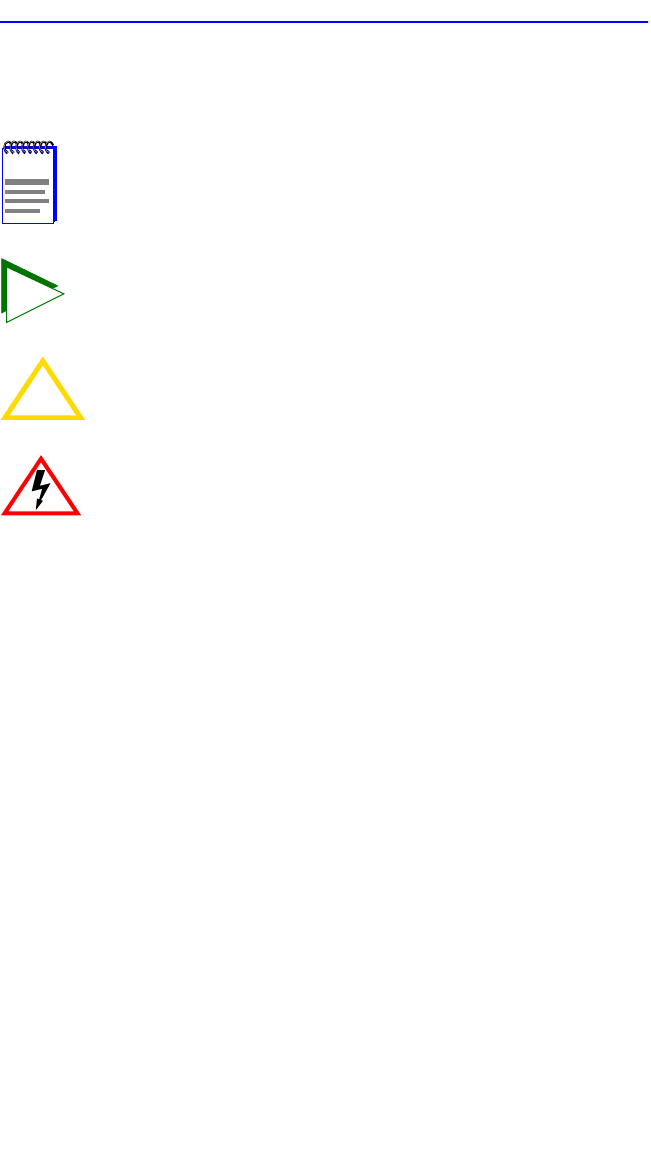
Chapter 1:
Introduction
1-10 6H128-08 and 6H129-08 User’s Guide
1.6 DOCUMENT CONVENTIONS
The following conventions are used throughout this document:
NOTE
Note
symbol. Calls the reader’s attention to any item of
information that may be of special importance.
TIP
Tip
symbol. Conveys helpful hints concerning procedures or
actions.
!
CAUTION
Caution
symbol. Contains information essential to avoid
damage to the equipment.
Electrical Hazard Warning
symbol. Warns against an action
that could result in personal injury or death due to an electrical
hazard.

Getting Help
6H128-08 and 6H129-08 User’s Guide 1-11
1.7 GETTING HELP
For additional support related to this device or document, contact the
Cabletron Systems Global Call Center:
Before calling the Cabletron Systems Global Call Center, have the
following information ready:
•Your Cabletron Systems service contract number
•A description of the failure
•A description of any action(s) already taken to resolve the problem
(e.g., changing mode switches, rebooting the unit, etc.)
•The serial and revision numbers of all involved Cabletron Systems
products in the network
•A description of your network environment (layout, cable type, etc.)
•Network load and frame size at the time of trouble (if known)
•The device history (i.e., have you returned the device before, is this a
recurring problem, etc.)
•Any previous Return Material Authorization (RMA) numbers
World Wide Web http://www.cabletron.com/
Phone (603) 332-9400
Internet mail support@cabletron.com
FTP ftp://ftp.cabletron.com/
Login
anonymous
Password
your email address
To send comments or suggestions concerning this document, contact the
Cabletron Systems Technical Writing Department via the following
email address: TechWriting@cabletron.com
Make sure to include the document Part Number in the email message.

Chapter 1: Introduction
1-12 6H128-08 and 6H129-08 User’s Guide
1.8 RELATED MANUALS
The following manuals may help the user to setup and manage the
6H12X-08:
Cabletron Systems 6C105 SmartSwitch 6000 Overview and Setup Guide
Cabletron Systems Networking Guide
Cabletron Systems Guide to Network Troubleshooting
Cabletron Systems Local Management for CSX200, CSX400,
CSX400-DC, HSIM-W6, and HSIM-W84
Cabletron Systems HSIM-A6DP User’s Guide
Cabletron Systems HSIM-F6 User’s Guide
Cabletron Systems HSIM-FE6 User’s Guide
Cabletron Systems HSIM-W6 Installation Guide
Cabletron Systems HSIM-W84 Installation Guide
Cabletron Systems HSIM-W87 User’s Guide
Cabletron Systems HSIM-G01/G09 User’s Guide
Cabletron Systems Ethernet Technology Guide
Cabletron Systems Cabling Guide
Cabletron Systems Port Based VLAN User’s Guide
Cabletron Systems SmartTrunk User’s Guide
These manuals can be obtained from the World Wide Web in Adobe
Acrobat Portable Document Format (PDF) at the following site:
http://www.cabletron.com/
NOTE All documentation for the Cabletron Systems SecureFast VLAN
Manager Software can be found on the VLAN Manager
CD-ROM.
The documentation for the HSIM-W6 and HSIM-W84 can also
be found on the QuickSET CD-ROM.

6H128-08 and 6H129-08 User’s Guide 2-1
CHAPTER 2
NETWORK REQUIREMENTS
Before installing the 6H12X-08 or Fast Ethernet Interface Modules,
review the requirements and specifications referred to in this chapter
concerning the following:
•SmartTrunk (Section 2.1)
•10BASE-T Twisted Pair Network (Section 2.2)
•100BASE-TX Twisted Pair Network (Section 2.3)
•100BASE-FX Fiber Optic Network (Section 2.4)
The network installation must meet the guidelines to ensure satisfactory
performance of this equipment. Failure to follow the guidelines may
produce poor network performance.
2.1 SmartTrunk
To connect the 6H12X-08 to a network so it can take advantage of the
SmartTrunk feature, there are certain rules concerning port connections
and configurations that must be followed for proper operation. Refer to
the Cabletron Systems SmartTrunk User’s Guide for additional
information.
2.2 10BASE-T NETWORK
When connecting a 10BASE-T segment to an optional FE-100TX, ensure
that the network meets the Ethernet network requirements of the IEEE
802.3 standard for 10BASE-T. Refer to the Cabletron Systems Cabling
Guide for details.
NOTE The Cabletron Systems
Cabling Guide
and
SmartTrunk User’s
Guide
referred to in the following sections can be found on the
Cabletron Systems World Wide Web
site: http://www.cabletron.com/
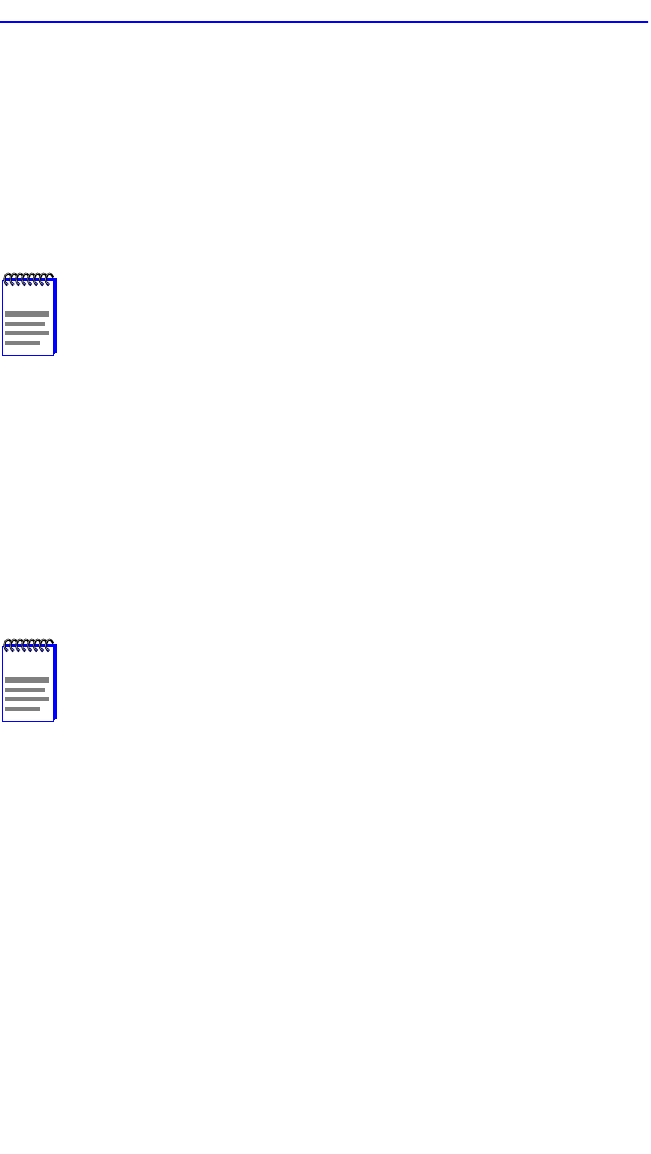
Chapter 2: Network Requirements
2-2 6H128-08 and 6H129-08 User’s Guide
2.3 100BASE-TX NETWORK
The 6H12X-08, with an FE-100TX installed in ports 7 or 8, provides an
RJ45 connection that supports UTP cabling with an impedance between
85 and 111 ohms. The device at the other end of the twisted pair segment
must meet IEEE 802.3u 100BASE-TX Fast Ethernet network
requirements for the devices to operate at 100 Mbps. Refer to the
Cabletron Systems Cabling Guide for details.
2.4 100BASE-FX FIBER OPTIC NETWORK
Ports 7 and 8 of the 6H12X-08 support the Cabletron Systems FE-100FX
and FE-100F3 fiber optic interface modules. The device at the other end
of the fiber optic segment must meet the 100BASE-FX Fast Ethernet
network requirements to operate at 100 Mbps. Refer to the Cabletron
Systems Cabling Guide for details.
Multimode Mode Fiber Optic Cable Length
The maximum multimode fiber optic cable length of a 100BASE-FX
segment is covered in the Cabletron Systems Cabling Guide.
Single Mode Fiber Cable Lengths
The maximum single mode fiber optic length of a 100BASE-FX segment
may be no more than 5 km between Data Terminal Equipment (DTE to
DTE) in half duplex mode or 20 km (DTE to DTE) in full duplex mode.
NOTE The 6H12X-08 with an FE-100TX installed is capable of
operating at either 10 or 100 Mbps. The FE-100TX can
automatically sense the speed of the other device and adjust
its speed accordingly. For details, see Appendix B. If operating
at 100 Mbps, the cable must be Category 5 compliant with an
impedance of 85 to 111 ohms.
NOTE The 6H128-08 has six fixed SC fiber optic ports designed for
use with multimode fiber. The 6H129-08 also has six fixed SC
fiber optic ports, but it is designed for use with single mode
fiber optic cabling. Use of the wrong cabling can cause network
problems.

6H128-08 and 6H129-08 User’s Guide 3-1
CHAPTER 3
INSTALLATION
This chapter covers the required tools and instructions for installing the
6H12X-08 module into the 6C105 SmartSwitch 6000 chassis. Follow the
order provided below to correctly install the 6H12X-08.
•Unpacking the 6H12X-08 (Section 3.1)
•Installing options (Section 3.2)
•Installing the 6H12X-08 into the 6C105 chassis (Section 3.3)
•Connecting to the network (Section 3.4)
•Completing the installation (Section 3.5)
3.1 UNPACKING THE 6H12X-08
To unpack the shipment, proceed as follows:
1. Open the box and remove the 6H12X-08 from the shipping box. Save
all shipping material in case any items need to be returned.
2. Verify the contents of the carton as listed in Table 3-1.
Only qualified personnel should install the 6H12X-08.
!
CAUTION
Failure to observe static safety precautions could cause
damage to the 6H12X-08. Follow static safety handling rules
and use the antistatic wrist strap provided with the 6C105
chassis.
!
CAUTION
Do not cut the non-conductive bag to remove the module.
Damage could result from sharp objects contacting the board
or components.

Chapter 3: Installation
3-2 6H128-08 and 6H129-08 User’s Guide
3. Carefully remove the module, which is wrapped in a non-conductive
bag, from the shipping box.
4. Peel off the black and yellow tape seal on the non-conductive bag to
remove the module.
5. Remove the module from the non-conductive bag. Observe all
precautions listed on the non-conductive bag to prevent damage from
Electrostatic Discharge (ESD).
6. Perform a visual inspection of the module for any signs of physical
damage. If there are any signs of damage, contact the Cabletron
Systems Global Call Center. Refer to Section 1.7 for details.
3.2 INSTALLING 6H12X-08 OPTIONS
If installing the 6H12X-08 with an optional Fast Ethernet Interface
Module(s), refer to Appendix C for installation instructions.
Table 3-1 Contents of 6H12X-08 Carton
Item Quantity
6H128-08 or
6H129-08 1
Manual Accessory Kit 1
NOTE Install any optional equipment before proceeding to
Section 3.3.

Installing the 6H12X-08 into the 6C105 Chassis
6H128-08 and 6H129-08 User’s Guide 3-3
3.3 INSTALLING THE 6H12X-08 INTO THE 6C105
CHASSIS
The 6H12X-08 can be installed in any of the five slots that are available in
the 6C105 chassis. To install a module, proceed as follows:
1. Locate the antistatic wrist strap shipped with the 6C105 chassis.
Attach the strap to your wrist and plug the cable from the antistatic
wrist strap into the ESD grounding receptacle at the upper right corner
of the 6C105.
2. Remove the blank panel covering the slot where the module will be
installed. All other slots must remain covered to ensure proper
circulation and cooling. (Save the blank plate in the event you need to
remove the module.)
3. Locate the slot guides that line up with the number of the slot in which
the module will be installed. Install the module in the chassis by
aligning the module circuit card between the upper and lower metal
rail guides of the desired slot, sliding it into the chassis, and locking
down the top and bottom plastic locking tabs, as shown in Figure 3-1.
Ensure that the module slides in straight and properly engages the
backplane connectors.
!
CAUTION
Failure to observe static safety precautions could cause
damage to the 6H12X-08. Follow static safety handling rules
and use the antistatic wrist strap provided with the 6C105
chassis. Do not cut the non-conductive bag to remove the
module. Damage could result from sharp objects contacting the
board or components.
!
CAUTION
To prevent damaging the backplane connectors in the following
step, ensure that the module slides in straight and properly
engages the backplane connectors.
NOTE In the following step, ensure that the top plastic locking tab
lines up with the desired slot number located on the front panel
of the chassis. Refer to Figure 3-1.
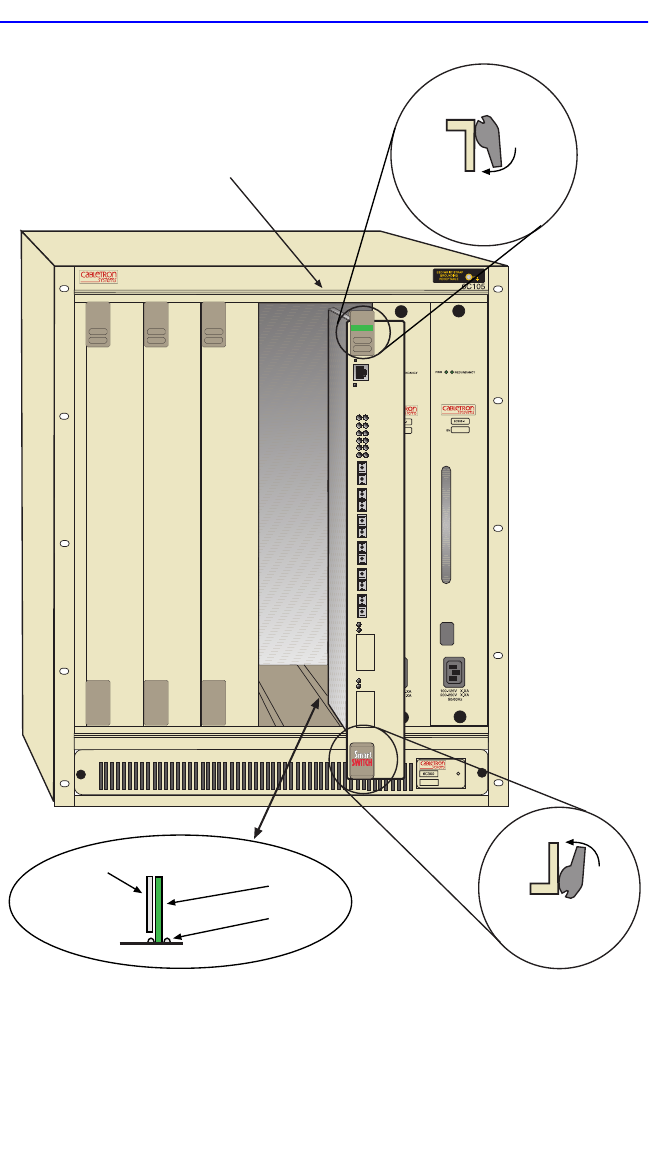
Chapter 3: Installation
3-4 6H128-08 and 6H129-08 User’s Guide
Figure 3-1 Installing an Interface Module
12345 PS1 PS2
Plastic
Locking Tab
Slot Number
2159-02
2159-01
7
8
COM
CPU
6H128-08
FAST ENET
2
3
4
5
6
1
RESET
Circuit Card
Card Guides
Metal Back-Panel
Plastic Locking Tab
1
2
3
4
5
6

Connecting to the Network
6H128-08 and 6H129-08 User’s Guide 3-5
3.4 CONNECTING TO THE NETWORK
This section provides the procedures for connecting fiber optic and
twisted pair segments from the network or other devices to the 6H12X-08.
Ports 1 through 6 have SC connectors for fiber. The 6H128-08 supports
multimode fiber, and the 6H129-08 supports single mode fiber. Ports 7
and 8 support FE-100TX, FE-100FX, or FE-100F3 Fast Ethernet
Interface Modules. The FE-100TX has an RJ45 connector for a Twisted
Pair cable connection. The FE-100FX and FE-100F3 have SC connectors
for fiber optic cable connections.
Refer to Section 3.4.1 to make fiber connections to ports 1 through 6.
Refer to Section 3.4.2 to make a twisted pair connection to an FE-100TX
in port slot 7 or 8.
Refer to Section 3.4.3 to make a fiber optic cable connection to an
FE-100FX or FE-100F3 in port slot 7 or 8.
3.4.1 Connecting Fiber Optic Cables to Ports 1
Through 6
Ports 1 through 6 of the 6H12X-08 have SC style network ports (see
Figure 3-2). Cabletron Systems supplies fiber optic cable that uses SC
style connectors that are keyed to ensure proper crossing over of the
transmit and receive fibers. The 6H128-08 is designed for use with
multimode fiber, and the 6H129-08 is designed for use with single mode
fiber. Use of the incorrect fiber type may cause network problems. Please
refer to the Cabletron Systems Cabling Guide for further information.
NOTE If the 6H12X-08 is being installed in a network using
SmartTrunking, there are rules concerning the network cable
and port configurations that must be followed for
SmartTrunking to operate properly. Before connecting the
cables, refer to the
SmartTrunk User’s Guide
for the
configuration information.

Chapter 3: Installation
3-6 6H128-08 and 6H129-08 User’s Guide
Fiber Optic Network Connection
1. Remove the protective rubber covers from the fiber optic ports on the
applicable port on the module and from the ends of the SC connectors.
2. Insert one end of the SC connector into the port on the 6H12X-08
module. See Figure 3-2.
3. At the other end of the fiber optic cable, attach the SC connector to the
other device.
!
CAUTION
An odd number of crossovers (preferably one) must be
maintained between devices so that the transmit port of one
device is connected to the receive port of the other device and
vice versa.
If the fiber optic cable being used has SC style connectors that
do not resemble MIC style connectors, or has SC connectors
on one end and a different type on the other, such as ST
connectors, ensure that the proper crossover occurs.
!
CAUTION
Do not touch the ends of the fiber optic strands, and do not let
the ends come in contact with dust, dirt, or other contaminants.
Contamination of the ends causes problems in data
transmissions. If the ends become contaminated, blow the
surfaces clean with a canned duster. A fiber port cleaning swab
saturated with optical-grade isopropyl alcohol may also be used
to clean the ends.
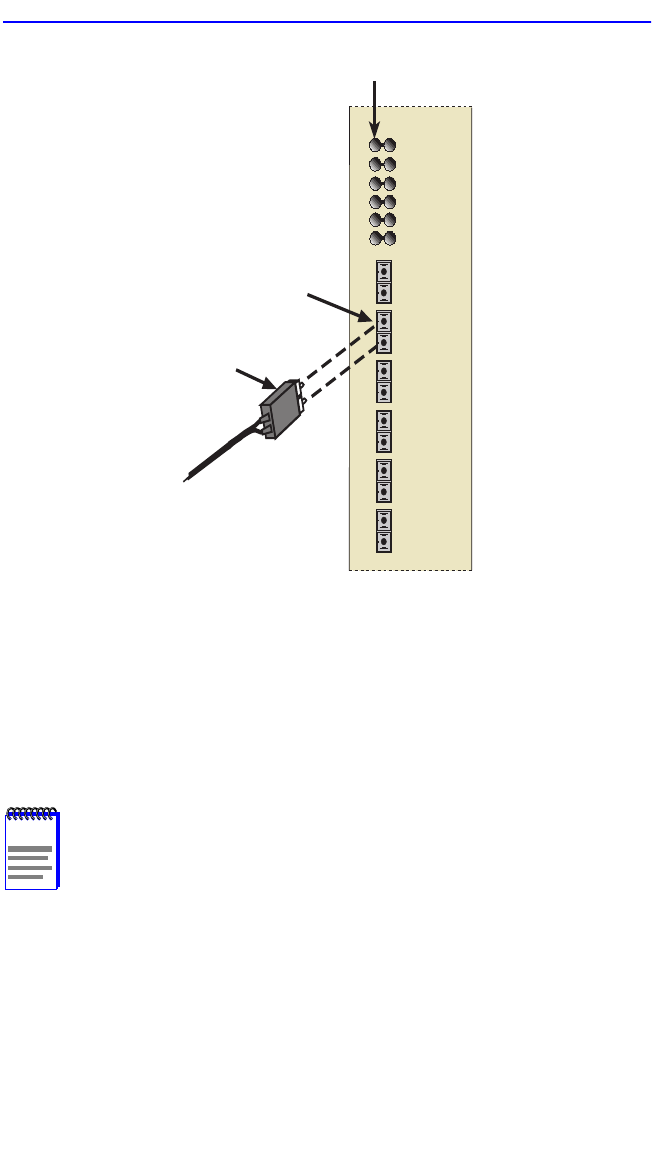
Connecting to the Network
6H128-08 and 6H129-08 User’s Guide 3-7
Figure 3-2 6H12X-08 Fiber Port Connection
4. Verify that a link exists by checking that the port RX LED is on
(flashing amber, blinking green, or solid green). If the RX LED is off
and the TX LED is not blinking amber, perform the following steps
until it is on:
a. Ensure that the power is turned on for the device at the other end
of the link.
b. Verify that the fiber connections between the applicable port on
the 6H12X-08 and fiber optic device on the other end of the fiber
optic link segment are properly crossed over.
NOTE During the bootup process, the RX LED flashes green and
amber, and will not indicate if a link exists until bootup is
complete.
2
3
4
5
6
1
RX (Receive) LED
2159-03
Fiber Port
SC Connector
1
2
3
4
5
6
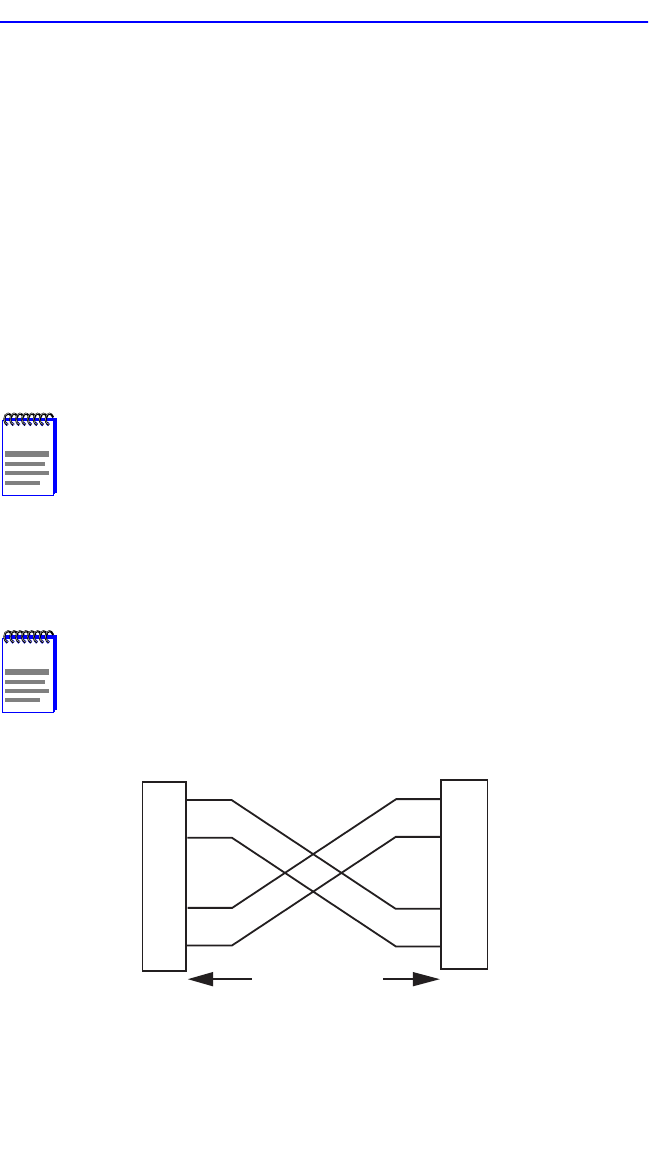
Chapter 3: Installation
3-8 6H128-08 and 6H129-08 User’s Guide
c. Make sure that the fiber connection meets dB loss specifications
for a 100BASE-FX link as specified in the Cabletron Systems
Cabling Guide.
d. See Section 5.19 for information on how to manage the connected
port.
If a link has not been established, refer to Chapter 4, before contacting the
Cabletron Systems Global Call Center. Refer to Section 1.7 for help if the
problem has not been resolved.
3.4.2 Connecting a Twisted Pair Segment to the
FE-100TX
An FE-100TX installed in port 7 and/or 8 has an internal crossover
switch, which acts like a crossover cable. A schematic of a crossover
cable is shown in Figure 3-3.
Figure 3-3 Cable Pinouts - (RJ45) Crossover Cable
NOTE To ensure proper operation, use only Category 5 Unshielded
Twisted Pair (UTP) cabling that has an impedance of 85 to
111 ohms.
NOTE RX+/RX- and TX+/TX- must share a common color pair. For
example, the receive pair may use the white/blue, blue/white
pair, while the transmit pair may use the white/orange,
orange/white pair.
TX+
TX–
RX+
RX– 2
1
3
6
10BASE-T Device Port
TX+
TX–
2
1
3
6
SmartSwitch RJ45 Port
2159_04
RJ45 to RJ45
RX+
RX–

Connecting to the Network
6H128-08 and 6H129-08 User’s Guide 3-9
If a crossover is required, but crossover cabling is not available, use the
switch on the FE-100TX to internally cross over the RJ45 port. Figure 3-4
shows how to properly set the FE-100TX crossover switch.
Figure 3-4 FE-100TX Crossover Switch
When connecting a workstation, use a straight-through cable and set the
Fast Ethernet Interface Module crossover switch shown in Figure 3-4 to
the crossed over position marked with X. When connecting networking
devices, such as another bridge, repeater, or router, use a straight-through
cable and set the Fast Ethernet Interface Module crossover switch shown
in Figure 3-4 to the not crossed over position, marked with “=”.
Connect an FE-100TX to a twisted pair segment as follows:
1. Ensure that the device connected to the other end of the segment is
powered ON.
2. Connect the twisted pair segment to the module, by inserting its RJ45
connector into the RJ45 port, shown in Figure 3-4.
3. Verify that a link exists by checking that the port RX LED is on
(flashing amber, blinking green, or solid green). If the RX LED is off,
perform the following steps until it is on:
a. Verify that the device at the other end of the twisted pair segment
is powered up.
b. Verify that the RJ45 connector on the twisted pair segment has the
proper pinouts.
c. Check the cable for continuity.
d. Make sure that the twisted pair connection meets dB loss and cable
specifications for a 100 BASE-TX link as given in the Cabletron
Systems Cabling Guide.
Position X
(crossed over)
1. RX+
2. RX-
3. TX+
4. NC
5. NC
6. TX-
7. NC
8. NC
Position =
(not crossed over)
1. TX+
2. TX-
3. RX+
4. NC
5. NC
6. RX-
7. NC
8. NC
FE-100TX
10
16651_05
100
=
x

Chapter 3: Installation
3-10 6H128-08 and 6H129-08 User’s Guide
e. Confirm that the crossover switch is in the correct position.
If a link has not been established, refer to Appendix B and Chapter 4
before contacting the Cabletron Systems Global Call Center. Refer to
Section 1.7 for details.
3.4.3 Connecting a Fiber Optic Segment to the
FE-100FX and FE-100F3
The FE-100FX and FE-100F3 have an SC style network port (see
Figure 3-5). Cabletron Systems offers optional fiber optic cables that use
SC style connectors. These connectors are keyed to ensure proper cross
over of the transmit and receive fibers. The FE-100FX is designed for use
with multimode fiber, and the FE-100F3 is designed to use single mode
fiber. Use of the incorrect fiber type may cause network problems. Please
refer to the Cabletron Systems Cabling Guide for further information.
Fiber Optic Network Connection
To connect a fiber optic segment, proceed as follows:
1. Remove the protective rubber covers from the fiber optic ports on the
applicable port on the module and from the ends of the SC connectors.
NOTE See Appendix B for more information describing how an
FE-100TX module links to another device.
!
CAUTION
An odd number of crossovers (preferably one) must be
maintained between devices so that the transmit port of one
device is connected to the receive port of the other device and
vice versa.
If the fiber optic cable being used has SC style connectors that
do not resemble MIC style connectors, or has SC connectors
on one end and a different type on the other, such as ST
connectors, ensure that the proper crossing over occurs.
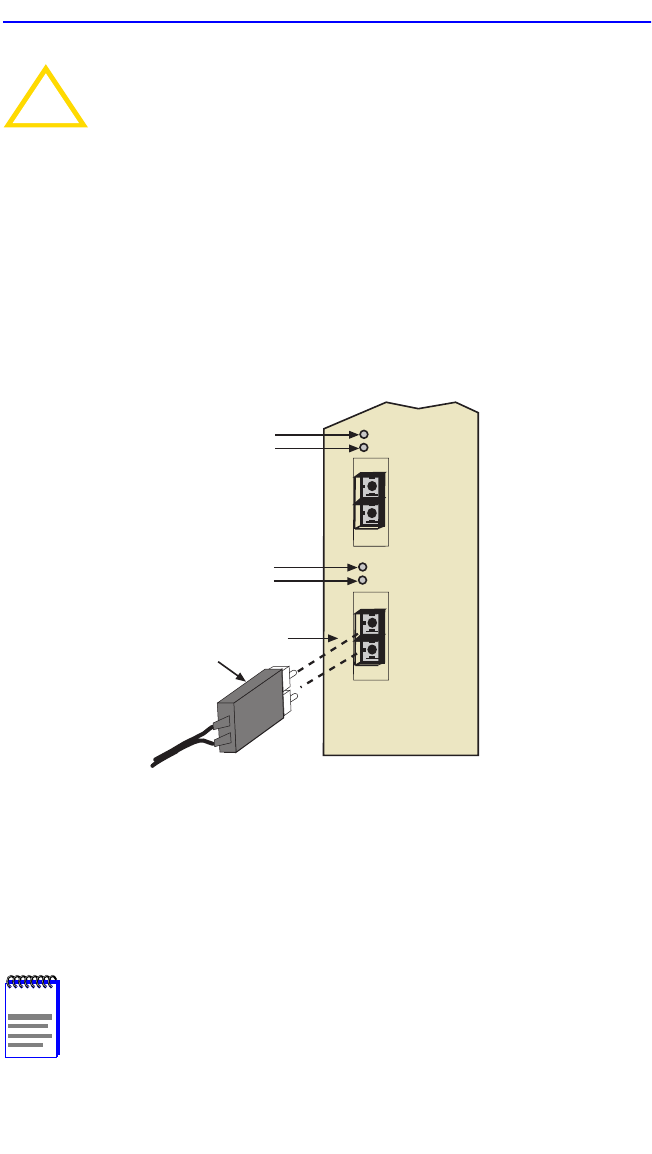
Connecting to the Network
6H128-08 and 6H129-08 User’s Guide 3-11
2. Insert one end of the SC connector into the FE-100FX or FE-100F3
installed in the 6H12X-08 module. See Figure 3-5.
3. At the other end of the fiber optic cable, attach the SC connector to the
other device.
Figure 3-5 FE-100FX and FE-100F3 Port Connection
4. Verify that a link exists by checking that the port RX LED is on
(flashing amber, blinking green, or solid green). If the RX LED is off
and the TX LED is not blinking amber, perform the following steps
until it is on:
!
CAUTION
Do not touch the ends of the fiber optic strands, and do not let
the ends come in contact with dust, dirt, or other contaminants.
Contamination of the ends causes problems in data
transmissions. If the ends become contaminated, blow the
surface clean with a canned duster. A fiber port cleaning swab
saturated with optical-grade isopropyl alcohol may also be used
to clean the ends.
NOTE During the bootup process, the RX LED flashes green and
amber, and will not indicate if a link exists until bootup is
complete.
2159-06
7
8
RX LED
TX LED
RX LED
TX LED
SC Connector
Fiber Port

Chapter 3: Installation
3-12 6H128-08 and 6H129-08 User’s Guide
a. Ensure that the power is turned on for the device at the other end
of the link.
b. Verify that the fiber strands between the applicable port on the
6H12X-08 and fiber optic device on the other end of the segment
are properly crossed over.
c. Make sure that the fiber connection meets dB loss specifications
as specified in the Cabletron Systems Cabling Guide.
d. See Section 5.19 to configure the port using Local Management.
If a link has not been established, see Chapter 4, Troubleshooting, before
contacting Cabletron Systems Global Call Center. Refer to Section 1.7 for
details.
3.5 COMPLETING THE INSTALLATION
After installing the 6H12X-08 and any optional Fast Ethernet Interface
Modules, and making the connections to the network, proceed as follows:
1. Secure any cables that were attached to the unit so that troubleshooting
and safety are not compromised.
2. The 6H12X-08 is now ready to be set up through Local Management.
Refer to Chapter 5, Local Management, for information on how to
access and use Local Management to configure the 6H12X-08 module
and 6C105 chassis.

6H128-08 and 6H129-08 User’s Guide 4-1
CHAPTER 4
TROUBLESHOOTING
This chapter provides information concerning the following:
•Using the LANVIEW diagnostic and status monitoring system
•Troubleshooting network and module operational problems
•Using the RESET button
For more troubleshooting information about other Cabletron products,
please refer to the Cabletron Systems Guide to Network Troubleshooting.
See Section 1.8 for information on obtaining the guide.
4.1 USING LANVIEW
The 6H12X-08 uses Cabletron Systems built-in visual diagnostic and
status monitoring system called LANVIEW. The LANVIEW LEDs
(Figure 4-1) allow quick observation of the network status to aid in the
diagnosing of network problems. Refer to Table 4-1 for a description of
the LEDs.
For a functional description of the LANVIEW LED on the optional Fast
Ethernet Interface Module (FE-100TX), refer to Section 4.2.
NOTE The terms flashing, blinking, and solid used in the following
table indicate the following:
Flashing indicates an LED flashing randomly.
Blinking indicates an LED is flashing at a steady rate, for
example, approximately 50% on, 50% off.
Solid indicates a steady LED light (no pulsing).
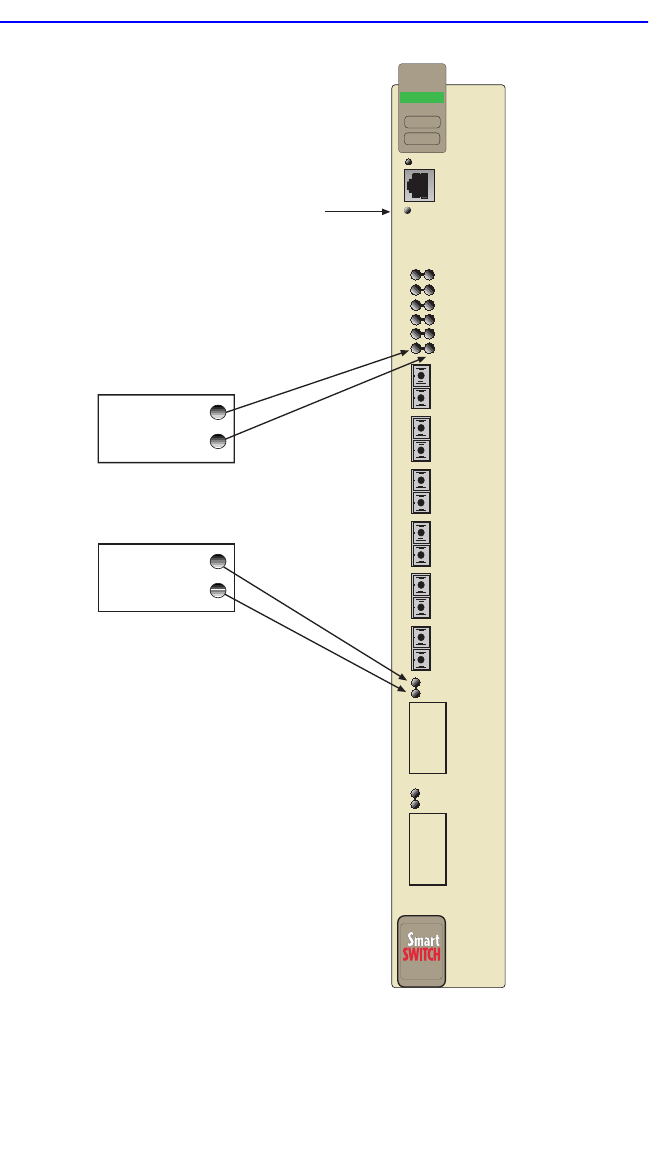
Chapter 4: Troubleshooting
4-2 6H128-08 and 6H129-08 User’s Guide
Figure 4-1 LANVIEW LEDs
2159-07
7
8
COM
CPU
6H128-08
FAST ENET
RESET
CPU LED
Receive (RX)
Transmit (TX)
2
3
4
5
6
1
Receive (RX)
Transmit (TX)
1
2
3
4
5
6

Using LANVIEW
6H128-08 and 6H129-08 User’s Guide 4-3
Table 4-1 LANVIEW LEDs
LED Color State Recommended Action
CPU Off Power off. Power up chassis.
Red Blinking. Hardware
failure has occurred. Contact the Cabletron
Systems Global Call Center.
Solid. Resetting,
normal power up reset. None.
Amber Blinking. Crippled. Contact the Cabletron
Systems Global Call Center.
Solid. Testing. None.
Green Solid. Functional. None.
Amber
and
Green
Booting. Blinks amber
and green while
booting.
None.
RX
(Receive)
LED for
ports 1–6,
also ports
7 and 8,
with
optional
FE-100FX
or
FE-100F3
Off No link. No activity or
port in Standby. Port
enabled or disabled.
None.
Green Solid. Port enabled,
link, no activity. None.
Blinking. Port
disabled, link. None.
Amber Flashing. Port
enabled, link, activity. None.
Red Solid. Diagnostic
failure. Contact the Cabletron
Systems Global Call Center.

Chapter 4: Troubleshooting
4-4 6H128-08 and 6H129-08 User’s Guide
TX
(Transmit)
LED for
ports 1–6,
also ports
7 and 8,
with
optional
FE-100FX
or
FE-100F3
Off Port enabled, and no
activity. Should flash
green every 2 seconds
indicating BPDUs
being sent if STA is
enabled and there is a
valid link.
1. Ensure that the STA is
enabled and that there is a
valid link.
2. If still not working, contact
the Cabletron Systems
Global Call Center.
Green Flashing. Indicates
activity. Rate indicates
data rate.
None.
Amber Blinking. Port in
standby, link.
Port may be disabled
due to Spanning Tree.
1. Ensure that the port is not
disabled (unless desired).
2. If still not working, contact
the Cabletron Systems
Global Call Center.
Red Flashing. Indicates
collision rate. No action, unless a high
amount of activity; check for
network configuration
problems or a bad device.
Solid. Diagnostic
Failure. Contact the Cabletron
Systems Global Call Center.
Table 4-1 LANVIEW LEDs (Continued)
LED Color State Recommended Action
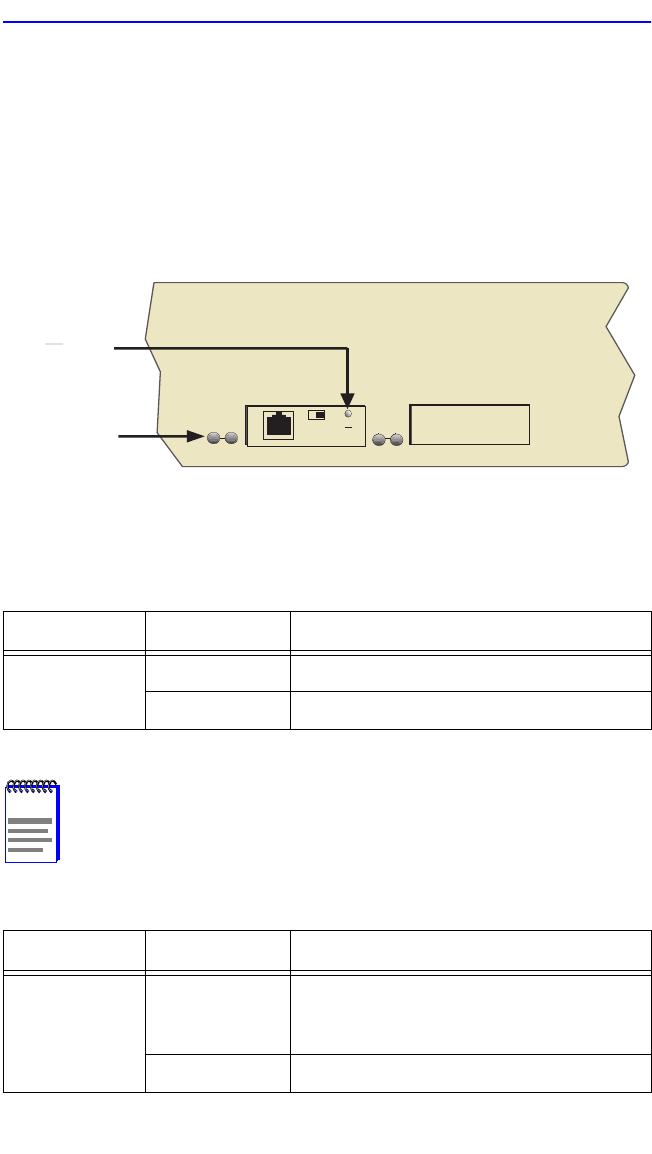
FE-100TX LED
6H128-08 and 6H129-08 User’s Guide 4-5
4.2 FE-100TX LED
The optional FE-100TX for the 6H12X-08 has one LED labeled 10/100.
The 10/100 LED together with the receive LED allows the user to
determine the link status and the operating speed of the Fast Ethernet
Interface Module. The 10/100 LED and the Receive (RX) LED are shown
in Figure 4-2. Table 4-2 and Table 4-3 provide a functional description of
the FE-100TX LED when the RX LED is on or off, respectively.
Figure 4-2 FE-100TX LED
Table 4-2 FE-100TX LED IndicationsWhen the RX LED Is On
Table 4-3 FE-100TX LED Indications When the RX LED Is Off
LED Color Description
10/100 Off FE-100TX is operating at 10 Mbps.
Green FE-100TX is operating at 100 Mbps.
NOTE A link exists if the associated port (port 7or 8) Receive (RX)
LED is on. No link exists if the associated port (port 7 or 8)
Receive (RX) LED is off.
LED Color Description
10/100 Off No Link or no cable attached. FE-100TX is
forced or Auto-Negotiates to 10 Mbps
operation.
Green FE-100TX is operating at 100 Mbps.
Receive (RX)
LED
FE-100TX
10
100
x=
7
8
LED
10
100
2159-08

Chapter 4: Troubleshooting
4-6 6H128-08 and 6H129-08 User’s Guide
4.3 TROUBLESHOOTING CHECKLIST
If the 6H12X-08 is not working properly, refer to Table 4-4 for a checklist
of possible problems, causes, and recommended actions to resolve the
problem.
Table 4-4 Troubleshooting Checklist
Problem Possible Cause Recommended Action
All LEDs are OFF. Loss of Power to the 6C105
chassis. Check the proper
connection of the power
cable and its access to a
live outlet.
The 6H12X-08 not properly
installed. Check the installation. See
Chapter 3.
No Local
Management
Password screen.
Autobaud enabled. Press ENTER (RETURN)
(may take up to four times).
Terminal setup is not
correct. Refer to Chapter 5 for
proper setup procedures.
Improper console cable
pinouts. Refer to Appendix A for
proper console port pinouts.
Cannot contact the
6H12X-08 from
in-band
management.
Improper Community
Names Table. Refer to Chapter 5
for Community Names
Table setup.
The 6H12X-08 does not
have an IP address. Refer to Chapter 5 for IP
address assignment
procedure.
Port is disabled. Enable port.
No link to device. Check link to device.
Port(s) goes into
standby for no
apparent reason.
The 6H12X-08 detects a
looped condition. Review network design and
delete unnecessary loops.
User parameters
(IP address,
Device and
Module name,
etc.) are lost when
the 6H12X-08 is
powered down or
the front panel
RESET button is
pressed.
Mode switch (7), NVRAM
Reset, was changed
sometime before either
cycling power or pressing
the RESET button, causing
the user-entered
parameters to reset to
factory default settings.
Clear NVRAM was set
through Local Management.
Reenter the lost parameters
as necessary.
Call the Cabletron Systems
Global Call Center if
problem persists.
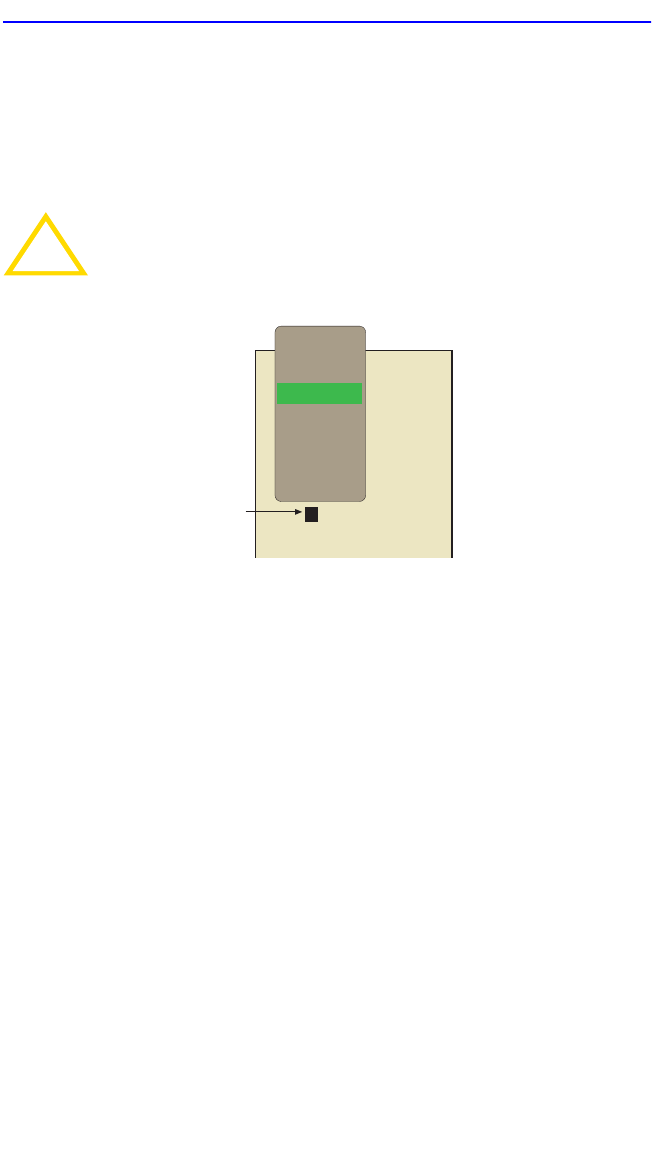
Using the RESET Button
6H128-08 and 6H129-08 User’s Guide 4-7
4.4 USING THE RESET BUTTON
The RESET button located near the upper plastic locking tab of the
module (refer to Figure 4-3) resets the 6H12X-08 processor without
affecting the NVRAM.
Figure 4-3 RESET Button
To reset the 6H12X-08 processor, press and release the RESET button. A
non-conductive tool is recommended for use in pushing the recessed
button. The module processor goes through a reset process lasting
approximately 20 seconds. The module will be unreachable for up to two
minutes as it reenters the network.
!
CAUTION
Pressing the RESET button resets the device, and all current
switching being performed by the device is halted. It may take
up to two minutes for the device to reenter the network.
Reset Button
2159-09
6H128-08
FAST ENET

Chapter 4: Troubleshooting
4-8 6H128-08 and 6H129-08 User’s Guide

6H128-08 and 6H129-08 User’s Guide 5-1
CHAPTER 5
LOCAL MANAGEMENT
This chapter explains how to set up a management terminal to access
6H12X-08 Local Management, and how to use the Local Management
screens and commands. This chapter also provides instructions for
attaching an Uninterruptible Power Supply to the 6H12X-08 using the
Console Cable Kit provided with the 6C105 chassis.
5.1 OVERVIEW
Local Management for the 6H12X-08 consists of a series of screens,
some of which allow the management of the module and the 6C105
chassis, and some that report statistics. The management screens allow
the user to do the following tasks:
•Manage any interface module in the chassis via a connection to a
single interface module.
•Assign IP addresses and subnet masks to the 6H12X-08.
•Assign a default gateway.
•Control access to the 6C105 chassis and the 6H12X-08 module by
establishing community names.
•Download a new image of operating software.
•Designate which Network Management Workstations receive SNMP
traps from the 6H12X-08.
•Configure and have access to any SNMP MIB objects the module
supports.
•Monitor 6C105 chassis environmental information, which includes
power supply redundancy, power supply status, and fan tray status.
•View RMON, switch and interface statistics.
•Assign ports to operate in Auto-Negotiate (optional FE-100TX only),
standard or full duplex mode.
•Configure SmartTrunk ports to perform load sharing.

Chapter 5: Local Management
5-2 6H128-08 and 6H129-08 User’s Guide
•Configure optional Fast Ethernet Interface Modules installed in the
6H12X-08.
•Clear NVRAM.
There are three ways to access Local Management:
•Locally using a VT type terminal connected to the COM port of the
6H12X-08.
•Remotely using a VT type terminal connected through a modem.
•In-band via a Telnet connection.

Local Management Keyboard Conventions
6H128-08 and 6H129-08 User’s Guide 5-3
5.2 LOCAL MANAGEMENT KEYBOARD
CONVENTIONS
All key names appear as capital letters in this manual. Table 5-1 explains
the keyboard conventions and the key functions that are used.
Table 5-1 Keyboard Conventions
Key Function
ENTER Key
RETURN Key
These are selection keys that perform the same
Local Management function. For example, “Press
ENTER” means that you can press either ENTER
or RETURN, unless this manual specifically
instructs you otherwise.
ESCAPE (ESC) Key
This key allows an escape from a Local
Management screen without saving changes. For
example, “Press ESC twice” means the ESC key
must be pressed quickly two times.
SPACE bar
BACKSPACE Key
These keys cycle through selections in some Local
Management fields. Use the SPACE bar to cycle
forward through selections and use BACKSPACE
to cycle backward through selections.
Arrow Keys
These are navigation keys. Use the UP-ARROW,
DOWN-ARROW, LEFT-ARROW, and
RIGHT-ARROW keys to move the screen cursor.
For example, “Use the arrow keys” means to press
whichever arrow key moves the cursor to the
desired field on the Local Management screen.
[–] Key This key decreases values from a Local
Management increment field. For example, “Press
[–]” means to press the minus sign key.
DEL Key The DEL (Delete) key removes characters from a
Local Management field. For example, “Press DEL”
means to press the Delete key.

Chapter 5: Local Management
5-4 6H128-08 and 6H129-08 User’s Guide
5.3 MANAGEMENT TERMINAL SETUP
Use one of the following systems to access Local Management:
•An IBM or compatible PC running a VT series emulation software
package
•A Digital Equipment Corporation VT100 type terminal
•A VT type terminal running emulation programs for the Digital
Equipment Corporation VT100 series
•A remote VT100 type terminal via a modem connection
•In-band via a Telnet connection
5.3.1 Console Cable Connection
Use the Console Cable Kit provided with the 6C105 chassis to attach the
management terminal to the COM port as shown in Figure 5-1.
Connect an IBM PC or compatible device, running VT terminal
emulation, to the 6H12X-08 as follows:
1. Connect the RJ45 connector at one end of the cable (supplied in the
kit) to the COM port on the 6H12X-08.
2. Plug the RJ45 connector at the other end of the cable into the
RJ45-to-DB9 adapter (supplied in the kit).
3. Connect the RJ45-to-DB9 adapter to the communications port on the
terminal/PC.
NOTE If using a DEC VT style terminal, use the DB25 adapter for this
device instead of the DB9 adapter.
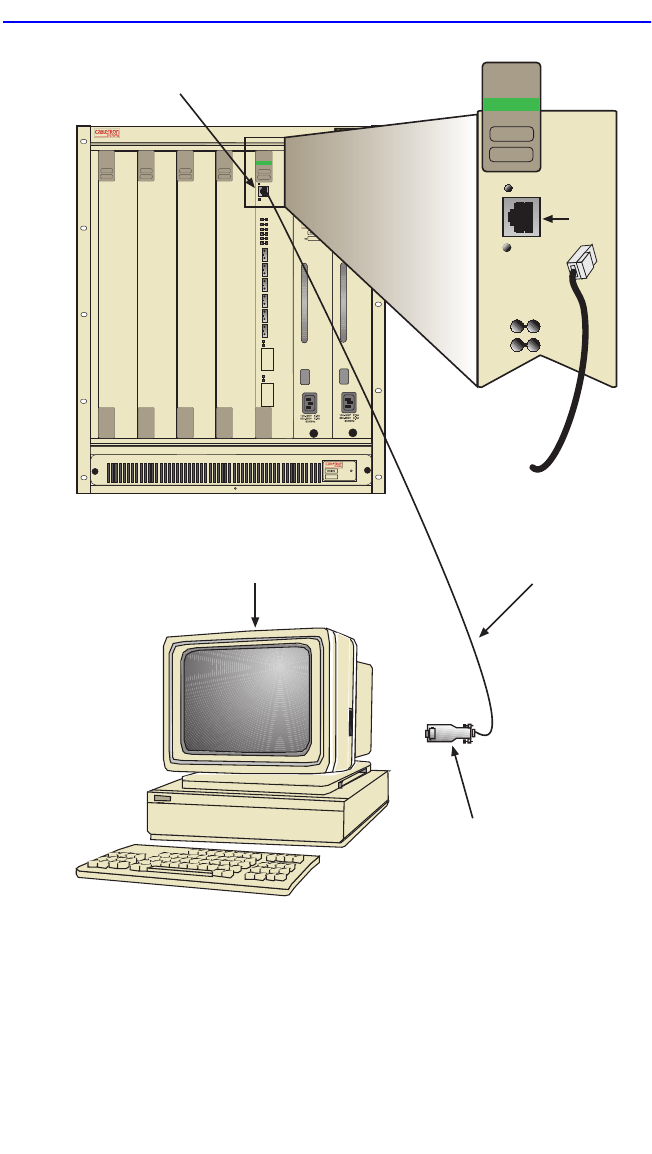
Management Terminal Setup
6H128-08 and 6H129-08 User’s Guide 5-5
Figure 5-1 Management Terminal Connection
2364-10
12345
PS1 PS2
FAST ENET
2
1
7
8
6E128-08
ETHERNET
COM
CPU
2
3
4
5
6
1
RESET
COM
Port
6H128-08
CPU
RESET
PC
RJ45 COM Port
RJ45-to-DB9
PC Adapter to PC
UTP Cable with
RJ45 Connectors
1
2
3
4
5
6

Chapter 5: Local Management
5-6 6H128-08 and 6H129-08 User’s Guide
5.3.2 Management Terminal Setup Parameters
Table 5-2 lists the setup parameters for the local management terminal.
Table 5-2 VT Terminal Setup
Display Setup Menu
Columns ->
Controls ->
Auto Wrap ->
Scroll ->
Text Cursor ->
Cursor Style ->
80 Columns
Interpret Controls
No Auto Wrap
Jump Scroll
Cursor
Underline Cursor Style
General Setup Menu
Mode ->
ID number ->
Cursor Keys ->
Power Supply ->
VT100, 7 Bit Controls
VT100ID
Normal Cursor Keys
UPSS DEC Supplemental
Communications Setup Menu
Transmit ->
Receive ->
XOFF ->
Bits ->
Parity ->
Stop Bit ->
Local Echo ->
Port ->
Transmit ->
Auto Answerback ->
2400, 4800, 9600, 19200
Receive=Transmit
XOFF at 64
8 bits
No Parity
1 Stop Bit
No Local Echo
DEC-423, Data Leads Only
Limited Transmit
No Auto Answerback
Keyboard Setup Menu
Keys ->
Auto Repeat ->
Keyclick ->
Margin Bell ->
Warning Bell ->
Typewriter Keys
any option
any option
Margin Bell
Warning Bell

Management Terminal Setup
6H128-08 and 6H129-08 User’s Guide 5-7
5.3.3 Telnet Connections
Once the module or chassis has a valid IP address, the user can establish a
Telnet session with Local Management from any TCP/IP based node on
the network. Telnet connections to the 6H12X-08 require the community
name passwords assigned at the SNMP Community Names screen of
either the 6C105 chassis or the module. For additional information about
community names, refer to Section 5.8. Refer to the instructions included
with the Telnet application for information about establishing a Telnet
session.
5.3.4 Monitoring an Uninterruptible Power Supply
If the 6C105 chassis is connected to an American Power Conversion
(APC) Uninterruptible Power Supply (UPS) device for protection against
the loss of power, a connection from the 6H12X-08 COM port to the UPS
can be made to monitor the power status of the UPS. To use the COM port
for this purpose, it must be reconfigured to support the UPS connection
using the procedure described in Section 5.15.11. Refer to the UPS
documentation for details on how to access the status information.
The Console Cable Kit provided with the 6H12X-08 is used to attach the
UPS to the 6H12X-08 COM port as shown in Figure 5-2.
To connect the UPS device to the COM port of the 6H12X-08, proceed as
follows:
1. Connect the RJ45 connector at one end of the cable to the COM port
on the module.
2. Plug the RJ45 connector at the other end of the cable into the
RJ45-to-DB9 male (UPS) adapter, Cabletron Systems Part No.
9372066.
3. Connect the RJ45-to-DB9 male (UPS) adapter to the female DB9 port
on the rear of the UPS device (see the particular UPS device’s user
instructions for more specific information about the monitoring
connection).
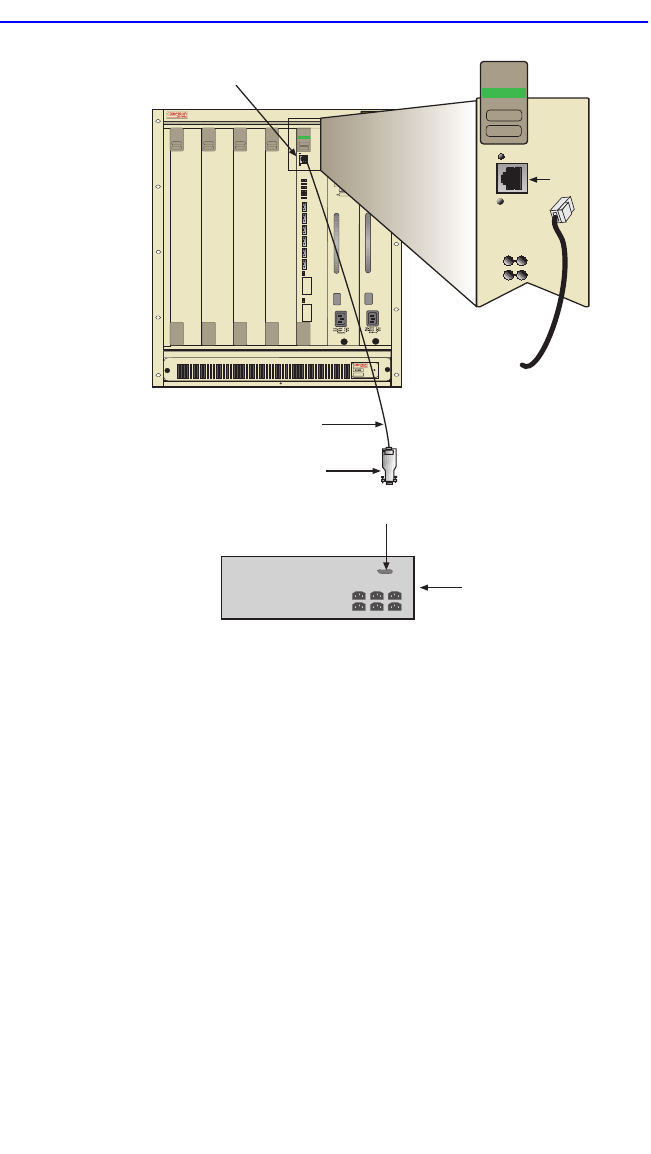
Chapter 5: Local Management
5-8 6H128-08 and 6H129-08 User’s Guide
Figure 5-2 Uninterruptible Power Supply (UPS) Connection
5.4 ACCESSING LOCAL MANAGEMENT
Access to Local Management is controlled through the Local
Management Password screen, Figure 5-3. Whenever a connection is
made to the 6H12X-08 the Local Management Password screen displays.
Before continuing, the user must enter a password which is compared to
the previously stored passwords. The level of access allowed the user
depends on the password. To set or change passwords refer to Section 5.8.
The following steps describe the procedure to access Local Management.
1. Turn on the terminal. Press ENTER (up to four times) until the 6C105
Local Management Password screen displays. You may have to press
the ENTER key up to four times to allow the COM port to auto-sense
the baud rate.
2364_5
12345
PS1 PS2
FAST ENET
CPU
2
1
RESET
7
8
6E128-08
ETHERNET
COM
CPU
2
3
4
5
6
1
RESET
COM
Port
6H128-08
DB9 Port
RJ45 COM Port
RJ45-to-DB9
PC Adapter
UTP Cable with
RJ45 Connectors
UPS Device
1
2
3
4
5
6

Accessing Local Management
6H128-08 and 6H129-08 User’s Guide 5-9
Figure 5-3 Local Management Password Screen
2. Enter the Password and press ENTER. The default super-user access
password is “public” or press ENTER.
•If an invalid password is entered, the terminal beeps and the cursor
returns to the beginning of the password entry field.
•Entering a valid password causes the associated access level to
display at the bottom of the screen and the Main Menu screen to
appear.
•If no activity occurs for several minutes, the Password screen
reappears and the session ends.
NOTE The super-users password is one of the community names
specified in the SNMP Community Names screen. Access to
certain Local Management capabilities depends on the degree
of access accorded that community name. Refer to
Section 5.8.
6C105 LOCAL MANAGEMENT
CABLETRON Systems, Incorporated
P.O.Box 5005
Rochester, NH 03866-5005 USA
(603) 332-9400
(c) Copyright CABLETRON Systems, Inc, 1997
Enter Password:
1960_12
Event Message Line

Chapter 5: Local Management
5-10 6H128-08 and 6H129-08 User’s Guide
5.4.1 Navigating Local Management Screens
The 6H12X-08 Local Management application consists of a series of
menu screens. Navigate through Local Management by selecting items
from the menu screens.
The 6H12X-08 supports three modes of switch operation.
The switching modes are as follows:
•802.1D SWITCHING (traditional switching)
•802.1Q SWITCHING (802.1Q port based VLANS)
•SECURE FAST VLAN (Cabletron Systems SecureFast Switching)
The switch operational mode may be set in either the Chassis
Configuration screen, Section 5.7, or the General Configuration screen,
Section 5.15, of the module. Depending on the Operational Mode set for
the module, the hierarchy of Local Management screens differs as shown
in Figure 5-4, Figure 5-5, and Figure 5-6. Refer to the applicable Local
Management screen hierarchy that relates to the Operational Mode to be
set for the module.
NOTE Refer to the Release Notes shipped with the product to verify
which screens are supported in each of the three available
switching modes.
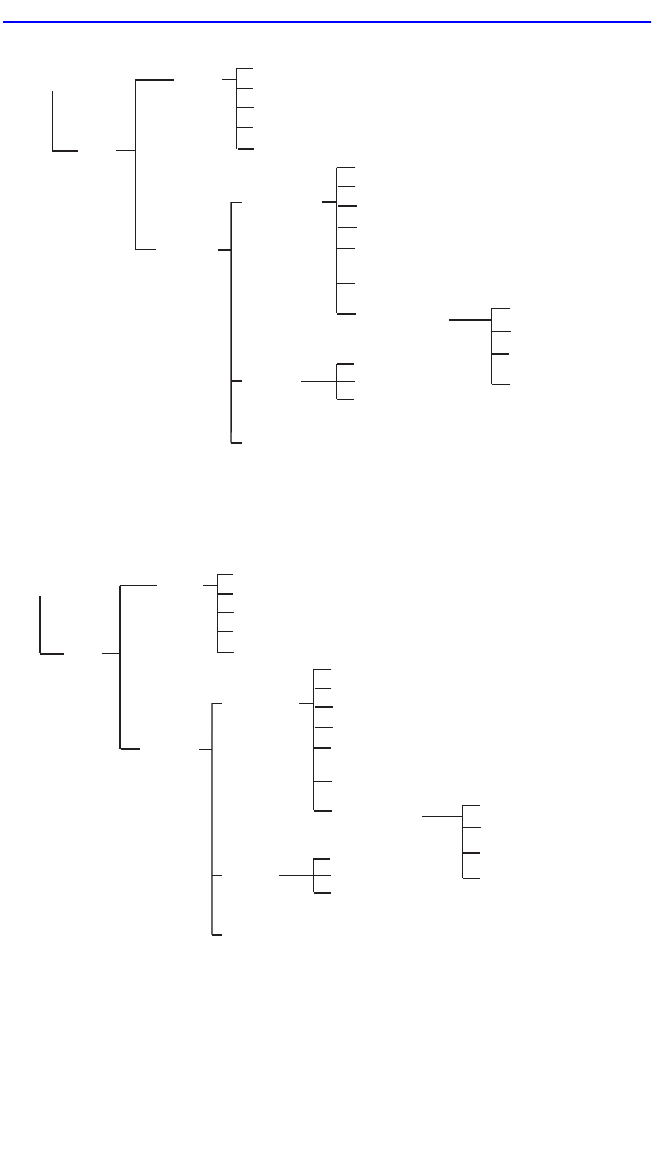
Accessing Local Management
6H128-08 and 6H129-08 User’s Guide 5-11
\
Figure 5-4 802.1D Switching Mode, LM Screen Hierarchy
Figure 5-5 802.1Q Switching Mode, LM Screen Hierarchy
Module
Configuration
Menu
2364_43
Module Specific
Configuration
Network Tools
SmartTrunk
Configuration
Port Redirect
Function
System
Resources
Flash Download
Broadcast
Suppression
Module
Statistics
Menu
Switch Statistics
RMON Statistics
Interface Statistics
Chassis
Menu
Modules
Menu
Password
Main
Menu General Configuration
SNMP Community Names
SNMP Traps
Switch Configuration
Ethernet Interface
Configuration
Chassis Configuration
SNMP Community Names
SNMP Traps
Chassis Environmental
Port Redirect Function
Module
Configuration
Menu
2364_44
Module Specific
Configuration
Network Tools
SmartTrunk
Configuration
System
Resources
Flash Download
Broadcast
Suppression
Module
Statistics
Menu
Switch Statistics
RMON Statistics
Interface Statistics
Chassis
Menu
Modules
Menu
Password
Main
Menu General Configuration
SNMP Community Names
SNMP Traps
Switch Configuration
Ethernet Interface
Configuration
Chassis Configuration
SNMP Community Names
SNMP Traps
Chassis Environmental
802.1Q VLAN Configuration
802.1Q VLAN Configuration

Chapter 5: Local Management
5-12 6H128-08 and 6H129-08 User’s Guide
\
Figure 5-6 SecureFast VLAN Mode, LM Screen Hierarchy
5.4.2 Selecting Local Management Menu Screen Items
Select items on a menu screen by performing the following steps:
1. Use the arrow keys to highlight a menu item.
2. Press ENTER. The selected menu item displays on the screen.
5.4.3 Exiting Local Management Screens
Exit Local Management using the methods described below:
Using the EXIT Command
1. Use the arrow keys to highlight the EXIT command at the bottom of
the Local Management Screen.
2. Press ENTER. The Password screen displays and the session ends.
Module
Configuration
Menu
2364_45
Module Specific
Configuration
Network Tools
System
Resources
Flash Download
Module
Statistics
Menu RMON Statistics
Interface Statistics
Chassis
Menu
Modules
Menu
Password
Main
Menu General Configuration
SNMP Community Names
SNMP Traps
Ethernet Interface
Configuration
Chassis Configuration
SNMP Community Names
SNMP Traps
Chassis Environmental

Accessing Local Management
6H128-08 and 6H129-08 User’s Guide 5-13
Using the RETURN Command
1. Use the arrow keys to highlight the RETURN command at the bottom
of the Local Management screen.
2. Press ENTER. The previous screen in the Local Management
hierarchy displays.
3. Exit from 6H12X-08 Local Management by repeating steps 1 and 2
until the Main Menu screen displays.
4. Use the arrow keys to highlight the RETURN command at the bottom
of the Main Menu screen.
5. Press ENTER. The Password screen displays and the session ends.
NOTE The user can also exit Local Management screens by pressing
ESC twice. This exit method does not warn about unsaved
changes and all unsaved changes will be lost.

Chapter 5: Local Management
5-14 6H128-08 and 6H129-08 User’s Guide
5.5 THE MAIN MENU SCREEN
The Main Menu screen is the access point for all Local Management
screens for the module and the 6C105 chassis. Figure 5-7 shows the Main
Menu screen.
Figure 5-7 Main Menu Screen
The following explains each Main Menu screen menu item as shown in
Figure 5-7:
CHASSIS
The Chassis menu item provides access to the Chassis Menu screen,
shown in Figure 5-8, which is used to configure the 6C105 chassis and
access current chassis power supply and environmental status. For details
about the Chassis Menu screen, refer to Section 5.6.
MODULES
The Modules menu item provides access to the Module Selection screen
that is used to select individual modules in the chassis for management
purposes. For details about the Module Selection screen, refer to
Section 5.12.
Main Menu
2269_91
6C105 LOCAL MANAGEMENT
CHASSIS
EXIT
MODULES
RETURN

Chassis Menu Screen
6H128-08 and 6H129-08 User’s Guide 5-15
5.6 CHASSIS MENU SCREEN
The Chassis Menu screen, Figure 5-8, provides access to Local
Management screens that allow you to configure and monitor operating
parameters, modify SNMP community names, set SNMP traps, monitor
the 6C105 environmental status, and perform port redirect functions, and
to configure the 6C105 for IEEE 802.1Q operation.
To access the Chassis Configuration screen, use the arrow keys to
highlight the CHASSIS menu item and press ENTER. The Chassis
Configuration screen displays.
Figure 5-8 Chassis Menu Screen
The following briefly explains each screen accessible from the Chassis
Configuration screen:
CHASSIS CONFIGURATION
The Chassis Configuration screen allows the user to configure operating
parameters for the 6C105 chassis. For details, refer to Section 5.7.
Chassis Menu
CHASSIS CONFIGURATION
2269_99
6C105 LOCAL MANAGEMENT
RETURN
SNMP COMMUNITY NAMES
SNMP TRAPS
CHASSIS ENVIRONMENTAL
PORT REDIRECT FUNCTION
802.1Q VLAN CONFIGURATION
EXIT

Chapter 5: Local Management
5-16 6H128-08 and 6H129-08 User’s Guide
SNMP COMMUNITY NAMES
The SNMP Community Names screen allows the user to enter new,
change, or review the community names used as access passwords for
device management operation. Access is limited based on the password
level of the user. For details, refer to Section 5.8.
SNMP TRAPS
The SNMP Traps screen provides display and configuration access to the
table of IP addresses used for trap destinations and associated community
names. For details, refer to Section 5.9.
CHASSIS ENVIRONMENTAL
The Chassis Environmental Information screen provides access to chassis
power supply status, power supply redundancy status and chassis fan tray
status. For details, refer to Section 5.10.
PORT REDIRECT FUNCTION
The Port Redirect Function screen allows the user to redirect traffic from
one or multiple modules and ports in the chassis to a specific destination
module or port. For details, refer to Section 5.11.
802.1Q VLAN CONFIGURATION
This menu option will only display if one or more modules installed in the
chassis have been configured to operate as IEEE 802.1Q switches. When
selected, this menu item opens the VLAN Main Menu screen. For details,
refer to the Cabletron Systems Port Based VLAN User’s Guide. Refer to
Section 5.15.9 for information on setting the Operational Mode field to
configure the modules to function as 802.1Q switches.

Chassis Configuration Screen
6H128-08 and 6H129-08 User’s Guide 5-17
5.7 CHASSIS CONFIGURATION SCREEN
The Chassis Configuration screen, Figure 5-9, allows the user to set the
chassis date and time, screen refresh and lockout time, IP address, subnet
mask, the Operational Mode of all modules installed in the chassis, and to
view the chassis uptime.
Access the Chassis Configuration screen from the Chassis Menu screen
by using the arrow keys to highlight the CHASSIS CONFIGURATION
menu item and pressing ENTER. The Chassis Configuration screen,
Figure 5-9, displays.
Figure 5-9 Chassis Configuration Screen
The following briefly explains each Chassis Configuration screen field:
MAC Address (Read-Only)
Displays the physical address of the chassis.
IP Address (Modifiable)
This field allows the IP address to be set for the 6C105 chassis. If an IP
address is assigned to the 6C105 chassis all the interface modules
installed in the chassis can be managed via this IP address, eliminating the
need to assign an IP address to each interface module. To set the IP
address, refer to Section 5.7.1.
Chassis Configuration
2159-41
MAC Address:
IP Address:
Subnet Mask:
Chassis Date:
Chassis Time:
Screen Refresh Time:
Screen Lockout Time:
Operational Mode: [802.1D SWITCHING]
Chassis Uptime XX D XX H XX M
00-00-ID-00-00-00
000.000.000.000
000.000.000.000
6C105 LOCAL MANAGEMENT
Event Message Line
RETURNSAVE
10/11/1997
14:23:00
30 sec
15 min
EXIT

Chapter 5: Local Management
5-18 6H128-08 and 6H129-08 User’s Guide
Subnet Mask (Read-Only)
Displays the subnet mask for the chassis. A subnet mask “masks out” the
network bits of the IP address by setting the bits in the mask to 1 when the
network treats the corresponding bits in the IP address as part of the
network or subnetwork address, or to 0 if the corresponding bit identifies
the host. The 6C105 chassis automatically uses the default subnet mask
that corresponds to the IP class that was entered in the IP address field.
For details about how to change the Subnet Mask from its default value,
refer to Section 5.7.2.
Chassis Date (Modifiable)
Contains a value that the chassis recognizes as the current date. When the
chassis date is modified and saved all interface modules installed in the
chassis are set to this date. To set a new chassis date, refer to
Section 5.7.3.
Chassis Time (Modifiable)
Contains a value that the chassis recognizes as the current time. When the
chassis time is modified and saved, all interface modules installed in the
chassis are set to this time. To enter a new time, refer to Section 5.7.4.
Screen Refresh Time (Modifiable)
Contains the rate at which the screens are updated. This setting
determines how frequently (in seconds) information is updated on the
screen. To enter a new update time, refer to Section 5.7.5.
NOTE When a valid IP address is assigned, the Subnet Mask field
automatically enters the default mask that corresponds with the
class of IP entered in the IP Address field. Some firmware
revisions do support changing the chassis subnet mask from
the default value. Refer to the Release Notes to ensure that the
Subnet Mask is a modifiable field.

Chassis Configuration Screen
6H128-08 and 6H129-08 User’s Guide 5-19
Screen Lockout Time (Modifiable)
Contains the maximum number of minutes that the Local Management
application displays a module’s screen while awaiting input or action
from a user. For example, if the number 5 is entered in this field, the user
has up to five minutes to respond to each of the specified module’s Local
Management screens. In this example, after five minutes of “idleness” (no
input or action), the terminal “beeps” five times, the Local Management
application terminates the session, and the display returns to the Password
screen. To enter a new lockout time, refer to Section 5.7.6.
Chassis Uptime (Read-Only)
Displays the total time the chassis has been operating. The chassis uptime
is based on which interface module installed in the chassis has been
operating for the longest period of time.
Operational Mode (Toggle)
This field allows the user to set all the modules in the chassis to operate as
traditional switches (802.1D SWITCHING option), or as IEEE 802.1Q
switches (802.1Q SWITCHING option).
In 802.1D SWITCHING mode, the six ports located on the front panel
and each optional Fast Ethernet Interface Module are bridged to each
other.
When the operational mode is set to 802.1Q SWITCHING, the
6H12X-08 acts as an IEEE 802.1Q switch. The modules are able to
increase their switching functionality by creating and maintaining port
based Virtual LANs (VLANs).
This field will display the existing status of the chassis the first time the
screen displays. If modules in the chassis are set to different operational
modes, then the first time this field displays, it will display “MIXED
MODE”. Once the user has entered the field using the arrow keys, it will
then display only the operational mode choices available.
For details on how to select the Operational Mode, refer to Section 5.7.7

Chapter 5: Local Management
5-20 6H128-08 and 6H129-08 User’s Guide
5.7.1 Setting the IP Address
To set the IP address, perform the following steps:
1. Use the arrow keys to highlight the IP Address field.
2. Enter the IP address into this field using Decimal Dotted Notation
(DDN) format.
For example: 134.141.79.120
3. Press ENTER. If the IP address is a valid format, the cursor returns to
the beginning of the IP address field. If the entry is not valid, the Event
Message Line displays “INVALID IP ADDRESS OR FORMAT
ENTERED”. Local Management does not alter the current value and
refreshes the IP address field with the previous value.
4. Use the arrow keys to highlight the SAVE command, then press
ENTER. The “SAVED OK” message displays indicating that the
changes have been saved to memory.
5.7.2 Setting the Subnet Mask
If the management workstation that is to receive SNMP traps from the
6C105 is located on a separate subnet, the subnet mask for the 6C105
must be changed from its default.
To change the subnet mask from its default, perform the following steps:
1. Use the arrow keys to highlight the Subnet Mask field.
2. Enter the subnet mask into this field using Decimal Dotted Notation
(DDN) format.
For example: 255.255.255.0
NOTE When a valid IP address is assigned, the Subnet Mask field
automatically enters the default mask that corresponds with the
class of IP entered in the IP Address field. Some firmware
revisions do support changing the chassis subnet mask from
the default value. Refer to your Release Notes to ensure that
the Subnet Mask is a modifiable field.
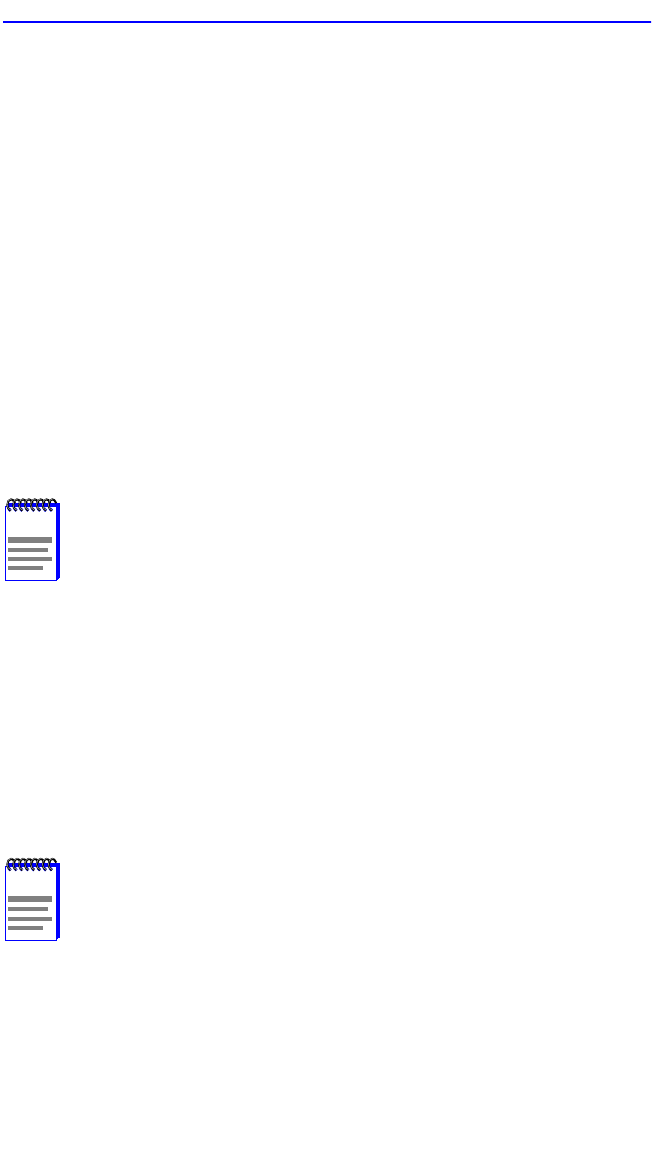
Chassis Configuration Screen
6H128-08 and 6H129-08 User’s Guide 5-21
3. Press ENTER. If the subnet mask is valid, the cursor returns to the
beginning of the Subnet Mask field. If the entry is not valid, the Event
Message Line displays “INVALID SUBNET MASK OR FORMAT
ENTERED”. Local Management does not alter the current value, but
it does refresh the Subnet Mask field with the previous value.
4. Use the arrow keys to highlight the SAVE command, then press
ENTER. The Event Message Line at the top of the screen displays
“SAVED OK”, and the changes are saved to memory.
5.7.3 Setting the Chassis Date
The 6C105 is year 2000 compliant. This allows the date to be set beyond
the year 1999. To set the chassis date, perform the following steps:
1. Use the arrow keys to highlight the Chassis Date field.
2. Enter the date using this format: MM/DD/YYYY.
3. Press ENTER to set the system calendar to the date in the input field.
4. Use the arrow keys to highlight the SAVE command at the bottom of
the screen and press ENTER.
If the date entered is a valid format, the Event Message Line at the top of
the screen displays “SAVED OK”. If the entry is not valid, Local
Management does not alter the current value, but it does refresh the
Chassis Date field with the previous value.
NOTE It is not necessary to add separators between month, day, and
year numbers. For example, to set the date to 03/17/1997, type
“03171997” in the Chassis Date field.
NOTE Upon saving the new chassis date, all interface modules
installed in the chassis recognize the new value as the current
date.
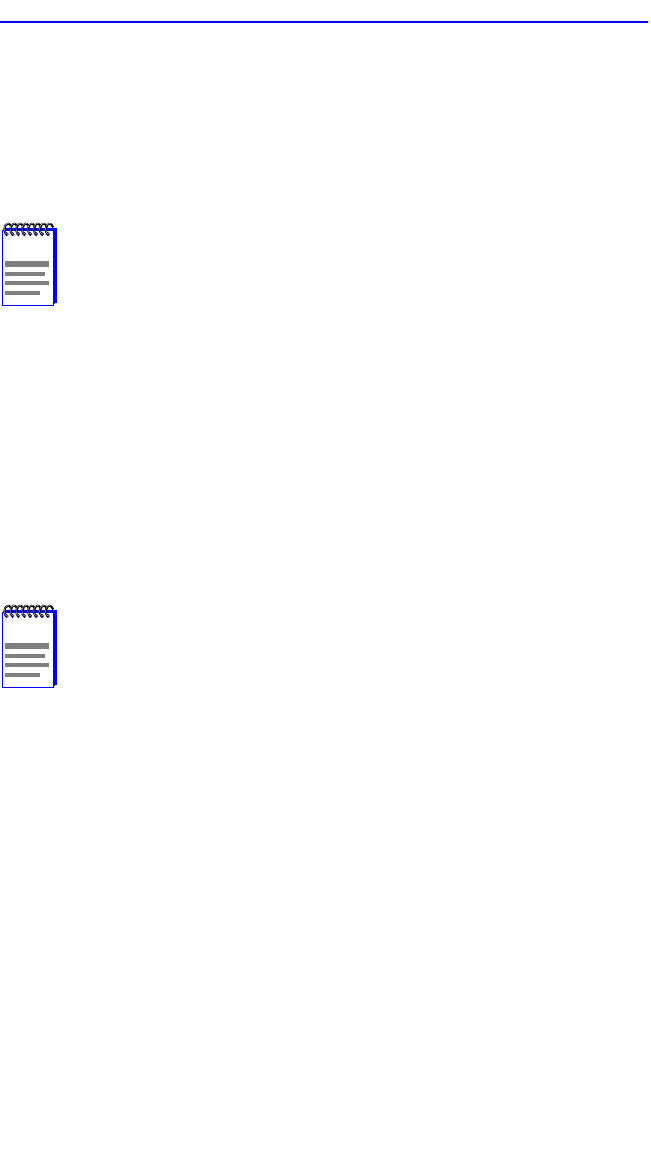
Chapter 5: Local Management
5-22 6H128-08 and 6H129-08 User’s Guide
5.7.4 Setting the Chassis Time
To set the chassis time, perform the following steps:
1. Use the arrow keys to highlight the Chassis Time field.
2. Enter the time in a 24-hour format: HH:MM:SS.
3. Press ENTER to set the chassis clock to the time in the input field.
4. Use the arrow keys to highlight the SAVE command at the bottom of
the screen and press ENTER.
If the time entered is in a valid format, the Event Message Line at the top
of the screen displays “SAVED OK”. If the entry is not valid, Local
Management does not alter the current value and refreshes the Chassis
Time field with the previous value.
5.7.5 Entering a New Screen Refresh Time
The screen refresh time is set from 3 to 99 seconds with a default of 3
seconds. To set a new screen refresh time, perform the following steps:
1. Use the arrow keys to highlight the Screen Refresh Time field.
2. Enter a number from 3 to 99.
3. Press ENTER to set the refresh time to the time entered in the input
field.
NOTE When entering the time in the chassis time field, separators
between hours, minutes, and seconds do not need to be added
as long as each entry uses two numeric characters. For
example, to set the time to 6:45 A.M., type “064500” in the
Chassis Time field.
NOTE Upon saving the new chassis time, all interface modules
installed in the chassis recognize the new value as the current
time.

Chassis Configuration Screen
6H128-08 and 6H129-08 User’s Guide 5-23
4. Use the arrow keys to highlight the SAVE command at the bottom of
the screen and press ENTER.
If the time entered is within the 3 to 99 seconds range, the Event Message
Line at the top of the screen displays “SAVED OK”. If the entry is not
valid, Local Management does not alter the current setting, but it does
refresh the Screen Refresh Time field with the previous value.
5.7.6 Setting the Screen Lockout Time
The screen lockout time can be set from 1 to 30 minutes with a default of
15 minutes. To set a new lockout time, perform the following steps:
1. Use the arrow keys to highlight the Screen Lockout field.
2. Enter a number from 1 to 30.
3. Press ENTER to set the lockout time in the input field.
4. Use the arrow keys to highlight the SAVE command at the bottom of
the screen and press ENTER.
If the time entered is within the 1 to 30 minutes range, the Event Message
Line at the top of the screen displays “SAVED OK”. If the entry is not
valid, Local Management does not alter the current setting, but it does
refresh the Screen Lockout Time field with the previous value.
5.7.7 Setting the Operational Mode
This field will come up with the current Operational Mode status of the
chassis when the screen is initially viewed. It will show “MIXED” if
modules in the chassis are set to different operational modes. Once the
user has entered the field and toggled it, it becomes a modifiable field and
does not show status again unless the screen is exited and reentered. The
options are 802.1D SWITCHING and 802.1Q SWITCHING. To change
the mode of switching, perform the following steps:
To set the Operational Mode, proceed as follows:
1. Use the arrow keys to highlight the Operational Mode field.
2. Press the SPACE bar to step to the appropriate operation mode, either
802.1D SWITCHING or 802.1Q SWITCHING.

Chapter 5: Local Management
5-24 6H128-08 and 6H129-08 User’s Guide
3. Use the arrow keys to highlight the SAVE command at the bottom of
the screen and press ENTER. The warning screen in Figure 5-10
displays:
Figure 5-10 Operational Mode Warning Screen
4. Use the arrow keys to highlight the YES command and press ENTER.
The changes are saved, and all the modules installed in the chassis
reboot.
NOTE If the 6H12X-08 have been set to 802.1Q SWITCHING, refer to
your
Port Based VLAN User’s Guide
to configure the devices
for this type of operation.
The Operational Mode field in the Chassis Configuration
screen does not support the SECURE FAST VLAN operational
mode. For the modules to function as SecureFast switches,
they must have a unique IP addresses, and be configured to
act as standalone devices in terms of Local Management via
the 6C105 chassis. Section 5.15.9 provides additional
instructions that must be performed before configuring the
modules as SecureFast switches.
WARNING!
1666
YOU HAVE ELECTED TO SAVE THE OPERATIONAL MODE FOR
THE WHOLE CHASSIS. THIS WILL CAUSE ALL OF THE
BOARDS IN THE CHASSIS TO REBOOT.
ARE YOU SURE YOU WANT TO SAVE THE NEW OPERATIONAL MODE
Event Message Line
NOYES

SNMP Community Names Screen
6H128-08 and 6H129-08 User’s Guide 5-25
5.8 SNMP COMMUNITY NAMES SCREEN
The SNMP Community Names screen allows the user to set community
names. Community names act as passwords to Local/Remote
Management and determine the level of security access to the 6C105.
Access to the 6C105 is controlled by enacting any of three different levels
of security authorization (read-only, read-write, and super-user).
Access the SNMP Community Names screen from the Chassis Menu
screen by using the arrow keys to highlight the SNMP COMMUNITY
NAMES menu item and pressing ENTER. The SNMP Community
Names screen, Figure 5-11, displays.
Figure 5-11 SNMP Community Names Screen
NOTE Super-User access gives the user full management privileges,
allows existing Community Names to be changed, and all
modifiable MIB objects for the Cabletron Container MIB and
Internet MIB-II to be edited.
SNMP Community Names
Access Policy
read-only
read-write
super-user
6C105 LOCAL MANAGEMENT
Event Message Line
RETURNSAVE
Community Name
public
public
public
2159-35
EXIT

Chapter 5: Local Management
5-26 6H128-08 and 6H129-08 User’s Guide
The following explains each SNMP Community Names screen field:
Community Name (Modifiable)
Displays the user-defined name through which a user accesses 6C105
management. Any community name assigned here acts as a password to
Local/Remote Management.
Access Policy (Read-Only)
Indicates the access accorded each community name. Possible selections
are as follows:
read-only This community name allows read-only access
to the 6C105 MIB objects, and excludes access
to security-protected fields of read-write or
super-user authorization.
read-write This community name allows read and write
access to the 6C105 MIB objects, excluding
security protected fields for super-user access
only.
super-user This community name permits read-write
access to the 6C105 MIB objects and allows the
user to change all modifiable parameters
including community names, IP addresses,
traps, and SNMP objects.

SNMP Community Names Screen
6H128-08 and 6H129-08 User’s Guide 5-27
5.8.1 Establishing Community Names
The password used to access Local Management at the Password screen
must have super-user access in order to view and edit the SNMP
Community Names screen. Using a community name with read-only or
read-write access does not allow the user to view or edit the SNMP
Community Names screen.
To establish community names, proceed as follows:
1. Use the arrow keys to highlight the Community Name field adjacent
to the selected access level.
2. Enter the password in the field (maximum 31 characters).
3. Press ENTER.
4. Repeat steps 1 through 3 to modify the other community names.
5. Use the arrow keys to highlight SAVE at the bottom of the screen and
press ENTER. The message “SAVED OK” displays. The community
names are saved to memory and their access modes implemented.
NOTE Any community name assigned in the SNMP Community
Names screen acts as a password to its corresponding level of
access to Local Management. The community name assigned
super-user access is the only one that gives the user complete
access to Local Management.
NOTE All passwords assigned in the 6C105 SNMP Community
Names screen allow access to both 6C105 Local Management
screens, and the Local Management screens of the interface
modules that are installed in the chassis. To configure the
interface module to not allow access to 6C105 Local
Management screens, refer to Section 5.16.
NOTE Exiting without saving causes a “NOT SAVED--PRESS SAVE
TO KEEP CHANGES” message to display in the top left of the
screen. Edits will be lost if they are not saved before exiting.

Chapter 5: Local Management
5-28 6H128-08 and 6H129-08 User’s Guide
5.9 SNMP TRAPS SCREEN
Since the 6C105 is an SNMP compliant device, it can send messages to
multiple Network Management Stations to alert users of status changes.
The Chassis SNMP Traps screen is shown in Figure 5-12.
Access the Chassis SNMP Traps screen from the Chassis Menu screen by
using the arrow keys to highlight the SNMP TRAPS menu item and
pressing ENTER. The Chassis SNMP Traps screen displays.
Ch
Figure 5-12 Chassis SNMP Traps Screen
The following explains each field of the SNMP Traps screen:
Trap Destination (Modifiable)
Indicates the IP address of the workstation to receive trap alarms. Up to
eight different destinations can be defined.
Trap Community Name (Modifiable)
Displays the community name included in the trap message sent to the
Network Management Station with the associated IP address.
Chassis SNMP Traps
2159-36
Trap Community Name
public
public
public
public
public
public
public
public
EXIT
6C105 LOCAL MANAGEMENT
Event Message Line
RETURNSAVE
Trap Destination
0.0.0.0
0.0.0.0
0.0.0.0
0.0.0.0
0.0.0.0
0.0.0.0
0.0.0.0
0.0.0.0
Enable Traps
[YES]
[YES]
[YES]
[YES]
[NO]
[NO]
[NO]
[NO]

SNMP Traps Screen
6H128-08 and 6H129-08 User’s Guide 5-29
Enable Traps (Toggle)
Enables transmission of the traps to the network management station with
the associated IP address. This field toggles between YES and NO.
5.9.1 Configuring the Trap Table
To configure the Trap table, proceed as follows:
1. Using the arrow keys, highlight the appropriate Trap Destination
field.
2. Enter the IP address of the workstation that is to receive traps. IP
address entries must follow the DDN format.
For example: 134.141.79.121
3. Press ENTER. If an invalid entry is entered “INVALID IP
ENTERED” is displayed in the Event Message Line.
4. Using the arrow keys, highlight the Trap Community Name field.
Enter the community name.
5. Press ENTER.
6. Using the arrow keys, highlight the Enable Traps field. Press the
SPACE bar to choose either YES (send alarms from the chassis to the
workstation), or NO (prevent alarms from being sent).
7. Using the arrow keys, highlight the SAVE command and press
ENTER. The message “SAVED OK” displays on the screen.
The designated workstations now receive traps from the 6C105.
NOTE Exiting without saving causes a “NOT SAVED--PRESS SAVE
TO KEEP CHANGES” message to appear at the top left of the
screen. Edits will be lost if they are not saved before exiting.

Chapter 5: Local Management
5-30 6H128-08 and 6H129-08 User’s Guide
5.10 CHASSIS ENVIRONMENTAL SCREEN
The Chassis Environmental screen allows the user to view chassis
environmental information.
To access the Chassis Environmental Information screen from the Chassis
Configuration screen, use the arrow keys to highlight the CHASSIS
ENVIRONMENTAL menu item and press ENTER. The Chassis
Environmental Information screen, Figure 5-13, displays.
Figure 5-13 Chassis Environmental Information Screen
The following describes each of the Chassis Environmental Information
screen fields:
Chassis Power Redundancy (Read-Only)
Displays the current redundancy status of the 6C105 power supplies. This
field displays either “Available” or “Not Available”.
Power Supply #
X
Status (Read-Only)
Displays the current status of power supplies 1 and 2 for the 6C105. This
field displays either “Normal”, “Fault”, or “Not Installed”.
Chassis Environmental Information
6C105 LOCAL MANAGEMENT
RETURN
Chassis Power Redundancy:
Power Supply #1 Status:
Power Supply #2 Status:
Chassis Fan Status:
Not Available
Normal
Not Installed
Normal
EXIT
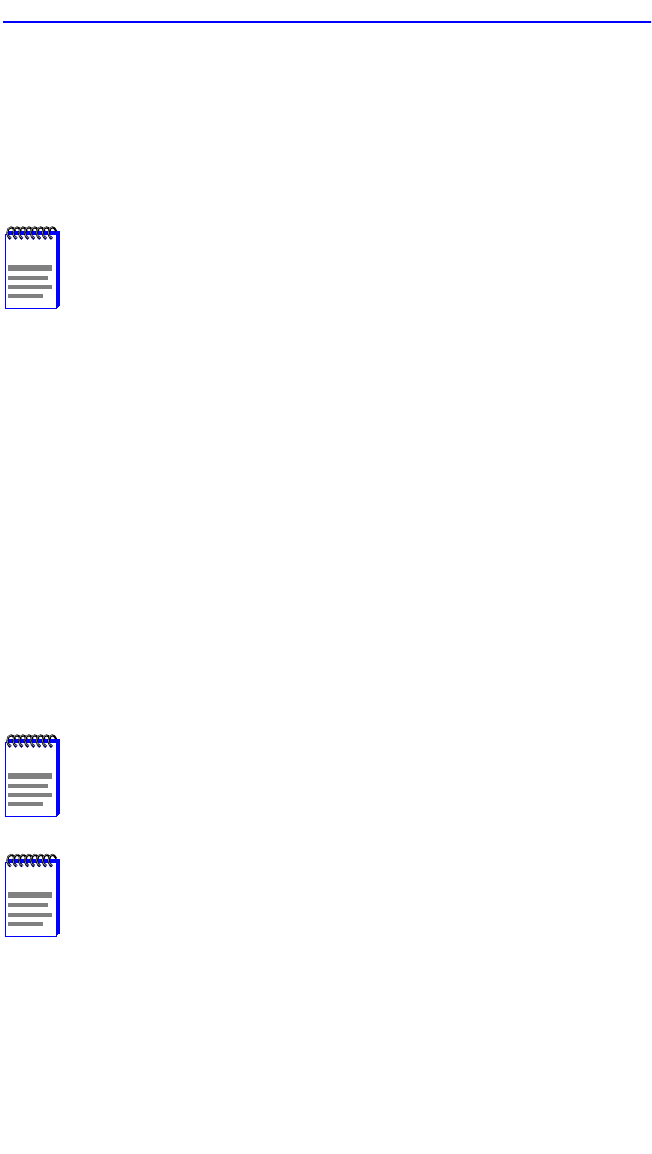
Port Redirect Function Screen
6H128-08 and 6H129-08 User’s Guide 5-31
Chassis Fan Status (Read-Only)
Displays the current status of the 6C105 fan tray. This field displays either
“Normal”, “Fault”, or “Not Installed”.
5.11 PORT REDIRECT FUNCTION SCREEN
The Port Redirect Function screen, Figure 5-14, allows the user to set
each one of the modules in the chassis (1 through 5), and the ports of the
corresponding module, as a source or destination port. A port can be set to
have one or more destination ports and chassis module slot numbers. For
example, port 1 in module (slot) 1 can be set as a source port with three
destinations, ports 2, 3, and 4 in module (slot) 3. Traffic from port 1 in
module 1 is then automatically redirected to ports 2, 3, and 4 in module 3.
Port 1 in module 1 can also serve as a destination port for other ports and
modules. The port redirect function is extremely useful for
troubleshooting purposes, as it allows traffic to be sent to a particular
port(s) where, with the use of an analyzer or RMON probe, all current
traffic from the source port(s) can be examined.
NOTE The Port Redirect Function screen may not be available
depending on the operational mode that has been set for the
chassis. Refer to the Release Notes to see what operational
modes support the Port Redirect Function. Refer to
Section 5.7.7 for instructions on configuring the operational
modes of all the modules installed in the chassis.
NOTE The module number corresponds to the slot number in which
the module resides in the 6C105 chassis (1 through 5).
NOTE Although traffic from the source port (including, if desired,
errored frames) is sent to the destination port, normal switching
is still performed for all frames on the source port.

Chapter 5: Local Management
5-32 6H128-08 and 6H129-08 User’s Guide
To access the Port Redirect Function screen from the Chassis Menu
screen, use the arrow keys to highlight the PORT REDIRECT
FUNCTION menu item and press ENTER. The Port Redirect Function
screen, Figure 5-14, displays.
Figure 5-14 Port Redirect Function Screen
The following definitions briefly explain each field of the Port Redirect
Function screen.
Source Module (Read-Only)
Displays which modules are currently set as source modules.
Source Port (Read-Only)
Displays which ports are currently set as source ports.
Destination Module (Read-Only)
Displays which modules are currently set as destination modules.
Destination Port (Read-Only)
Displays which ports are currently set as destination ports.
Port Redirect Function
2269_66
Port
1
1
1
2
2
3
3
3
Module
3
3
3
1
3
4
5
5
Module
1
1
1
2
2
3
3
3
Port
2 ON
3 OFF
4 ON
1 OFF
3 OFF
4 ON
5 ON
8 OFF
Source
---------------------------------- Destination
-------------------------------- Remap Errors
-------------------
Module type: 6H128-08 Firmware Revision: XX.XX.XX
Slot Number: X BOOTPROM Revision: XX.XX.XX
6C105 LOCAL MANAGEMENT
Event Message Line
SAVE PREVIOUS
RETURN
NEXT
Source Module [ 1]
Destination Port [ 3] Status [ADD]
Source Port [ 1]
Destination Module [ 5]
RETURN
EXIT
Errors [ ON]

Port Redirect Function Screen
6H128-08 and 6H129-08 User’s Guide 5-33
Remap Errors (Read-only)
Displays whether the corresponding source modules and ports are
configured to send errored frames to the destination modules and ports, or
to drop all errored frames before forwarding traffic.
Source Module [
n
] (Selectable)
Allows a selected module [n] are to be configured as a source module.
Source Port [
n
] (Selectable)
Allows a selected port [n] are to be configured as a source port.
Destination Module [
n
] (Selectable)
Allows a selected module [n] are to be configured as a destination
module.
Destination Port [
n
] (Selectable)
Allows a selected port [n] to be configured as a destination port.
Status (Toggle)
Allows the user to add or delete the source/destination modules and
interfaces selected in the Source/Destination Modules and Interfaces
fields.
Errors (Toggle)
Allows the user to configure the source modules and ports to either send
errored frames to selected destination modules and ports, or to drop
errored frames, and send only valid traffic to the destination modules and
ports. The default setting of this field is ON.

Chapter 5: Local Management
5-34 6H128-08 and 6H129-08 User’s Guide
5.11.1 Displaying the Source and Destination Entries
There can be more than one Port Redirect Function screen depending on
the number of port redirect entries. Each screen displays up to ten port
redirect entries. If there is more than one screen of redirect entries, the
NEXT and/or PREVIOUS command is displayed at the bottom of the
screen, allowing the user to navigate to the next or previous screen.
For example, with three screens of entries, the NEXT command is
displayed at the bottom of the first screen. In the second screen, the
NEXT and PREVIOUS commands are displayed. In the last screen, only
the PREVIOUS command is displayed.
To display the next screen, use the arrow keys to highlight NEXT. Press
ENTER and the next screen of entries is displayed.
To display the previous screen, use the arrow keys to highlight
PREVIOUS. Press ENTER to view the entries in the previous screen.
5.11.2 Changing Source and Destination Ports
Add or delete source/destination module and port entries as follows:
1. Use the arrow keys to highlight the Source Module field.
2. Press the SPACE bar or BACKSPACE one or more times to increment
or decrement the module number displayed in the brackets [n] until the
appropriate module number is displayed.
3. Use the arrow keys to highlight the Source Port field.
4. Press the SPACE bar or BACKSPACE one or more times to increment
or decrement the interface number displayed in the brackets [n] until
the appropriate interface number is displayed.
5. Use the arrow keys to highlight the Destination Module field.
6. Use the SPACE bar or BACKSPACE to step to the appropriate
module number for the destination module.
7. Use the arrow keys to highlight the Destination Port field.
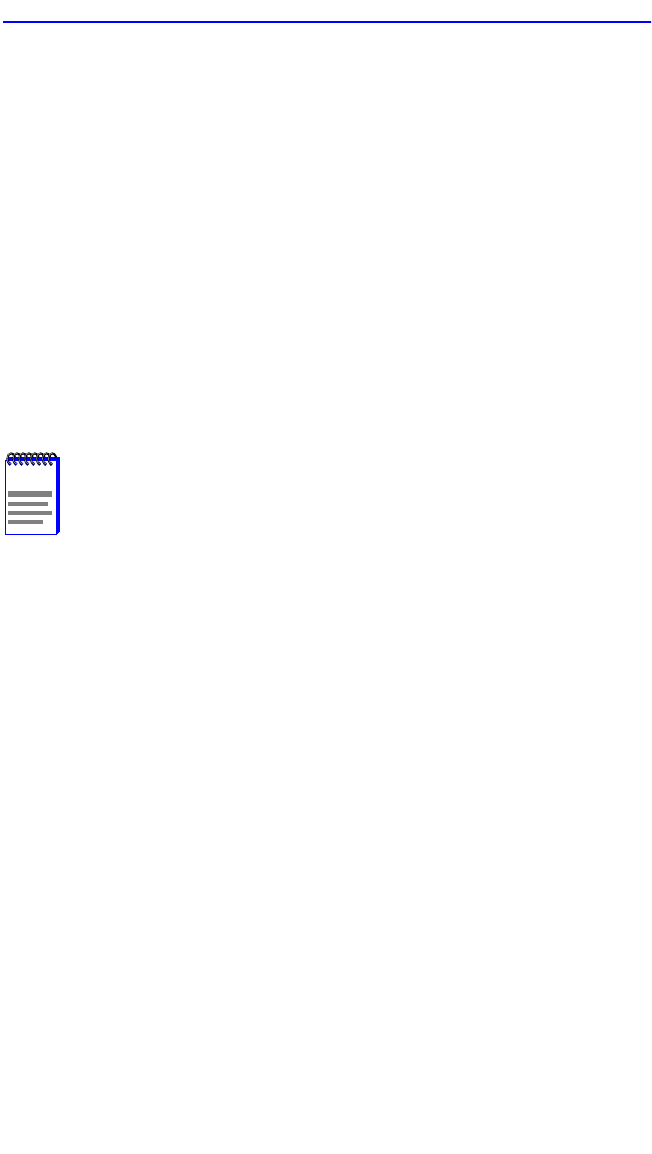
Module Selection Screen
6H128-08 and 6H129-08 User’s Guide 5-35
8. Use the SPACE bar or BACKSPACE to step to the appropriate
interface number for the destination interface.
9. Use the arrow keys to highlight the Errors field.
10. Use the SPACE bar to select either the ON or OFF option and press
ENTER. ON forces the source module and port to forward errored
frames to the destination module(s) and port(s). OFF forces the
errored to be dropped before forwarding traffic.
11. Use the arrow keys to highlight the Status field.
12. Use the SPACE bar to select either the ADD or DEL (delete) option.
Press ENTER. This adds or deletes the interface selections made in
steps 2 and 4 and also updates, but does not save, the screen Source
Interface, Destination Interface, and Remap Errors list.
13. Use the arrow keys to highlight SAVE at the bottom of the screen.
Press ENTER. The message “SAVED OK” is displayed. This saves
the new settings and updates the Source Module, Source Port,
Destination Module, Destination Port, and Remap Errors read-only
fields.
5.12 MODULE SELECTION SCREEN
The Module Selection screen is the access point to Local Management for
all modules installed in the SmartSwitch 6000 chassis. By selecting a
module, the Module Menu screen for the selected device displays.
Figure 5-15 shows the Module Selection screen.
To access the Module Selection screen, use the arrow keys to highlight the
MODULES menu item from the Main Menu screen and press ENTER.
The Module Selection screen displays.
NOTE If more than one module and interface is to be redirected,
repeat steps 1 through 12 for each additional setting, then go to
step 13 to save all the new settings at once.

Chapter 5: Local Management
5-36 6H128-08 and 6H129-08 User’s Guide
Figure 5-15 Module Selection Screen
The following explains each Module Selection screen field as shown in
Figure 5-15.
SLOT # (Selectable)
The module number displays the slot number in which the module is
installed. The module number enclosed in < > characters indicates the
module to which the management terminal is connected.
MODULE Name (Read-only)
This displays the model number of the SmartSwitch 6000 module that is
installed in each particular slot.
Serial # (Read-only)
Indicates the serial number of the module. The serial number of the device
is necessary when calling the Cabletron Systems Global Call Center.
Hardware Revision (Read-only)
Reflects the hardware version of the module.
Module Selection
2159-39
EXIT
SLOT #
<1>
2
3
4
5
MODULE Name
6H128-08
6E132-25
6E123-26
6E122-26
Serial #
123456789
123456789
123456789
123456789
Hardware Revision
XXX
XXX
XXX
XXX
__
_
6C105 LOCAL MANAGEMENT
Event Message Line
RETURN

Module Menu Screen
6H128-08 and 6H129-08 User’s Guide 5-37
5.12.1 Selecting a Module
To select an individual module to perform Local Management functions,
proceed as follows:
1. Use the arrow keys to highlight the desired module number in the
SLOT # field.
2. Press ENTER, the applicable Module Menu screen displays. Proceed
to Section 5.13.
5.13 MODULE MENU SCREEN
The Module Menu screen is the access point for all Local Management
screens for the 6H12X-08. Figure 5-16 shows the 6H128-08 Module
Menu screen.
Figure 5-16 Module Menu Screen
Firmware Revision: XX.XX.XX
Module Menu
MODULE CONFIGURATION
2159-14
Module Type: 6H128-08
Slot Number:
X
BOOTPROM Revision: XX.XX.XX
6H128-08 LOCAL MANAGEMENT
RETURN
MODULE STATISTICS
NETWORK TOOLS
EXIT

Chapter 5: Local Management
5-38 6H128-08 and 6H129-08 User’s Guide
The following explains each Module Menu screen field as shown in
Figure 5-16:
MODULE CONFIGURATION
The Module Configuration screen provides access to the Local
Management screens that are used to configure the 6H12X-08, and also to
the Module Specific Configuration screen. The Module Specific
Configuration screen provides access to the screens that allow the user to
check 6H12X-08 resources and set operating parameters specific to each
port. For details about the Module Configuration Menu screen, refer to
Section 5.14. For details about the Module Specific Configuration screen,
refer to Section 5.21.
MODULE STATISTICS
The Module Statistics screen provides statistics and performance
information for the 6H12X-08. For details about this screen, refer to
Section 5.25.
NETWORK TOOLS
The Network Tools function resides on the 6H12X-08 and consists of a
series of commands that allow the user to access and manage network
devices. Section 5.29 explains how to use the Network Tools utility.
5.14 MODULE CONFIGURATION MENU SCREEN
The Module Configuration Menu screen, Figure 5-17, provides access to
the Local Management screens that allow you to configure and monitor
operating parameters, modify SNMP community names, set SNMP traps,
configure switch parameters and configure the 6H12X-08 ports.
NOTE The following menu items on the Module Configuration Menu
screen may not display if the operational mode of the module
has been set to SECURE FAST VLAN:
SWITCH CONFIGURATION
SMARTTRUNK CONFIGURATION
Refer to your Release Notes to see if the functionality provided
by the above screens is supported in SECURE FAST VLAN
mode.
Section 5.15.9 provides instructions on setting the operational
mode.

Module Configuration Menu Screen
6H128-08 and 6H129-08 User’s Guide 5-39
To access the Module Configuration Menu screen from the Module Menu
screen, use the arrow keys to highlight the MODULE
CONFIGURATION menu item and press ENTER. The Module
Configuration screen displays.
Figure 5-17 Module Configuration Menu Screen
The following briefly explains each screen accessible from the Module
Configuration Menu screen:
GENERAL CONFIGURATION
The General Configuration screen allows the user to monitor and
configure operating parameters for the 6H12X-08. For details, refer to
Section 5.15.
SNMP COMMUNITY NAMES
The SNMP Community Names screen allows the user to enter, change, or
review the community names used as access passwords for Local/Remote
Management operation. Access is limited based on the password level of
the user. For details, refer to Section 5.16.
Firmware Revision: XX.XX.XX
Module Configuration Menu
GENERAL CONFIGURATION
SNMP COMMUNITY NAMES
SNMP TRAPS
SWITCH CONFIGURATION
ETHERNET INTERFACE CONFIGURATION
SMARTTRUNK CONFIGURATION
MODULE SPECIFIC CONFIGURATION
2159-15
BOOTPROM Revision: XX.XX.XX
Module Type: 6H128-08
Slot Number:
X
6H128-08 LOCAL MANAGEMENT
RETURN
EXIT

Chapter 5: Local Management
5-40 6H128-08 and 6H129-08 User’s Guide
SNMP TRAPS
The SNMP Traps screen provides display and configuration access to the
table of IP addresses used for trap destinations and associated community
names. For details, refer to Section 5.17.
SWITCH CONFIGURATION
The Switch Configuration screen provides basic setup options for
modifying switch operations in the network. For details, refer to
Section 5.18.
ETHERNET INTERFACE CONFIGURATION
The Ethernet Interface Configuration screen indicates the link status,
current and desired operational mode, advertised ability, and flow control
admin status for ports 1 through 8 on the 6H12X-08. Refer to
Section 5.19 for details.
SMARTTRUNK CONFIGURATION
The SmartTrunk Configuration screen allows the user to logically group
interfaces together to aggregate high speed uplinks. Refer to the
Cabletron Systems SmartTrunk User’s Guide for additional information.
MODULE SPECIFIC CONFIGURATION
The Module Specific Configuration menu allows the user to access
screens to configure ports or check system resources specific to the
6H12X-08. For details, refer to Section 5.21.
5.15 GENERAL CONFIGURATION SCREEN
The General Configuration screen, Figure 5-18, allows the user to set the
system date and time, IP address and subnet mask, and default gateway,
the TFTP Gateway IP address, the screen refresh and lockout times, the
Operational Mode, Management Mode, and COM port configuration. The
General Configuration screen also allows the user to clear NVRAM, and
set the IP Fragmentation.
To access the General Configuration screen from the Module
Configuration Menu screen, use the arrow keys to highlight the
GENERAL CONFIGURATION menu item and press ENTER. The
General Configuration screen, Figure 5-18, displays.

General Configuration Screen
6H128-08 and 6H129-08 User’s Guide 5-41
Figure 5-18 General Configuration Screen
The following briefly explains each General Configuration screen field:
MAC Address (Read-Only)
Displays the base physical address of the module.
IP Address (Modifiable)
This display allows the IP address to be set for the 6H12X-08. To set the
IP address, refer to Section 5.15.1.
Subnet Mask (Modifiable)
Displays the subnet mask for the module. A subnet mask “masks out” the
network bits of the IP address by setting the bits in the mask to 1 when the
network treats the corresponding bits in the IP address as part of the
network or subnetwork address, or to 0 if the corresponding bit identifies
the host. When an IP address is entered in the IP address field, the subnet
mask field automatically enters the default subnet mask for the IP address.
For details about how to change the subnet mask from its default value,
refer to Section 5.15.2.
Firmware Revision: XX.XX.XX
General Configuration
2159-16
BOOTPROM Revision: XX.XX.XX
MAC Address:
IP Address:
Subnet Mask:
Default Gateway:
TFTP Gateway IP Addr:
Module Date:
Module Time:
Screen Refresh Time:
Screen Lockout Time:
Com 1: [ENABLED] Application: [LM]
Clear NVRAM: [NO]
Module Uptime XX D XX H XX M
Module Type: 6H128-08
Slot Number:
X
IP Fragmentation [ENABLED]
EXIT
Operational Mode: [802.1D SWITCHING] Management Mode: [DISTRIBUTED]
00-00-ID-00-00-00
0.0.0.0
255.255.0.0
NONE DEFINED
0.0.0.0
6H128-08 LOCAL MANAGEMENT
Event Message Line
RETURNSAVE
10/11/97
14:23:00
30 sec.
15 min.

Chapter 5: Local Management
5-42 6H128-08 and 6H129-08 User’s Guide
Default Gateway (Modifiable)
Displays the default gateway for the 6H12X-08. This field is not defined
until an appropriate value is entered. For details about why and how to set
the default gateway, refer to Section 5.15.3.
TFTP Gateway IP Addr (Modifiable)
Displays and allows the user to set the TFTP Gateway IP address for the
6H12X-08. To set the TFTP Gateway IP address, refer to Section 5.15.4.
Module Date (Modifiable)
Contains a value that the module recognizes as the current date. To set a
new module date, refer to Section 5.15.5.
Module Time (Modifiable)
Contains a value that the module recognizes as the current time. To enter a
new time, refer to Section 5.15.6.
Screen Refresh Time (Modifiable)
Contains the rate at which the screens are updated. This setting
determines how frequently (in seconds) information is updated on the
screen. To enter a new update time, refer to Section 5.15.7.
Screen Lockout Time (Modifiable)
Contains the maximum number of minutes that the Local Management
application displays a module’s screen while awaiting input or action
from a user. For example, if the number 5 is entered in this field, the user
has up to five minutes to respond to each of the specified module’s Local
Management screens. In this example, after five minutes of “idleness” (no
input or action), the terminal “beeps” five times, the Local Management
application terminates the session, and the display returns to the Password
screen. To enter a new lockout time, refer to Section 5.15.8.
Module Uptime (Read-Only)
Displays the total time that the module has been operating.
Operational Mode (Selectable)
This field allows the user to set the 6H12X-08 to operate as a traditional
switch (802.1D SWITCHING option), or as an IEEE 802.1Q switch
(802.1Q SWITCHING option), or as a Cabletron Systems SecureFast
switch (SECURE FAST VLAN option).

General Configuration Screen
6H128-08 and 6H129-08 User’s Guide 5-43
In 802.1D SWITCHING mode, the 6 fiber ports and the 2 optional
Interface Module ports are bridged to each other.
In 802.1Q SWITCHING mode, the 6H12X-08 is able to increase its
switching functionality by creating and maintaining IEEE port based
VLANs.
When the operational mode is set to SECURE FAST VLAN, the
6H12X-08 acts as SecureFast switch. With the Cabletron Systems VLAN
Manager software, the 6H12X-08 is able to increase its switching
functionality by creating and maintaining Virtual LANs (VLANs).
For details on how to select the Operational Mode, refer to Section 5.15.9.
Management Mode (Toggle)
This field toggles between DISTRIBUTED and STAND ALONE.
In DISTRIBUTED mode, Local Management is entered via the 6C105
password screen, and all chassis configuration screens are available to the
user. All other modules installed in the chassis that are set for distributed
management may also be accessed via a connection to a single COM port
on one of the modules. The user can then manage all modules within the
chassis and the chassis itself.
In STAND ALONE mode, the module is isolated from the chassis
configuration screens, and the module may not be accessed from a
module that is in DISTRIBUTED mode. This provides additional security
for any module to which the user may wish to restrict access. Refer to
Section 5.15.10 for details.
Com (Toggle)
This field allows the user to enable or disable the COM port. The
selection toggles between ENABLED and DISABLED. The default is
ENABLED. For details about setting up the COM port, refer to
Section 5.15.11.
NOTE If the user is establishing a remote connection, such as a Telnet
or SNMP connection, using the IP address of the module, the
chassis LM screens will not be available. To access the chassis
LM screens, the IP address of the chassis must be used to
establish the connection.

Chapter 5: Local Management
5-44 6H128-08 and 6H129-08 User’s Guide
Application (Toggle)
Displays the application set for the COM port. This field allows you to set
the application that the COM port will support, which includes:
•Local Management (LM) via a terminal or modem connection
•Uninterruptible Power Supply (UPS)
The UPS setting allows you to use the COM port to monitor an American
Power Conversion Smart Uninterruptible Power Supply (UPS). For UPS,
the baud rate is automatically set to 2400.
The baud rate setting for LM is automatically sensed.
For details about how to configure the COM port for various applications,
refer to Section 5.15.11.
Clear NVRAM (Toggle)
This allows the user to reset NVRAM to the factory default settings. All
user-entered parameters, such as IP address and Community Names are
then replaced with 6H12X-08 default configuration settings. For details,
refer to Section 5.15.12.
IP Fragmentation (Toggle)
This field allows the user to enable or disable IP fragmentation. The
default setting for this field is ENABLED. If traffic from the 6H12X-08
will be bridged to an FDDI ring, IP Fragmentation should be enabled. If
IP Fragmentation is disabled, all FDDI frames that exceed the maximum
Ethernet frame size will be discarded. For details on enabling or disabling
IP Fragmentation refer to Section 5.15.13.
5.15.1 Setting the IP Address
To set the IP address, perform the following steps:
1. Use the arrow keys to highlight the IP Address field.
NOTE If the 6C105 chassis has been assigned an IP address, it is not
necessary to assign an IP address to the 6H12X-08. All
installed modules have the same IP address as the chassis. If
a separate IP address for the module is desired, for security or
distributed management capabilities, proceed to step 1.

General Configuration Screen
6H128-08 and 6H129-08 User’s Guide 5-45
2. Enter the IP address into this field using Decimal Dotted Notation
(DDN) format.
For example: 134.141.79.120
3. Press ENTER. If the IP address is a valid format, the cursor returns to
the beginning of the IP address field. If the entry is not valid, the Event
Message Line displays “INVALID IP ADDRESS OR FORMAT
ENTERED”. Local Management does not alter the current value and
refreshes the IP address field with the previous value.
4. Use the arrow keys to highlight the SAVE command, then press
ENTER. The warning screen shown in Figure 5-19 displays.
5. Use the arrow keys to highlight the YES command and press ENTER.
The changes are saved and the module reboots.
Figure 5-19 Configuration Warning Screen
WARNING!
cnfgwarn
YOU HAVE ELECTED TO SAVE ONE OR MORE CONFIGURATION
ITEMS THAT REQUIRE RESETTING THIS MODULE.
ARE YOU SURE YOU WANT TO CONTINUE?
Event Message Line
YES NO

Chapter 5: Local Management
5-46 6H128-08 and 6H129-08 User’s Guide
5.15.2 Setting the Subnet Mask
If the management workstation that is to receive SNMP traps from the
6H12X-08 is located on a separate subnet, the subnet mask for the
6H12X-08 must be changed from its default.
To change the subnet mask from its default, or if a separate subnet mask
for this module is desired, perform the following steps:
1. Use the arrow keys to highlight the Subnet Mask field.
2. Enter the subnet mask into this field using Decimal Dotted Notation
(DDN) format.
For example: 255.255.255.0
3. Press ENTER. If the subnet mask is valid, the cursor returns to the
beginning of the Subnet Mask field. If the entry is not valid, the Event
Message Line displays “INVALID SUBNET MASK OR FORMAT
ENTERED”. Local Management does not alter the current value, but
it does refresh the Subnet Mask field with the previous value.
4. Use the arrow keys to highlight the SAVE command.
5. Press ENTER. The Event Message Line at the top of the screen
displays “SAVED OK”, and the module resets.
5.15.3 Setting the Default Gateway
If the SNMP management station is located on a different IP subnet than
the 6H12X-08, a default gateway must be specified. When an SNMP Trap
is generated, the 6H12X-08 sends the Trap to the default gateway. To set
the default gateway, perform the following steps:
1. Use the arrow keys to highlight the Default Gateway field.
2. Enter the IP address of the default gateway using the DDN format.
For example: 134.141.79.121
NOTE If the 6C105 chassis has been assigned a subnet mask it is not
necessary to assign a subnet mask to the 6H12X-08. All
installed modules have the same subnet mask as the chassis.

General Configuration Screen
6H128-08 and 6H129-08 User’s Guide 5-47
3. Press ENTER. If the default gateway entered is a valid format, the
cursor returns to the beginning of the Default Gateway field. If the
entry is not valid, the Event Message Line displays “INVALID
DEFAULT GATEWAY OR FORMAT ENTERED”. Local
Management does not alter the current value, but it does refresh the
Default Gateway field with the previous value.
4. Use the arrow keys to highlight the SAVE command.
5. Press ENTER. The Event Message Line at the top of the screen
displays “SAVED OK”.
5.15.4 Setting the TFTP Gateway IP Address
If the network TFTP server is located on a different IP subnet than the
6H12X-08, a Gateway IP address should be specified. To set the TFTP
Gateway IP address, perform the following steps:
1. Use the arrow keys to highlight the TFTP Gateway IP Address field.
2. Enter the IP address of the TFTP gateway using the DDN format.
For example: 134.141.80.122
3. Press ENTER. If the TFTP gateway IP address entered is a valid
format, the cursor returns to the beginning of the TFTP Gateway IP
Address field. If the entry is not valid, the Event Message Line
displays “INVALID TFTP GATEWAY IP ADDRESS OR FORMAT
ENTERED”. Local Management does not alter the current value, but
it does refresh the TFTP Gateway IP Address field with the previous
value.
4. Use the arrow keys to highlight the SAVE command.
5. Press ENTER. The Event Message Line at the top of the screen
displays “SAVED OK”.

Chapter 5: Local Management
5-48 6H128-08 and 6H129-08 User’s Guide
5.15.5 Setting the Module Date
The modules are year 2000 compliant, so the module date may be set
beyond the year 1999. To set the module date, perform the following
steps:
1. Use the arrow keys to highlight the Module Date field.
2. Enter the date in this format: MM/DD/YYYY
3. Press ENTER to set the module date to the date in the input field.
4. Use the arrow keys to highlight the SAVE command at the bottom of
the screen and press ENTER.
If the date entered is a valid format, the Event Message Line at the top of
the screen displays “SAVED OK”. If the entry is not valid, Local
Management does not alter the current value, but it does refresh the
Module Date field with the previous value.
5.15.6 Setting the Module Time
To set the module time, perform the following steps:
1. Use the arrow keys to highlight the Module Time field.
2. Enter the time in a 24-hour format: HH:MM:SS
NOTE If the 6C105 chassis has been assigned a chassis date, it is not
necessary to assign a module date to the 6H12X-08. All
installed modules recognize the chassis date of the 6C105.
NOTE It is not necessary to add separators between month, day, and
year numbers. For example, to set the date to 03/17/1997, type
“03171997” in the Module Date field.
NOTE If the 6C105 chassis has been assigned a chassis time, it is not
necessary to assign a module time to the 6H12X-08. All
installed modules recognize the chassis time of the 6C105.

General Configuration Screen
6H128-08 and 6H129-08 User’s Guide 5-49
3. Press ENTER to set the module time to the time in the input field.
4. Use the arrow keys to highlight the SAVE command at the bottom of
the screen and press ENTER.
If the time entered is a valid format, the Event Message Line at the top of
the screen displays “SAVED OK”. If the entry is not valid, Local
Management does not alter the current value and refreshes the Module
Time field with the previous value.
5.15.7 Entering a New Screen Refresh Time
The screen refresh time is set from 3 to 99 seconds with a default of 3
seconds. To set a new screen refresh time, perform the following steps:
1. Use the arrow keys to highlight the Screen Refresh Time field.
2. Enter a number from 3 to 99.
3. Press ENTER to set the refresh time to the time entered in the input
field.
4. Use the arrow keys to highlight the SAVE command at the bottom of
the screen and press ENTER.
If the time entered is within the 3 to 99 seconds range, the Event Message
Line at the top of the screen displays “SAVED OK”. If the entry is not
valid, Local Management does not alter the current setting, but it does
refresh the Screen Refresh Time field with the previous value.
NOTE When entering the time in the Module Time field, separators
between hours, minutes, and seconds do not need to be added
as long as each entry uses two numeric characters. For
example, to set the time to 6:45 A.M., type “064500” in the
Module Time field.

Chapter 5: Local Management
5-50 6H128-08 and 6H129-08 User’s Guide
5.15.8 Setting the Screen Lockout Time
The screen lockout time can be set from 1 to 30 minutes with a default of
15 minutes. To set a new lockout time, perform the following steps:
1. Use the arrow keys to highlight the Screen Lockout Time field.
2. Enter a number from 1 to 30.
3. Press ENTER to set the lockout time in the input field.
4. Use the arrow keys to highlight the SAVE command at the bottom of
the screen and press ENTER.
If the time entered is within the 1 to 30 minutes range, the Event Message
Line at the top of the screen displays “SAVED OK”. If the entry is not
valid, Local Management does not alter the current setting, but it does
refresh the Screen Lockout Time field with the previous value.
5.15.9 Setting the Operational Mode
To set the Operational Mode, proceed as follows:
1. Use the arrow keys to highlight the Operational Mode field.
!
CAUTION
Before setting the operational mode, ensure that the items
contained in this caution are fully understood.
If the module will be configured to operate as a SecureFast
switch, the following procedures should be performed before
setting the operational mode:
The module must be assigned a unique IP address.
The Management Mode of the module must be set to
STAND ALONE. The Management Mode field will no longer
display on the General Configuration screen, and the module
will no longer support Chassis Configuration and Module
Selection screens. If the module will be a SecureFast switch,
distributed management is not allowed.
The module has been assigned SNMP community names from
the module SNMP Community Names screen (Section 5.16).
In Standalone management mode, the module does not use
the community names of the 6C105 chassis.
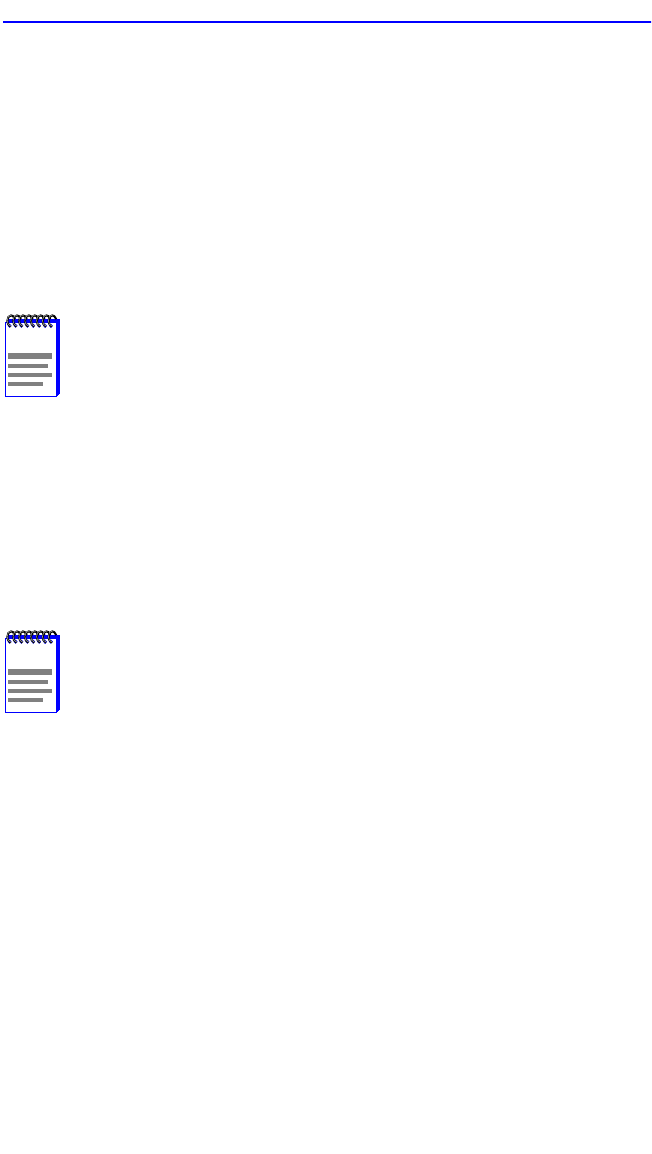
General Configuration Screen
6H128-08 and 6H129-08 User’s Guide 5-51
2. Press the SPACE bar to step to the appropriate operation mode,
(802.1D SWITCHING, 802.1Q SWITCHING, or SECURE FAST
VLAN).
3. Use the arrow keys to highlight the SAVE command at the bottom of
the screen and press ENTER. The warning screen shown back in
Figure 5-19 displays.
4. Use the arrow keys to highlight the YES command and press ENTER.
The changes are saved and the module reboots.
5.15.10 Setting the Management Mode
To set the Management Mode, perform the following steps:
1. Use the arrow keys to highlight the Management Mode field:
2. Use the SPACE bar to toggle the options (DISTRIBUTED or
STAND ALONE) until the desired mode displays.
NOTE Upon saving the new operational mode, the module will reboot.
If the 6H12X-08 has been set to 802.1Q SWITCHING, refer to
your
Port Based VLAN User’s Guide
to configure the devices
for this type of operation.
If the 6H12X-08 has been set to SECURE FAST VLAN, refer to
your SecureFast documentation set to configure the device for
this type of operation.
NOTE Upon saving the new Management Mode, the module will
reboot.
If the module will be set to STAND ALONE, ensure the
following procedures have been completed first:
The module has been assigned a unique IP address.
The module has been assigned SNMP community names from
the module SNMP Community Names screen (Section 5.16).
In STAND ALONE management mode, the module does not
use the community names of the 6C105 chassis.
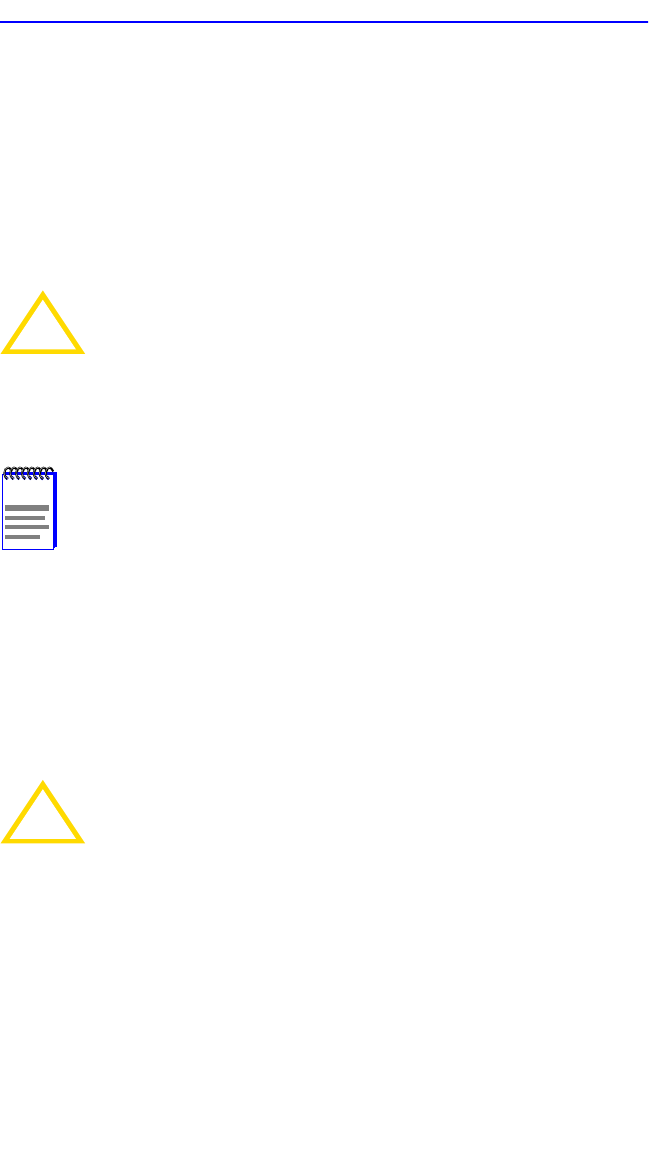
Chapter 5: Local Management
5-52 6H128-08 and 6H129-08 User’s Guide
3. Use the arrow keys to highlight the SAVE command at the bottom of
the screen. Then press ENTER. The warning screen shown back in
Figure 5-19 displays.
4. Use the arrow keys to highlight the YES command and press ENTER.
The changes are saved to memory, and the module reboots.
5.15.11 Configuring the COM Port
The 6H12X-08 COM port supports the following applications:
•Local Management connections
•American Power Conversion Uninterruptible Power Supply (UPS)
connections
To configure the COM port, proceed as follows:
1. Use the arrow keys to highlight the COM field.
2. Press the SPACE bar to choose either ENABLED or DISABLED.
The COM port must be ENABLED if it will be used for Local
Management or UPS applications. Select DISABLED if you wish to
disable the COM port for additional module security.
!
CAUTION
Before altering the COM port settings, ensure that a valid IP
address is set for the module or chassis. (Refer to
Section 5.15.1.) Read this entire COM port configuration
section before changing the settings of the COM port.
NOTE Refer to the Release Notes included with the 6H12X-08 to
verify which COM Port applications are currently supported.
!
CAUTION
Do NOT disable or alter the settings of the COM port while
operating the current Local Management connection through a
terminal. Altering the COM port settings disconnects the Local
Management terminal from the port, and ends the Local
Management session.

General Configuration Screen
6H128-08 and 6H129-08 User’s Guide 5-53
Figure 5-20 COM Port Warning Screen
3. Use the arrow keys to highlight YES. Press ENTER.
!
CAUTION
If the COM port is reconfigured without a valid IP address set
on the module or chassis, the message shown in Figure 5-20
displays. Do not continue unless the outcome of the action is
fully understood.
NOTE If the 6C105 chassis has been configured with a valid IP
address this screen will not appear. When the chassis is
assigned a valid IP address all the interface modules installed
share this same address.
If you do not get this screen, go to Step 4.
WARNING
174252
THE COM PORT HAS BEEN RECONFIGURED AND THERE IS NO IP
ADDRESS SET FOR THIS DEVICE. YOU WILL NO LONGER BE ABLE
TO MANAGE THIS BOARD. DO YOU STILL WISH TO RECONFIGURE
THIS COM PORT?
YES NO
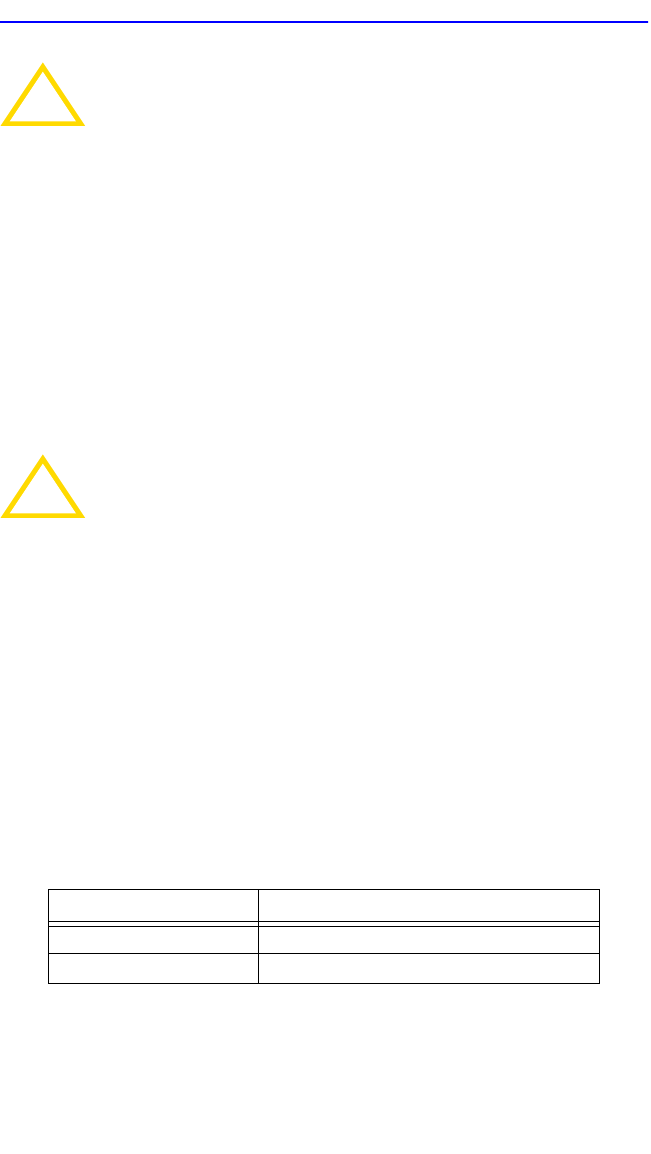
Chapter 5: Local Management
5-54 6H128-08 and 6H129-08 User’s Guide
4. If you ENABLED the port, proceed to Section 5.15.11.1, Changing
the Com Port Application. If you DISABLED the port, use the arrow
keys to highlight SAVE at the bottom of the screen, then press
ENTER.When the message “SAVED OK” displays, the edits are
saved.
5.15.11.1 Changing the Com Port Application
After enabling the COM port as described in Section 5.15.11, you can
select one of the applications supported by the COM port: LM, and UPS.
The default application is LM.
To change the COM port application:
1. Use the arrows keys to highlight the Application field.
2. Use the SPACE bar or BACKSPACE to step through the available
settings until the operation you require appears. Table 5-3 lists the
available settings and their corresponding applications.
3. Press ENTER to accept the application.
4. Use the arrow keys to highlight SAVE at the bottom of the screen, then
press the ENTER key.
!
CAUTION
Exiting without saving causes the message “NOT SAVED --
PRESS SAVE TO KEEP CHANGES” to appear. Exiting without
saving causes all edits to be lost.
!
CAUTION
When the COM port is configured to perform the UPS
application, all future Local Management connections must be
made by establishing a Telnet connection to the module.
Ensure that the module has a valid IP address before saving
changes to the COM port application. If the module does not
have a valid IP address and the changes are saved, refer to
Appendix C for instructions on clearing NVRAM in order to
reestablish COM port communications.
Table 5-3 COM Port Application Settings
Setting Application
LM Local Management Session
UPS APC Power Supply SNMP Proxy

General Configuration Screen
6H128-08 and 6H129-08 User’s Guide 5-55
5. When the message “SAVED OK” appears, the edits you made are
saved.
5.15.12 Clearing NVRAM
Clearing NVRAM allows the user to clear all user-entered parameters,
such as IP address and Community Names from NVRAM.
Clear NVRAM as follows:
1. Use the arrow keys to highlight the Clear NVRAM field.
2. Use the SPACE bar to toggle the field to YES.
3. Use the arrow keys to highlight SAVE at the bottom of the screen.
4. Press ENTER. The warning shown in Figure 5-21 is displayed.
Figure 5-21 Clear NVRAM Warning Screen
!
CAUTION
Clearing NVRAM will result in the loss of all user-entered
parameters. Do not proceed unless this procedure is
completely understood.
WARNING
174251
YOU HAVE ELECTED TO CLEAR NVRAM. THIS WILL CLEAR
ALL SYSTEM DEFAULTS INCLUDING BUT NOT LIMITED TO
IP ADDRESS, INTERFACE CONFIGURATION, AND COM PORT
CONFIGURATION, THEN RESET THE BOARD.
ARE YOU SURE YOU WANT TO CLEAR NVRAM?
YES NO

Chapter 5: Local Management
5-56 6H128-08 and 6H129-08 User’s Guide
5. Press YES and the message “CLEARING NVRAM. REBOOT IN
PROGRESS...” displays.
The 6H12X-08 will clear NVRAM and reboot. All user-entered
parameters default to factory settings.
5.15.13 Enabling/Disabling IP Fragmentation
To enable or disable IP fragmentation, proceed as follows:
1. Use the arrow keys to highlight the IP Fragmentation field.
2. Press the SPACE bar to choose either ENABLED or DISABLED.
3. Use the arrow keys to highlight the SAVE command.
4. Press ENTER. The Event Message Line at the top of the screen
displays “SAVED OK”.
5.16 SNMP COMMUNITY NAMES SCREEN
The SNMP Community Names menu item allows the user to set
Local/Remote Management community names. Community names act as
passwords to Local/Remote Management and are agents of security
access to the 6H12X-08. Access to the 6H12X-08 is controlled by setting
any of three different levels of security authorization (read-only,
read-write, and super-user).
!
CAUTION
If the 6H12X-08 is being bridged to an FDDI ring, do not
disable IP Fragmentation. If IP Fragmentation is disabled, all
FDDI frames that exceed the maximum Ethernet frame size will
be discarded.

SNMP Community Names Screen
6H128-08 and 6H129-08 User’s Guide 5-57
To access the SNMP Community Names screen from the Module
Configuration Menu screen, use the arrow keys to highlight the SNMP
COMMUNITY NAMES menu item and press ENTER. The SNMP
Community Names screen, Figure 5-22, displays.
Figure 5-22 SNMP Community Names Screen
NOTE If the 6C105 has been assigned community names, it is not
necessary to assign community names to the individual
modules installed in the chassis unless the user wishes to limit
access to 6C105 chassis screens by assigning different
community names to each module. When community names
are assigned to individual modules, access is limited to the
screens specific to the module to which the terminal is attached
and the Local Management session will begin at the Module
Menu screen. See Section 5.12.
Super-user access gives the user full management privileges,
allows existing passwords to be changed, and allows all
modifiable MIB objects for the Cabletron Container MIB and
Internet MIB-II to be accessed.
Firmware Revision: XX.XX.XX
SNMP Community Names
2159-17
BOOTPROM Revision: XX.XX.XX
Access Policy
read-only
read-write
super-user
Module Type: 6H128-08
Slot Number:
X
6H128-08 LOCAL MANAGEMENT
Event Message Line
RETURNSAVE
Community Name
public
public
public
EXIT

Chapter 5: Local Management
5-58 6H128-08 and 6H129-08 User’s Guide
The following explains each SNMP Community Names screen field:
Community Name (Modifiable)
Displays the user-defined name through which a user accesses 6H12X-08
management. Any community name assigned here acts as a password to
Local/Remote Management.
Access Policy (Read-Only)
Indicates the access accorded each community name. Possible selections
are as follows:
read-only This community name allows read-only access
to the 6H12X-08 MIB objects, and excludes
access to security-protected fields of read-write
or super-user authorization.
read-write This community name allows read and write
access to the 6H12X-08 MIB objects,
excluding security protected fields for
super-user access only.
super-user This community name permits read-write
access to the 6H12X-08 MIB objects and
allows the user to change all modifiable
parameters including community names, IP
addresses, traps, and SNMP objects.
5.16.1 Establishing Community Names
The password used to access Local Management at the Password Screen
must have Super-User access in order to view and edit the SNMP
Community Names screen. Using a password with read-only or
read-write access does not allow the user to view or edit the SNMP
Community Names screen.
NOTE Any community name assigned in the SNMP Community
Names screen is a password to its corresponding level of
access to Local/Remote Management. The community name
assigned Super-User access is the only one that gives the user
complete access to Local/Remote Management.

SNMP Community Names Screen
6H128-08 and 6H129-08 User’s Guide 5-59
To establish community names, proceed as follows:
1. Use the arrow keys to highlight the Community Name field adjacent
to the selected access level.
2. Enter the password in the field (maximum 31 characters).
3. Press ENTER.
4. Repeat steps 1 through 3 to modify the other community names.
5. Use the arrow keys to highlight SAVE at the bottom of the screen and
press ENTER. The message “SAVED OK” displays. The community
names are saved to memory and their access modes implemented.
NOTE Exiting without saving causes a “NOT SAVED?” message to
display above the SAVE command. Edits will be lost if they are
not saved before exiting.

Chapter 5: Local Management
5-60 6H128-08 and 6H129-08 User’s Guide
5.17 SNMP TRAPS SCREEN
Since the 6H12X-08 is an SNMP compliant device, it can send messages
to multiple Network Management Stations to alert users of status
changes. The SNMP Traps screen is shown in Figure 5-23.
Access the SNMP Traps screen from the Module Configuration Menu
screen by using the arrow keys to highlight the SNMP TRAPS menu item
and pressing ENTER. The SNMP Traps screen displays.
Figure 5-23 SNMP Traps Screen
The following explains each field of the SNMP Traps screen.
Trap Destination (Modifiable)
Indicates the IP address of the workstation to receive trap alarms. Up to
eight different destinations can be defined.
NOTE It is only necessary to assign SNMP traps if the user desires
the traps to be sent to different addresses than those assigned
in Section 5.9, which details how to set SNMP Traps for the
6C105 chassis.
Firmware Revision: XX.XX.XX
SNMP Traps
2159-18
BOOTPROM Revision: XX.XX.XX
Trap Community Name
public
public
public
public
public
public
public
Module Type: 6H128-08
Slot Number:
X
EXIT
6H128-08 LOCAL MANAGEMENT
Event Message Line
RETURNSAVE
Trap Destination
0.0.0.0
0.0.0.0
0.0.0.0
0.0.0.0
0.0.0.0
0.0.0.0
0.0.0.0
Enable Traps
[NO]
[NO]
[NO]
[NO]
[NO]
[NO]
[NO]

SNMP Traps Screen
6H128-08 and 6H129-08 User’s Guide 5-61
Trap Community Name (Modifiable)
Displays the Community Name included in the trap message sent to the
Network Management Station with the associated IP address.
Enable Traps (Toggle)
Enables transmission of the traps to the network management station with
the associated IP address. This field toggles between YES and NO.
5.17.1 Configuring the Trap Table
To configure the Trap table, proceed as follows:
1. Using the arrow keys, highlight the appropriate Trap Destination
field.
2. Enter the IP Address of the workstation that is to receive traps. IP
address entries must follow the DDN format.
For example: 134.141.79.121
3. Press ENTER. If an invalid entry is made, “INVALID IP ENTERED”
is displayed in the Event Message Line.
4. Using the arrow keys, highlight the Trap Community Name field.
Enter the community name.
5. Press ENTER.
6. Using the arrow keys, highlight the Enable Traps field. Press the
SPACE bar to choose either YES (send alarms from the module to the
workstation), or NO (prevent alarms from being sent).
7. Using the arrow keys, highlight the SAVE option and press ENTER.
The message “SAVED OK” displays.
The designated workstations now receive traps from the 6H12X-08.
NOTE Exiting without saving causes a “NOT SAVED -- PRESS SAVE
TO KEEP CHANGES” message to display in the top left portion
of the screen. Edits will be lost if they are not saved before
exiting.
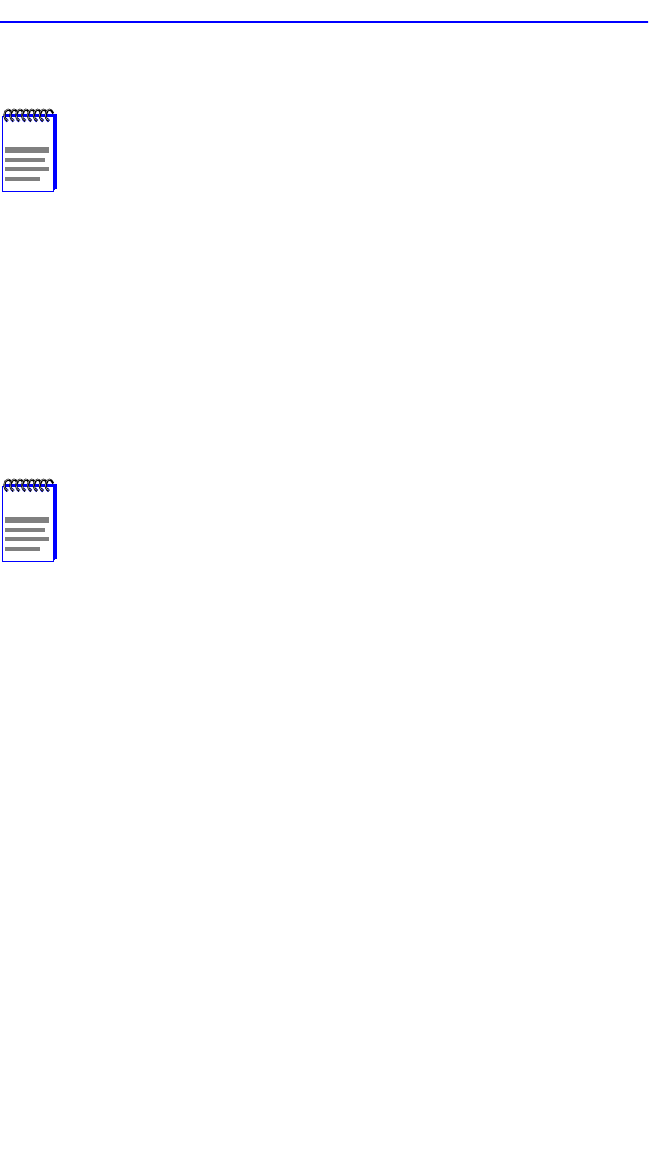
Chapter 5: Local Management
5-62 6H128-08 and 6H129-08 User’s Guide
5.18 SWITCH CONFIGURATION SCREEN
The Switch Configuration screen, Figure 5-24, provides the basic setup
options to make a switch operational in your network.
To access the Switch Configuration screen from the Module
Configuration Menu screen, use the arrow keys to highlight the SWITCH
CONFIGURATION menu item and press ENTER. The Switch
Configuration screen, Figure 5-24, displays ports 1 through 8. To view or
edit the fields for ports 9 to 12, highlight [9-12] at the bottom of the
screen and press the ENTER key.
NOTE The Switch Configuration screen will not be available if the
operational mode of the module has been set to SECURE
FAST VLAN. This screen may only be used by modules
configured to operate as 802.1D or 802.1Q switches.
NOTE Ports 7 and 8 on the Switch Configuration screen represent the
optional Fast Ethernet Interface Modules available for the
6H12X-08.
Ports 9 through 12 represent the backplane connections that
the module has with the 6C105 chassis. The module has a
direct connection to every other slot in the chassis.

Switch Configuration Screen
6H128-08 and 6H129-08 User’s Guide 5-63
Figure 5-24 Switch Configuration Screen
The following describes each field of the Switch Configuration screen:
Switch Address (Read-Only)
Displays the base MAC address of the switch.
Number of Ports (Read-Only)
Displays the total number of switched ports on the module.
Type of STA (Selectable)
Allows the user to set the method that switches use to decide which
switch is the controlling (Root) switch when two or more switches exist in
parallel (Spanning Tree Algorithm). Valid entries include IEEE, DEC, and
NONE. To set the STA, refer to Section 5.18.1.
Firmware Revision: XX.XX.XX
Switch Configuration
2269_18
BOOTPROM Revision: XX.XX.XX
Port #
1
2
3
4
5
6
7
8
State
learning
disabled
standby
disabled
listening
disabled
learning
disabled
Module Type: 6H128-08
Slot Number:
X
6H128-08 LOCAL MANAGEMENT
Event Message Line
RETURNSAVE
MAC Address
00-00-1D-00-00-00
00-00-1D-00-00-01
00-00-1D-00-00-02
00-00-1D-00-00-03
00-00-1D-00-00-04
00-00-1D-00-00-05
00-00-1D-00-00-06
00-00-1D-00-00-07
Status
[ENABLED]
[DISABLED]
[ENABLED]
[DISABLED]
[ENABLED]
[DISABLED]
[ENABLED]
[DISABLED]
Switch Address: 00-00-1D-00-00-00
Number of Ports: 12 Type of STA: [IEEE]
EXIT
Age Time (sec): 300
[ 9-12 ]

Chapter 5: Local Management
5-64 6H128-08 and 6H129-08 User’s Guide
Age Time (sec) (Modifiable)
Allows the user to set the amount of time (in seconds) the 6H12X-08 will
keep an address in its switch table before discarding it. The modules will
discard an address from their switch table if they do not receive a valid
Bridge Protocol Data Unit (BPDU) from the applicable address in the
amount of time specified in the Age Time field. To change the Age Time
field from the default value of 300 seconds, refer to Section 5.18.2.
Port # (Read-Only)
Lists each switch port on the module. If the number of ports is greater
than eight, then the additional ports are listed on subsequent screens.
MAC Address (Read-Only)
Displays the hardware address assigned to each listed port.
State (Read-Only)
•Disabled: Management disabled this interface. No traffic is received or
forwarded while the interface is disabled.
•Learning: The switch is learning the network address of this interface.
The switch enters the learning state when the Transparent Database is
created (during start-up or after being deleted), or when the Spanning
Tree Algorithm detects a network topology change.
•Listening: The switch is not adding information to the Transparent
Database. The switch is monitoring BPDU traffic while preparing to
move from the learning to the forwarding state.
•Forwarding: The switch is on-line and this interface is forwarding
traffic.
•Blocking: This interface will not forward any traffic through the switch
because a loop condition has been detected by the STA.
Status (Toggle)
Allows the user to disable or enable a port by setting the status of the
listed interface to either ENABLED or DISABLED. To set the port status,
refer to Section 5.18.3.

Switch Configuration Screen
6H128-08 and 6H129-08 User’s Guide 5-65
5.18.1 Setting the STA
The Spanning Tree Algorithm (STA) setting allows the user to set the
method that the switches use to decide which is the controller (Root)
switch when two or more switches are in parallel. The available selections
are IEEE, DEC, and NONE.
To set the STA, proceed as follows:
1. Use the arrow keys to highlight the Type of STA field.
2. Use the SPACE bar to step to the appropriate setting (IEEE, DEC, or
NONE).
3. Use the arrow keys to highlight the SAVE command at the bottom of
the screen.
4. Press ENTER. The message “SAVED OK” is displayed.
5.18.2 Setting the Age Time
To set the Age Time, proceed as follows:
1. Use the arrow keys to highlight the Age Time field.
2. Enter the desired Age Time in increments of 10. The available Age
Time range is 10 seconds to 1,000,000 seconds with the default value
being 300 seconds. Press RETURN to change the field.
3. Use the arrow keys to highlight the SAVE command at the bottom of
the screen.
4. Press ENTER. The message “SAVED OK” is displayed.

Chapter 5: Local Management
5-66 6H128-08 and 6H129-08 User’s Guide
5.18.3 Setting (Enabling or Disabling) the Port Status
To set the status of an interface (port), proceed as follows:
1. Use the arrow keys to highlight the Status field of the port.
2. Use the SPACE bar to toggle to either ENABLED or DISABLED.
3. Use the arrow keys to highlight the SAVE command at the bottom of
the screen.
4. Press ENTER. The message “SAVED OK” is displayed.
5.19 ETHERNET INTERFACE CONFIGURATION
Access the Ethernet Interface Configuration screen from the Module
Configuration Menu screen by using the arrow keys to highlight the
ETHERNET INTERFACE CONFIGURATION menu item and
pressing ENTER. The Ethernet Interface Configuration screen displays.
NOTE Disabling the port status of a backplane connection will block
the module from passing user traffic to the applicable module
slot in the 6C105 chassis. SNMP and other management traffic
(e.g., ping and Telnet traffic), however, will still pass via the
backplane to the applicable module slot.

Ethernet Interface Configuration
6H128-08 and 6H129-08 User’s Guide 5-67
Figure 5-25 Ethernet Interface Configuration Screen for the 6H12X-08
The following section briefly explains each field of the Ethernet Interface
Configuration screen:
Port Num (Read-only)
Displays the port number of the front panel interface.
Port Type (Read-Only)
Displays the name of the interface installed in ports 1 through 8.
Link Status (Read-Only)
Indicates whether or not there is a physical connection from a particular
port to another 10BASE-T, 100BASE-TX/FX, or
100BASE-TXFD/FXFD device. One of the following values is displayed:
•Link – There is a link signal present and a valid physical connection to
another 10BASE-T, 100BASE-TX/FX, or 100BASE-TXFD/FXFD
device.
•No Link – There is no link signal present and there is no valid physical
connection to another device.
Ethernet Interface Configuration
2159-23
Firmware Revision: XX.XX.XX
BOOTPROM Revision: XX.XX.XX
Module Type: 6H128-08
Slot Number:
X
6H128-08 LOCAL MANAGEMENT
Event Message Line
RETURN
SAVE
Port
Num
1
2
3
4
5
6
7
8
FE-100FX
FE-100FX
FE-100FX
FE-100FX
FE-100FX
FE-100FX
FE-100TX
FE-100FX
Port
Type
Link
Status
No Link
No Link
No Link
No Link
Link
No Link
No Link
Link
Current
Oper. Mode
100Base-FXFD
100Base-FXFD
100Base-FXFD
100Base-FXFD
100Base-FXFD
100Base-TX
100Base-FXFD
Desired
Oper. Mode
[100Base-FX]
[100Base-FXFD]
[100Base-FXFD]
[100Base-FXFD]
[100Base-FXFD]
[100Base-FXFD]
[100Base-TX]
[100Base-FXFD]
Advertised Ability
100Base-FX N/A
N/A
N/A
N/A
N/A
N/A
100Base-TXFD
N/A
EXIT
[Disabled]

Chapter 5: Local Management
5-68 6H128-08 and 6H129-08 User’s Guide
Current Oper. Mode (Read-only)
This field displays the current operating mode of a port. Depending on the
interface installed (100BASE-FX or 100BASE-TX), this field displays
the following:
•100Base-TX interface – Auto-Neg, Unknown (if there is no link),
10Base-T, 10Base-TFD (full duplex), 100Base-TX, or
100Base-TXFD (full duplex).
•100Base-FX (multimode or single mode) interface – Unknown (if
there is no link), 100Base-FX or 100Base-FXFD (full duplex).
Desired Oper. Mode (Selectable)
This field allows the user to select the desired operational mode for an
interface.
•FE-100TX Interface – The field toggles between Auto-Neg, 10Base-T,
10Base-TFD (full duplex), 100Base-TX, and 100Base-TXFD (full
duplex). In normal operation, the port with an FE-100TX interface is
capable of auto-negotiating the operational mode and no further user
setup is required. See Section 5.19.2 for more details.
•FE-100FX/F3 Interface – The field toggles between 100Base-FX or
100Base-FXFD (full duplex) operation. Section 5.19.1 describes how
to configure a port with an FE-100FX or FE-100F3 interface.
NOTE In normal operation, the port with an FE-100TX installed
automatically establishes a link with the device at the other end
of the segment without requiring user setup. However, Local
Management provides the user with the option of manually
configuring that port.

Ethernet Interface Configuration
6H128-08 and 6H129-08 User’s Guide 5-69
Advertised Ability (Selectable)
During auto-negotiation, the FE-100TX “tells” the device at the other end
of the segment what its capabilities are. The capabilities of a port with an
FE-100TX installed are 10BASE-T, 10BASE-TFD (full duplex mode),
100BASE-TX and 100BASE-TXFD (full duplex mode). In normal
operation, with all capabilities enabled, the FE-100TX “advertises” that it
has the ability to operate in any mode. The Network Manager may choose
to set up the port so that only a portion of the available capabilities are
advertised and the others are disabled. For example, only 100BASE-TX
and 100BASE-TXFD might be enabled so that only devices that operate
at 100 Mbps can communicate with that port. Section 5.19.4 describes
how to enable or disable advertised modes.
5.19.1 Configuring an FE-100FX/F3 Interface or a Port 7
or 8 FE-100FX/F3 Interface
Whether configuring the fixed interface (ports 1-6) or an FE-100FX or
FE-100F3 installed in port 7 or 8, the procedure is the same. The interface
port must be manually set to operate in the same technology as the device
at the other end of the connected segment. Use the Desired Oper. Mode
field to set the FE-100FX or FE-100F3 interface ports. This field toggles
between 100BASE-FX and 100BASE-FXFD (full duplex). To set the
active technology through Local Management, proceed as follows:
1. Use the arrow keys to highlight the Desired Oper. Mode field.
2. Use the SPACE bar to select 100BASE-FX or 100BASE-FXFD (full
duplex).
3. Press ENTER. The port now operates in the chosen mode.
4. Use the arrow keys to highlight the SAVE command. Press ENTER.
The message “SAVED OK” displays and Local Management saves
the changes to memory.

Chapter 5: Local Management
5-70 6H128-08 and 6H129-08 User’s Guide
5.19.2 Configuring an FE-100TX Interface
In normal operation, a port with an FE-100TX interface automatically
establishes a link with the device at the other end of the segment and no
user setup is required. Section 5.19.3 and Section 5.19.4 provide
instructions for manually configuring the port with an FE-100TX
installed.
5.19.3 Setting the FE-100TX Operational Mode
Use this field to set the active technology. This field steps between
Auto-Negotiation, 10BASE-T, 10BASE-TFD (full duplex),
100BASE-TX, and 100BASE-TXFD (full duplex). If Auto-Negotiation is
selected, the FE-100TX automatically sets the active technology. To
manually set the active technology through Local Management, proceed
as follows:
1. Use the arrow keys to highlight the Desired Oper. Mode field.
2. Use the SPACE bar to select the desired mode. Press ENTER. If any
mode other than Auto-Negotiation is selected, the port only operates
in the chosen mode and auto-negotiation is disabled.
3. Use the arrow keys to highlight the SAVE command. Press ENTER.
The message “SAVED OK” displays and Local Management saves
the changes to memory. The selected mode is displayed in both the
Desired Operational Mode field and the Current Operational Mode
field.
5.19.4 Setting the FE-100TX Advertised Ability
During normal operation, a port (7 or 8) with an FE-100TX
auto-negotiates to the highest speed possible. Under some circumstances,
the Network Administrator may want the port to advertise only some of
the available modes and not operate in other modes. This field steps
between 10BASE-T, 10BASE-TFD (full duplex), 100BASE-TX, and
100BASE-TXFD (full duplex). To set the advertised ability, proceed as
follows:
1. Use the arrow keys to highlight the Advertised Ability field.
2. Use the SPACE bar to select the desired mode.
3. Use the RIGHT-ARROW key to move across to the
Enabled/Disabled field to the right of the selection.

Module Specific Configuration Menu
6H128-08 and 6H129-08 User’s Guide 5-71
4. Use the SPACE bar to select Enabled or Disabled. Press ENTER.
5. Use the LEFT-ARROW key to move back to the Advertised Ability
selection and use the SPACE bar to select the next mode to enable or
disable. Continue this process until you have completed enabling or
disabling the advertised modes.
6. Use the arrow keys to highlight the SAVE command. Press ENTER.
The message “SAVED OK” displays and Local Management saves
the changes to memory.
5.20 MODULE SPECIFIC CONFIGURATION MENU
The Module Specific Configuration Menu screen, Figure 5-17, provides
access to the Local Management screens that allow you access to System
Resources, download flash images, and configure the 6H12X-08 ports.
To access the Module Specific Configuration menu from the Module
Configuration Menu screen, use the arrow keys to highlight the
MODULE SPECIFIC CONFIGURATION menu item and press
ENTER. The Module Specific Configuration menu displays.
Figure 5-26 Module Specific Configuration Menu Screen
Firmware Revision: XX.XX.XX
Module Specific Configuration Menu
SYSTEM RESOURCES
FLASH DOWNLOAD
PORT REDIRECT FUNCTION
BROADCAST SUPPRESSION
2364_MSC
BOOTPROM Revision: XX.XX.XX
Module Type: 6H128-08
Slot Number:
X
6H128-08 LOCAL MANAGEMENT
RETURN
EXIT

Chapter 5: Local Management
5-72 6H128-08 and 6H129-08 User’s Guide
The following briefly explains each screen accessible from the Module
Specific Configuration Menu screen:
SYSTEM RESOURCES
The System Resources screen provides processor and FLASH memory
information on the 6H12X-08, and allows Peak Utilization to be reset. For
details, refer to Section 5.21.
FLASH DOWNLOAD
The Flash Download screen allows the user to download a new image and
clear information in FLASH memory. For details, refer to Section 5.22.
PORT REDIRECT FUNCTION
The Port Redirect Function screen allows the user to redirect packets for
troubleshooting purposes. For details, refer to Section 5.23.
BROADCAST SUPPRESSION
The Broadcast Suppression screen allows the user to limit receive
broadcast frames. For details, refer to Section 5.24.
5.21 SYSTEM RESOURCES SCREEN
The System Resources screen, Figure 5-27, provides information
concerning the processor used in the 6H12X-08 and the amount of
FLASH memory, DRAM, and NVRAM that is installed and how much of
this memory is available.
To access the System Resources screen from the Module Specific
Configuration screen, use the arrow keys to highlight the SYSTEM
RESOURCES menu item and press ENTER. The System Resources
screen displays.

System Resources Screen
6H128-08 and 6H129-08 User’s Guide 5-73
Figure 5-27 System Resources Screen
The following briefly explains each field of the System Resources screen.
CPU Type (Read-only)
Indicates the microprocessor used in the 6H12X-08.
Flash Memory Installed (Read-only)
Indicates the amount of FLASH memory installed in the 6H12X-08 and
how much is currently available.
DRAM Installed (Read-only)
Indicates the amount of DRAM installed in the 6H12X-08 and how much
of it is currently available.
NVRAM Installed (Read-only)
Indicates the amount of NVRAM installed in the 6H12X-08 and how
much of it is currently available.
Current Switch Utilization (Read-only)
Shows how much (percentage of capacity) the 6H12X-08 is currently
being used.
Firmware Revision: XX.XX.XX
System Resources
2159-40
BOOTPROM Revision: XX.XX.XX
Flash Memory Installed :
X
MB
DRAM Installed:
XX
MB
NVRAM Installed:
XX
KB
Available: XXXXX Bytes
CPU Type: i960 HT 25Mhz
Current Switch Utilization: 66%
Peak Switch Utilization: 75%
Reset Peak Switch Utilization: [NO]
Module Type: 6H128-08
Slot Number:
X
EXIT
Available: XXXXX Bytes
Available: XXXXX Bytes
6H128-08 LOCAL MANAGEMENT
Event Message Line
SAVE
RETURN
RETURN

Chapter 5: Local Management
5-74 6H128-08 and 6H129-08 User’s Guide
Peak Switch Utilization (Read-only)
Shows the peak percentage of maximum switching capacity, since last
reset.
Reset Peak Switch Utilization (Toggle)
Allows the user to reset the Peak Switch Utilization field. The switch may
be set to either YES or NO as described in Section 5.21.1. YES resets the
Peak Switch Utilization field to the current system traffic.
5.21.1 Setting the Reset Peak Utilization
To set the Reset Peak Utilization field to YES or NO, proceed as follows:
1. Use the arrow keys to highlight the Reset Peak Switch Utilization
field.
2. Press the SPACE bar to select YES or NO.
3. Use the arrows keys to highlight the SAVE command at the bottom of
the screen.
4. Press ENTER. The message “SAVED OK” is displayed.
5.22 FLASH DOWNLOAD SCREEN
The Flash Download screen, shown in Figure 5-28, allows the user to
clear the information stored in the 6H12X-08 FLASH memory and
download a new image file from a TFTP server.
Before downloading a new image to the module, load the image onto the
network TFTP server.
NOTE The user may also force a download by changing the position
of Switch 6 located inside the module. Refer to Section C.2 for
details.
NOTE For information on how to set up a workstation as a TFTP
server, refer to the specific workstation documentation.
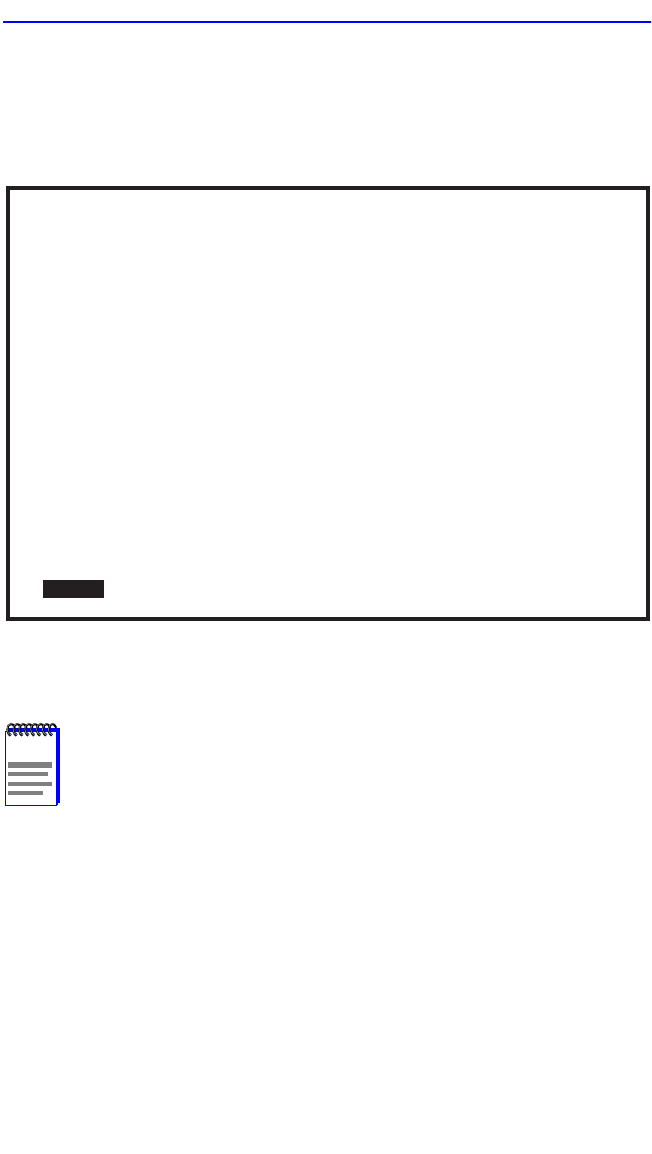
Flash Download Screen
6H128-08 and 6H129-08 User’s Guide 5-75
To access the Flash Download screen from the Module Specific
Configuration screen, use the arrow keys to highlight the FLASH
DOWNLOAD menu item and press ENTER. The Flash Download screen
displays.
Figure 5-28 Flash Download Screen
The following briefly explains each field of the Flash Download screen:
Download Method (Selectable)
This field steps between TFTP, RUNTIME and BOOTP. If set for
BOOTP, the module sends out a BootP request to determine the IP
address of the TFTP server and the filename of the image to be
downloaded. If set for TFTP or RUNTIME, the 6H12X-08 attempts a
TFTP download based on the IP address and filename entered in the fields
at the bottom of the Flash Download screen. Section 5.22.1 describes how
to download using TFTP. Section 5.22.2 describes how to download using
RUNTIME. Section 5.22.3 describes how to download using BootP.
NOTE Download Server IP and Download File Name are displayed
only when TFTP or RUNTIME are selected in Download
Method.
Firmware Revision: XX.XX.XX
Flash Download
Download Method:
Reboot After Download:
TFTP Gateway IP Addr:
Last Image Server IP:
Last Image File Name:
Download Server IP:
Download File Name:
2159-24
BOOTPROM Revision: XX.XX.XX
[TFTP]
[YES]
0.0.0.0
XXX.XXX.XXX.XXX
/tftpboot/6H128.hex
XXX.XXX.XXX.XXX
/tftpboot/6H128.hex
Module Type: 6H128-08
Slot Number:
X
EXIT
6H128-08 LOCAL MANAGEMENT
TFTP DOWNLOAD. WILL COMMIT TO FLASH. REBOOT IN PROGRESS...
EXECUTE RETURN

Chapter 5: Local Management
5-76 6H128-08 and 6H129-08 User’s Guide
Reboot After Download (Modifiable only when RUNTIME is chosen)
This field notifies the user that the 6H12X-08 will reboot after the
download is complete. If a RUNTIME Download is performed this field
toggles between YES and NO. If YES is selected, the module reboots
after the download is completed. If NO is selected the module will
continue using the existing the firmware image. The module stores the
new firmware image in FLASH memory. When the module or 6C105
chassis is reset, the module will boot from FLASH memory using the new
image.
TFTP Gateway IP Addr (Selectable)
This field shows the IP address of the TFTP gateway server defined in the
General Configuration screen in Section 5.15.4.
Last Image Server IP (Read-only)
This field shows the IP address of the server used for the previous FLASH
Download.
Last Image File Name (Read-only)
This field shows the complete path and file name of the last image
downloaded to FLASH.
Download Server IP (Selectable)
The IP address of the TFTP server to be used for the FLASH download is
entered in this field.
Download File Name (Selectable)
The complete TFTP Server path and file name of the new image is entered
in this field.
5.22.1 Image File Download Using TFTP
Set the 6H12X-08 to download to FLASH using TFTP as follows:
1. Use the arrow keys to highlight the Download Method field.
2. Use the SPACE bar to select TFTP.
3. Use the arrow keys to highlight the TFTP Gateway IP Addr field.
NOTE If TFTP or RUNTIME is selected as the download method
(Figure 5-28), the following two additional fields display:

Flash Download Screen
6H128-08 and 6H129-08 User’s Guide 5-77
4. Set the IP address of the TFTP gateway server (this defaults to the
same IP address as that set in the TFTP Gateway IP Addr field on the
General Configuration screen).
5. Use the arrow keys to highlight the Download Server IP field.
6. Enter the IP address of the TFTP server using the DDN format.
For example: 134.141.79.121
7. Use the arrow keys to highlight the Download File Name field.
8. Enter the complete path and file name of the image stored on the
download server.
For example: /tftpboot/6H128.hex
9. Use the arrow keys to highlight EXECUTE at the bottom of the screen
and press ENTER. The message “TFTP DOWNLOAD. WILL
COMMIT TO FLASH. REBOOT IN PROGRESS...” displays in the
event message line at the top of the screen and the new image is
downloaded into FLASH memory.
5.22.2 Image File Download Using RUNTIME
Set the 6H12X-08 to download to FLASH using RUNTIME as follows:
1. Use the arrow keys to highlight the Download Method field.
2. Use the SPACE bar to select RUNTIME.
3. Use the arrow keys to highlight the Reboot After Download field.
4. Use the SPACE bar to select either YES or NO. Select YES if you
want the module to reboot after the download is completed. Select NO
if you want the module to store the new image in FLASH memory
until the module is manually reset.
5. Use the arrow keys to highlight the TFTP Gateway IP Addr field.
6. Set the IP address of the TFTP gateway server (this defaults to the
same IP address as that set in the TFTP Gateway IP Addr field on the
General Configuration screen).
7. Use the arrow keys to highlight the Download Server IP field.

Chapter 5: Local Management
5-78 6H128-08 and 6H129-08 User’s Guide
8. Enter the IP address of the TFTP server using the DDN format.
For example: 134.141.79.121
9. Use the arrow keys to highlight the Download File Name field.
10. Enter the complete path and file name of the image stored on the
download server.
For example: /tftpboot/6H128.fls
11. Use the arrow keys to highlight EXECUTE at the bottom of the screen
and press ENTER. The message “RUNTIME DOWNLOAD. WILL
COMMIT TO FLASH.” displays in the event message line at the top
of the screen and the new image is downloaded into FLASH memory.
5.22.3 Image File Download Using BootP
Set the 6H12X-08 to download to FLASH using BootP as follows:
1. Use the arrow keys to highlight the Download Method field.
2. Use the SPACE bar to select BOOTP.
3. Use the arrow keys to highlight the TFTP Gateway IP Addr field. Set
the IP address of the TFTP gateway server (this defaults to the same
IP address set in the TFTP Gateway IP Addr field in the General
Configuration screen).
4. Use the arrow keys to highlight EXECUTE at the bottom of the screen
and press ENTER. The message “BOOTP DOWNLOAD. WILL
COMMIT TO FLASH. REBOOT IN PROGRESS...” displays in the
event message line at the top of the screen and the new image is
downloaded into FLASH memory.
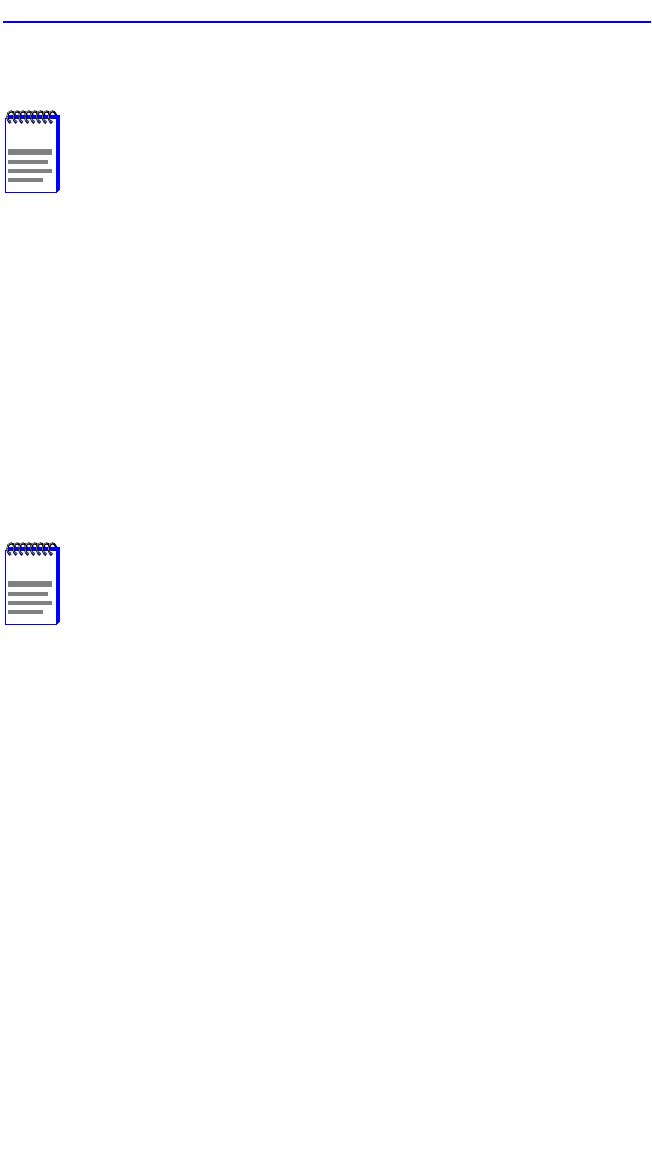
Port Redirect Function Screen
6H128-08 and 6H129-08 User’s Guide 5-79
5.23 PORT REDIRECT FUNCTION SCREEN
The Port Redirect Function screen, Figure 5-29 allows the user to set each
one of the ports on the 6H12X-08 as a source or destination port. A port
can be set to have one or more destination ports. For example, port 1 can
be set as a source port with three destinations, ports 2, 3, and 4. Traffic
from port 1 is then automatically redirected to ports 2, 3, and 4. Port 1 can
also serve as a destination port for other ports. The port redirect function
is extremely useful for troubleshooting purposes, as it allows traffic to be
sent to a particular port(s) where, with the use of an analyzer or RMON
probe, all current traffic from the source port(s) can be examined.
To access the Port Redirect Function screen from the Module Specific
Configuration screen, use the arrow keys to highlight the PORT
REDIRECT FUNCTION menu item and press ENTER. The Port
Redirect Function screen displays.
NOTE The Port Redirect Function screen may not be available
depending on the operational mode that has been set for the
module. Refer to the Release Notes to see what operational
modes support the Port Redirect Function. Refer to
Section 5.15.9 for instructions on configuring the operational
mode of the module.
NOTE Although all traffic from the source port (including, if desired,
errored frames) is sent to the destination port, normal switching
is still performed for all frames on the source port.

Chapter 5: Local Management
5-80 6H128-08 and 6H129-08 User’s Guide
Figure 5-29 Port Redirect Function Screen
The following definitions briefly explain each field of the Port Redirect
Function screen:
Source Port (Read-only)
Shows which ports are currently set as source ports.
Destination Port (Read-only)
Shows which ports are currently set as destination ports.
Remap Errors (Read-only)
Displays whether the corresponding source ports are configured to send
errored frames to the destination ports, or to drop all errored frames
before forwarding traffic.
Source Port [
n
] (Selectable)
Allows a selected port [n] to be changed to a source port.
Destination Port [
n
] (Selectable)
Allows a selected port [n] to be changed to a destination port.
Firmware Revision: XX.XX.XX
Port Redirect Function
2269_22
BOOTPROM Revision: XX.XX.XX
Source Port
----------------
1
1
1
2
2
3
3
3
Destination Port
---------------------
2
3
4
1
3
4
2
1
Module Type: 6H128-08
Slot Number:
X
Remap Errors
-------------------
ON
OFF
ON
OFF
ON
OFF
ON
OFF
6H128-08 LOCAL MANAGEMENT
Event Message Line
SAVE PREVIOUS
RETURN
RETURN
NEXT
Source Port [ 5] Destination Port [ 1] Status [ADD]
EXIT
Errors [ ON]

Port Redirect Function Screen
6H128-08 and 6H129-08 User’s Guide 5-81
Errors (Toggle)
Allows the user to configure the source ports to either send errored frames
to selected destination ports, or to drop errored frames, and send only
valid traffic to the destination ports. The default setting of this field is ON.
For information on how to change the default setting, refer to
Section 5.23.2.
Status (Selectable)
Allows you to add or delete the source and destination ports selected in
the Source Port [n] and Destination Port [n] fields.
5.23.1 Displaying the Source and Destination Entries
There can be more than one Port Redirect Function screen depending on
the number of port redirect entries. Each screen displays up to 10 port
redirect entries. If there is more than one screen of redirect entries, the
NEXT and/or PREVIOUS command is displayed at the bottom of the
screen, allowing the user to navigate to either the next or previous screen.
For example, with three screens of entries, the NEXT command is
displayed at the bottom of the first screen. In the second screen, the
NEXT and PREVIOUS commands are displayed. In the last screen, only
the PREVIOUS command is displayed.
To display the next screen, use the arrow keys to highlight NEXT. Press
ENTER and the next screen of entries is displayed.
To display the previous screen, use the arrow keys to highlight
PREVIOUS. Press ENTER to view the entries in the previous screen.
5.23.2 Changing Source and Destination Ports
Add or delete source port and destination port entries as follows:
1. Use the arrow keys to highlight the Source Port field.
2. Press the SPACE bar or BACKSPACE one or more times to increment
or decrement the port number displayed in the brackets [n] until the
appropriate port number is displayed.
3. Use the arrow keys to highlight the Destination Port field.
4. Use the SPACE bar or BACKSPACE to step to the appropriate port
number for the destination port.
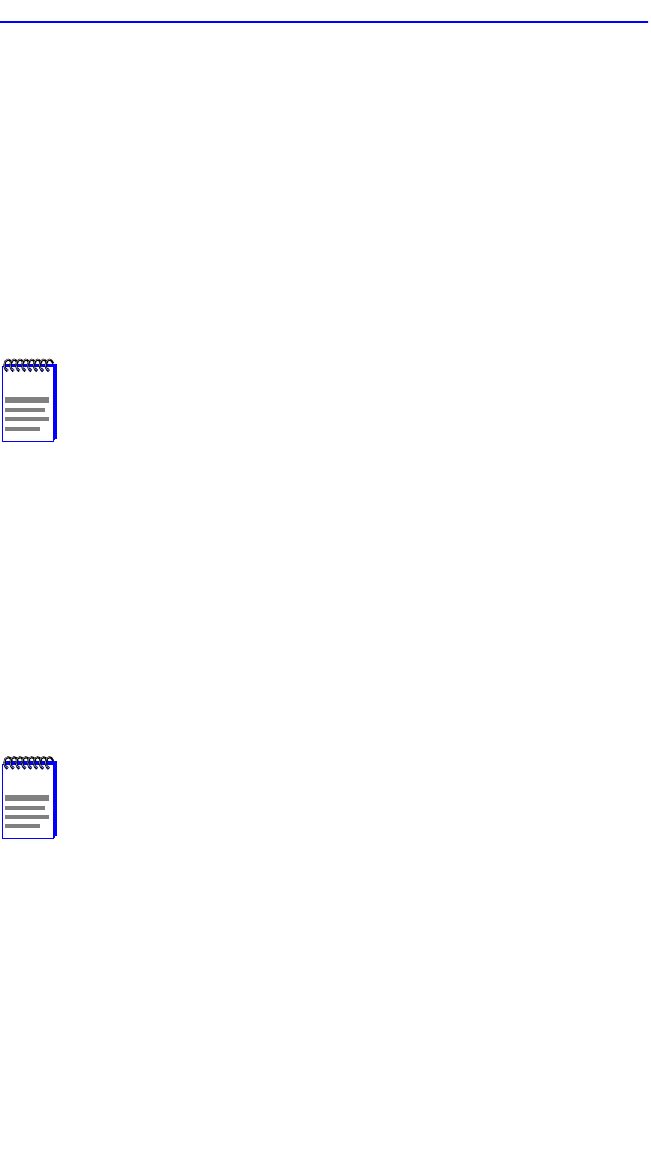
Chapter 5: Local Management
5-82 6H128-08 and 6H129-08 User’s Guide
5. Use the arrow keys to highlight the Errors field.
6. Use the SPACE bar to select either the ON or OFF option and press
ENTER. ON forces the source module and port to forward errored
frames and valid traffic to the destination module(s) and port(s). OFF
forces the errored frames to be dropped before forwarding traffic.
7. Use the arrow keys to highlight the Status field.
8. Use the SPACE bar to select either the ADD or DEL (delete) option.
Press ENTER. This adds or deletes the port selections made in steps 2
and 4 and also updates the screen Source Port and Destination Port list.
9. Use the arrow keys to highlight SAVE at the bottom of the screen.
Press ENTER. The message “SAVED OK” is displayed. This saves
the new settings and updates the Source Port and Destination Port
read-only fields.
5.24 BROADCAST SUPPRESSION SCREEN
The Broadcast Suppression screen, Figure 5-30 allows the user to set a
desired limit of receive broadcast frames per port per second. It also
displays statistics.
To access the Broadcast Suppression screen from the Module Specific
Configuration screen, use the arrow keys to highlight the BROADCAST
SUPPRESSION menu item and press ENTER. The Broadcast
Suppression screen displays.
NOTE If more than one port is to be redirected, repeat steps 1 through
8 for each additional setting, then go to step 9 to save all the
new settings at once.
NOTE The Broadcast Suppression screen may not be available if the
operational mode of the module has been set to SECURE
FAST VLAN. Refer to the Release Notes to see what
operational modes support Broadcast Suppression. Refer to
Section 5.15.9 for instructions on configuring the operational
mode of the module.
Any broadcast frames received above the desired threshold will
be dropped.

Broadcast Suppression Screen
6H128-08 and 6H129-08 User’s Guide 5-83
Figure 5-30 Broadcast Suppression Screen
The following explains each field of the Broadcast Suppression screen:
Port # (Read-only)
Identifies the number of the port.
Total RX (Read-Only)
Displays the total number of broadcast frames received.
Peak Rate (Read-Only)
Displays the number of broadcast frames received per second.
Time Since Peak (Read-Only)
Displays the time since peak broadcast frames received.
Threshold (Modifiable)
Allows the user to set, in increments of ten, the desired limit of receive
broadcast frames that will be forwarded per port per second.
Reset Peak (Modifiable)
Allows the user to reset the peak rate. The Time Since Peak field will also
reset. The Reset Peak field toggles between YES and NO.
Firmware Revision: XX.XX.XX
Broadcast Suppression
2159-25
BOOTPROM Revision: XX.XX.XX
Port #
1
2
3
4
5
6
7
8
Time Since Peak
999:23:59
999:23:59
999:23:59
999:23:59
999:23:59
999:23:59
999:23:59
999:23:59
Peak Rate
150000
150000
150000
150000
150000
150000
150000
150000
Threshold
150000
150000
150000
150000
150000
150000
150000
150000
Module Type: 6H128-08
Slot Number:
X
6H128-08 LOCAL MANAGEMENT
Event Message Line
Total RX
12345678910
12345678910
12345678910
12345678910
12345678910
12345678910
12345678910
12345678910
Reset Peak
[NO]
[NO]
[NO]
[NO]
[NO]
[NO]
[NO]
[NO]
RETURN
SAVE EXIT

Chapter 5: Local Management
5-84 6H128-08 and 6H129-08 User’s Guide
5.24.1 Setting the Threshold
To set the Threshold, proceed as follows:
1. Use the arrow keys to highlight the Threshold field for the selected
port.
2. Type in the numbers for the desired limit in increments of 10 (for
example, 10, 20, 30, etc.).
3. Use the arrow keys to highlight the SAVE command at the bottom of
the screen.
4. Press ENTER. The message “SAVED OK” is displayed.
5.24.2 Setting the Reset Peak Switch
To set the Reset Peak Switch field to YES or NO, proceed as follows:
1. Use the arrow keys to highlight the Reset Peak field for the selected
port.
2. Press the SPACE bar to select YES or NO.
3. Use the arrows keys to highlight the SAVE command at the bottom of
the screen.
4. Press ENTER. The message “SAVED OK” displays, the Time Since
Peak counter is reset to zero, and the screen is refreshed.
5.25 MODULE STATISTICS MENU SCREEN
The Module Statistics Menu screen, Figure 5-31, provides access to
screens that allow the user to obtain switch statistics about frame traffic
through each interface, to view MIB-II statistics from each interface, and
to view RMON Statistics gathered by the RMON agent embedded in the
6H12X-08.
NOTE The following menu item on the Module Statistics Menu screen
will not display if the operational mode of the module has been
set to SECURE FAST VLAN:
SWITCH STATISTICS
Section 5.15.9 provides instructions on setting the operational
mode.

Module Statistics Menu Screen
6H128-08 and 6H129-08 User’s Guide 5-85
To access the Module Statistics Menu from the Module Menu screen, use
the arrow keys to highlight the MODULE STATISTICS menu item and
press ENTER. The Module Statistics Menu screen displays.
Figure 5-31 Module Statistics Menu Screen
The Module Statistics Menu screen displays the following menu items:
SWITCH STATISTICS
The Switch Statistics screen lists the number of frames received,
transmitted, filtered, and forwarded by each port. For details refer to
Section 5.26.
INTERFACE STATISTICS
The Interface Statistics screen provides the MIB-II statistics for each
switched interface, on an interface-by-interface basis. For details, refer to
Section 5.27.
RMON STATISTICS
The RMON Statistics screen displays all the statistics gathered by the
embedded RMON agent built into the 6H12X-08. For details, refer to
Section 5.28.
Firmware Revision: XX.XX.XX
Module Statistics Menu
SWITCH STATISTICS
INTERFACE STATISTICS
RMON STATISTICS
22511-67
Module Type: 6H128-08
BOOTPROM Revision: XX.XX.XX
6H128-08 LOCAL MANAGEMENT
EXIT RETURN
Slot Number:
X

Chapter 5: Local Management
5-86 6H128-08 and 6H129-08 User’s Guide
5.26 SWITCH STATISTICS SCREEN
The Switch Statistics screen, Figure 5-32, lists the number of frames
received, transmitted, filtered, and forwarded by each interface, including
backplane interfaces.
To access the Switch Statistics screen from the Module Statistics Menu
screen, use the arrow keys to highlight the SWITCH STATISTICS menu
item and press ENTER. The Switch Statistics screen displays.
Figure 5-32 Switch Statistics Screen
NOTE The Switch Statistics screen will not be available if the
operational mode of the module has been set to SECURE
FAST VLAN. This screen may only be used by modules
configured to operate as traditional or 802.1Q switches.
Ports 7 and 8 on the Switch Statistics screen represent the
optional Fast Ethernet Interface Modules available for the
6H12X-08.
Ports 9 throught 12 represent the backplane connections that
the 6H12X-08 has with the 6C105 chassis. The module has a
direct connection to every other slot in the chassis.
Firmware Revision: XX.XX.XX
Switch Statistics
2269_26
BOOTPROM Revision: XX.XX.XX
RETURN
Module Type: 6H128-08
Slot Number:
X
6H128-08 LOCAL MANAGEMENT
Event Message Line
Port #
1
2
3
4
5
6
7
8
9
10
11
12
Frames Rcvd
100
100
100
100
100
100
100
100
100
100
100
100
Frames Txmtd
100
100
100
100
100
100
100
100
100
100
100
100
Frames Fltrd
0
0
0
0
0
0
0
0
0
0
0
0
Frames Frwded
100
100
100
100
100
100
100
100
100
100
100
100
CLEAR COUNTERS EXIT

Switch Statistics Screen
6H128-08 and 6H129-08 User’s Guide 5-87
The Switch Statistics screen displays the following fields:
Port # (Read-Only)
Identifies the port number.
Frames Rcvd (Read-Only)
Displays the number of frames received by the port.
Frames Txmtd (Read-Only)
Displays the number of frames transmitted by the port.
Frames Fltrd (Read-Only)
Displays the number of frames filtered by the port.
Frames Frwded (Read-Only)
Displays the number of frames forwarded by the port.
CLEAR COUNTERS (Command)
This command is used to reset all statistic counters to zero. For details on
how to use this field, refer to Section 5.26.1.
5.26.1 Using the Clear Counters Command
To reset all the statistics counters to zero, perform the following steps:
1. Use the arrow keys to highlight the CLEAR COUNTERS field.
2. Press ENTER, the counters of all the ports displayed are reset to zero.

Chapter 5: Local Management
5-88 6H128-08 and 6H129-08 User’s Guide
5.27 INTERFACE STATISTICS SCREEN
The Interface Statistics screen is used to gather MIB-II statistics for all of
the 6H12X-08 interfaces (ports 1 through 6, optional Fast Ethernet
Interface Modules, and all backplane interfaces).
To access the Interface Statistics screen, use the arrow keys to highlight
the INTERFACE STATISTICS field on the Module Statistics Menu
screen and press ENTER. The Interface Statistics screen, Figure 5-33,
displays.
Figure 5-33 Interface Statistics Screen
The following definitions explain each field of the Interface Statistics
screen:
Interface (Read-only)
This field displays the Interface number for which statistics are currently
being displayed. Figure 5-33 shows the Interface field displaying 1. This
represents Port 1 of the module. To view other interface statistics refer to
Section 5.27.1.
Firmware Revision: XX.XX.XX
Interface Statistics
BOOTPROM Revision: XX.XX.XX
RETURN
Module Type: 6H128-08
Slot Number:
X
6H128-08 LOCAL MANAGEMENT
Event Message Line
Interface: [ 1]
InOctets:
InUnicast:
InNonUnicast:
InDiscards:
InErrors:
InUnknownProtos:
OutOctets:
OutUnicast:
OutNonUnicast:
OutDiscards:
OutErrors:
OutQLen:
Name: Fast Ethernet Frontpanel
7500456
6789
0
0
0
0
0
0
0
0
0
0
CLEAR COUNTERS EXIT
Interface: 1
Address:
Last Change:
Admin Status:
Oper Status:
MTU:
Speed:
Link Status:
Duplex Mode:
00-00-00-00-00-00
xx days 00:00:00
UP
UP
1514
100000000
NO LINK
STANDARD

Interface Statistics Screen
6H128-08 and 6H129-08 User’s Guide 5-89
Name (Read-only)
The Name field displays the type of interface for which statistics are
being displayed.
InOctets (Read-only)
This field displays the total number of octets (bytes) that have been
received on the interface. This includes all octets from bad frames, and
framing characters.
InUnicast (Read-only)
The InUnicast field displays the total number of frames that have been
received that were sent to a single address.
InNonUnicast (Read-only)
This field displays the total number of frames that have been received that
were delivered to a broadcast or multicast address.
InDiscards (Read-only)
The InDiscards field displays the total number of inbound frames that
were discarded, even though the frames contained no errors. This field
may increment because the switch needed to free up buffer space, or the
switch was being overutilized.
InErrors (Read-only)
This field displays the total number of inbound frames that have been
discarded because they contained errors. This field represents the total
number of errored frames, regardless of the cause of the error.
InUnknownProtos (Read-only)
The InUnknownProtos field displays the total number of frames that were
discarded because the frames were in an unknown, or unsupported,
format.
OutOctets (Read-only)
This field displays the total number of octets (bytes) that have been
transmitted from the Interface. This includes all Frame Check Sequence
(FCS) octets.
OutUnicast (Read-only)
The OutUnicast field displays the total number of frames transmitted that
were sent to a single address.

Chapter 5: Local Management
5-90 6H128-08 and 6H129-08 User’s Guide
OutNonUnicast (Read-only)
This field displays the total number of frames transmitted to a broadcast
or multicast address.
OutDiscards (Read-only)
The OutDiscards field displays the total number of outbound frames that
were discarded, even though the frames contained no errors. This field
may increment, because the switch needed to free up buffer space, or the
switch was being overutilized.
OutErrors (Read-only)
This field displays the total number of outbound frames discarded
because they contained errors. This field represents the total number of
errored frames, regardless of the cause of the error.
OutQLen (Read-only)
The OutQLen field displays the length of the packet queue. The field
represents the number of frames that can be contained in the queue.
Address (Read-only)
This field displays the MAC Address of the interface that is currently
being displayed.
Last Change (Read-only)
This field displays the last time that the interface was reset.
Admin Status (Read-only)
This field displays the current status of the interface. If this field displays
“Testing”, no frames may be passed on this interface.
Oper Status (Read-only)
This field displays the current status of the interface. If this field displays
“Testing”, no frames may be passed on this interface.
MTU (Read-only)
The MTU field displays the maximum frame size (in octets) that a frame
may contain to be received or transmitted from this interface.
Speed (Read-only)
The Speed field displays an estimate of the interface’s current bandwidth
in bits per second.

Interface Statistics Screen
6H128-08 and 6H129-08 User’s Guide 5-91
Link Status (Read-only)
This field displays the current link status of the interface. This field will
read either “Link” or “No Link”.
Duplex Mode (Read-only)
This field indicates whether the interface is operating in normal or full
duplex mode. This field will read either “Standard” or “Full Duplex”.
Interface [nn] (Command)
This command is used to enter an interface number for viewing statistics.
For instructions on how to use this command, refer to Section 5.27.1.
CLEAR COUNTERS (Command)
This command is used to reset all statistic counters to zero. For details on
how to use this field, refer to Section 5.27.2.
5.27.1 Displaying Interface Statistics
To display the statistics for any interface, proceed as follows:
1. Use the arrow keys to highlight the Interface [nn] field at the bottom
of the screen.
2. Press the SPACE bar to increment (or press the DEL [delete] or
BACKSPACE key to decrement) the interface number.
3. Press ENTER (neither the Interface # field nor the statistics will
change until ENTER is pressed).
5.27.2 Using the Clear Counters Command
To reset all the statistics counters of the selected interface to zero, perform
the following steps:
1. Use the arrow keys to highlight the CLEAR COUNTERS command.
2. Press ENTER, the counters for the selected interface are reset to zero.

Chapter 5: Local Management
5-92 6H128-08 and 6H129-08 User’s Guide
5.28 RMON STATISTICS SCREEN
RMON statistics for each interface, on a interface-by-interface basis, are
viewed through the RMON Statistics screen shown in Figure 5-34.
To access the RMON Statistics screen, use the arrow keys to highlight the
RMON STATISTICS menu item on the Module Statistics Menu screen,
and press ENTER. The RMON Statistics screen displays.
Figure 5-34 RMON Statistics Screen
The following definitions explain each field of the RMON Statistics
screen:
RMON Index (Read-only)
This field displays the current Ethernet interface for which statistics are
being shown. The 6H12X-08 has an embedded RMON agent that gathers
statistics for each interface on the module.
Firmware Revision: XX.XX.XX
RMON Statistics
2269_65
BOOTPROM Revision: XX.XX.XX
RETURN
Module Type: 6H128-08
Slot Number:
X
RMON Index: 1
Data Source: IfIndex.1
Drop Events:
Collisions:
Broadcast Pkts:
Multicasts:
CRC Align Errors:
Undersized Pkts:
Oversized Pkts:
Fragments:
Jabbers:
0
0
0
0
0
0
0
0
0
6H128-08 LOCAL MANAGEMENT
Event Message Line
Index: [ 1] CLEAR COUNTERS EXIT
Owner: monitor
Status: valid
Total Packets:
Total Octets:
64 Octets:
65 - 127 Octets:
128 - 255 Octets:
256 - 511 Octets:
512 - 1023 Octets:
1024 - 1518 Octets:
0
0
0
0
0
0
0
0

RMON Statistics Screen
6H128-08 and 6H129-08 User’s Guide 5-93
Data Source (Read-only)
This field displays the source of the statistics data that is currently being
displayed on the screen. Figure 5-34 shows that the data source for this
RMON index is Interface 1 (Port 1) by displaying the name IfIndex.1. If
the screen was displaying RMON statistics for Interface 4 (Port 4), the
name displayed would be IfIndex.4.
Owner (Read-only)
This field displays the name of the entity that last configured this entry.
Status (Read-only)
The Status field displays the current operating status of the displayed
interface. This field will display “Valid” or “Invalid”.
Drop Events (Read-only)
This field displays the total number of times that the RMON agent was
forced to discard frames due to the lack of available switch resources.
Collisions (Read-only)
This field displays the total number of collisions that have occurred on
this interface.
Broadcast Pkts (Read-only)
The Broadcast Pkts field displays the total number of good frames that
were directed to the broadcast address. The value of this field does not
include multicast frames.
Multicasts (Read-only)
The Multicasts field displays the total number of good frames received
that were directed to a multicast address. The value of this field does not
include frames directed to the broadcast address.
CRC Align Errors (Read-only)
This field displays the number of frames with bad Cyclic Redundancy
Checks (CRC) received from the network. The CRC is a 4-byte field in
the data packet that ensures that the data received is the same as the data
that was originally sent.
NOTE The Drop Events field does not display the number of frames
dropped, it only displays the number of times that the RMON
agent was forced to discard frames.

Chapter 5: Local Management
5-94 6H128-08 and 6H129-08 User’s Guide
Undersized Pkts (Read-only)
The Undersized Pkts field displays the number of frames received whose
size was less than the minimum Ethernet frame size of 64 bytes, not
including preamble, but have a valid CRC.
Oversized Pkts (Read-only)
The Oversized Pkts field displays the number of frames received whose
size exceeded 1518 data bytes, not including preamble, but have a valid
CRC.
Fragments (Read-only)
This field displays the number of received frames that are not the
minimum number of bytes in length or received frames that had a bad
Frame Check Sequence (FCS), were less than 64 bytes in length
(excluding framing bits, but including FCS bytes), and have an invalid
CRC.
Jabbers (Read-only)
This field displays the total number of frames that were greater than 1518
bytes and had either a bad FCS or a bad CRC.
Total Packets (Read-only)
This field displays the total number of frames (including bad frames,
broadcast frames, and multicast frames) received on this interface.
Total Octets (Read-only)
This field displays the total number of octets (bytes) of data, including
those in bad frames, received on this interface.
64 Octets (Read-only)
Displays the total number of frames including bad frames, received that
were 64 bytes in length (excluding framing bits, but including FCS bytes).
65 - 127 Octets (Read-only)
Displays the total number of frames, including bad frames, received that
were between 65 and 127 bytes in length (excluding framing bits, but
including FCS bytes).
NOTE It is normal for the Fragments field to increment. This is
because the RMON agent increments the field when runts are
detected (which are normal occurrences due to collisions) and
when noise hits occur.

RMON Statistics Screen
6H128-08 and 6H129-08 User’s Guide 5-95
128 - 255 Octets (Read-only)
Displays the total number of frames, including bad frames, received that
were between 128 and 255 bytes in length (excluding framing bits, but
including FCS bytes).
256 - 511 Octets (Read-only)
Displays the total number of frames, including bad frames, received that
were between 256 and 511 bytes in length (excluding framing bits, but
including FCS bytes).
512 - 1023 Octets (Read-only)
Displays the total number of frames, including bad frames, received that
were between 512 and 1023 bytes in length (excluding framing bits, but
including FCS bytes).
1024 - 1518 Octets (Read-only)
Displays the total number of frames, including bad frames, received that
were between 1024 and 1518 bytes in length (excluding framing bits, but
including FCS bytes).
Index: [nn] (Command)
This command is used to enter an index number for viewing statistics. For
instructions on how to use this command refer to Section 5.28.1.
CLEAR COUNTERS (Command)
This command is used to reset all statistic counters to zero. For details on
how to use this field, refer to Section 5.28.2.
5.28.1 Displaying RMON Statistics
To display the statistics for any index, proceed as follows:
1. Use the arrow keys to highlight the Index: [nn] field at the bottom of
the screen.
2. Press the SPACE bar to increment (or press the DEL [delete] key or
the BACKSPACE key to decrement) the index number.
3. Press ENTER (neither the RMON Index field nor the statistics will
change until ENTER is pressed).

Chapter 5: Local Management
5-96 6H128-08 and 6H129-08 User’s Guide
5.28.2 Using the Clear Counters Command
To reset all the statistics counters of the selected interface to zero, perform
the following steps:
1. Use the arrow keys to highlight the CLEAR COUNTERS field.
2. Press ENTER, the counters for the selected index are reset to zero.
5.29 NETWORK TOOLS
The Network Tools function resides on the 6H12X-08 and allows the user
to access and manage network devices.
To access the Network Tools screen, use the arrow keys to highlight the
NETWORK TOOLS menu item in the Module Menu screen, and press
ENTER. The Network Tools screen displays. See Figure 5-35.
Figure 5-35 Network Tools Help Screen
TIP
Type help at the prompt to list all the commands that are
available for the module in the current operational mode. See
Figure 5-35. A command used incorrectly (wrong syntax), will
prompt a display of the correct usage. Use lower case when
entering commands in Network Tools.
-> help
Commands Available to the User:
Built in commands:
090829
For help with a specific command, type 'help <command>'.
arp
netstat
show traceroute
defroute
ping reset
bridge
SPECIAL:
done, quit, or exit - Exit from the Network Tools.
->
Welcome to Network Tools
soft_reset telnet link_trap

Network Tools
6H128-08 and 6H129-08 User’s Guide 5-97
The Network Tools functions are performed using a series of commands.
Entering commands in Network Tools involves typing the command to be
executed at the Network Tools prompt, adding any desired or required
extensions, and pressing ENTER.
There are two categories of commands in the command set.
•Built-in Commands - Allow the user to access and manage network
devices. The commands are: arp, bridge, defroute, netstat, ping,
reset, show, traceroute, soft-reset, telnet, and link_trap.
•Special Commands - Allow the user to exit from Network Tools. The
commands are done, quit, and exit.
The commands are presented in the following format:
command:
Syntax: Shows the required command format. It
indicates where arguments, if any, must be
specified.
Description: Briefly describes the command and its uses.
Options: Lists any additional fields in the appropriate
format which may be added to the command.
Example: Shows an example of the command.
NOTE The conventions used here to describe Network Tools are as
follows:
Arguments enclosed by [ ] are required.
Arguments enclosed by < > are optional.
In the following command examples, information entered by the
user is in bold Helvetica font.
To abort the output or interrupt a process, press the CONTROL
key and c key simultaneously, designated as ^C here.

Chapter 5: Local Management
5-98 6H128-08 and 6H129-08 User’s Guide
5.29.1 Built-In Commands
The built-in commands listed in this section activate functions on the LM
managed device or devices being accessed through Network Tools.
arp:
Syntax: arp [options]
Description: The arp command provides access to the ARP
(Address Resolution Protocol) cache, enabling
you to view cache data, delete entries, or add a
static route. Super-User access is required to
delete an entry or add a static route.
Each ARP cache entry lists the network
interface that the device is connected to, the
device’s network address or IP address, the
device’s physical address or MAC address, and
the media type of connection to the device.
Media types are displayed as numbers, which
stand for the following states:
1 - Other
2 - Invalid entry (cannot ping device, timed out,
etc.)
3 - Dynamic route entry
4 - Static route entry (not subject to change)
You can specify the arp command with one of the following options:
Options: -a Views cache data
-d Deletes an IP address entry. Requires
additional arguments: [Interface Number]
[IP address]
-s Adds a static entry. Requires additional
arguments: [Interface Number] [IP address]
[MAC address]
-f Flushes the ARP cache

Network Tools
6H128-08 and 6H129-08 User’s Guide 5-99
Example:
bridge:
Syntax: bridge [ENABLE/DISABLE] [IFNUM/ALL]
Description: The bridge command allows each bridge port to
be enabled or disabled at the user’s request,
either one at a time or all at once. Specifying a
single interface number will affect the bridging
status of that interface, while specifying ALL
will affect every interface.
Options: Not Applicable
Example:
-> arp -a
# Interface
# (SonicInt)
# (SonicInt)
# (SonicInt)
# (SonicInt)
Network Address
122.144.40.111
122.144.48.109
122.144.52.68
122.144.21.43
Physical Address
00.00.0e.12.3c.04
00.00.0e.f3.3d.14
00.00.0e.12.3c.04
00.00.0e.03.1d.3c
Media Type
3(dynamic)
3(dynamic)
3(dynamic)
3(dynamic)
-> arp -d 1 122.144.52.68
-> arp -s 1 22.44.2.3 00:00:0e:03:1d:3c
051467
-> arp -f
-> bridge disable all
-> bridge enable 1
051468
-> bridge disable 1

Chapter 5: Local Management
5-100 6H128-08 and 6H129-08 User’s Guide
defroute:
Syntax: defroute [interface number] [IP address]
Description: The defroute command allows the user to view,
set or delete the default IP route to a managed
device through the specified interface.
Options: Not Applicable
Example:
netstat:
Syntax: netstat [option]
Description: The netstat command provides a display of
general network statistics for the managed
device. The netstat command must be used with
one of the two display options.
Options: -i Displays status and capability information for
each interface
-r Displays routing information for each
interface
-> defroute 2 147.152.42.32
# Default route is 147.152.42.32 on interface 2
-> defroute
# Default route is 147.152.42.32 on interface 2
-> defroute delete
# Default route is not currently set.
->
05141-69

Network Tools
6H128-08 and 6H129-08 User’s Guide 5-101
Example:
ping:
Syntax: ping [IP address]
Description: The ping command generates an outbound ping
request to check the status (alive/not alive) of a
device at a specified IP address.
Options: Not Applicable
Example:
-> netstat -i
Interface + Description
# 1 (ethernet -csmacd)
# 2 (ethernet - csmacd)
# 3 (ethernet - csmacd)
# 4 (ethernet - csmacd)
MTU
1514
1514
1514
1514
MAC Addr
0x00 0x00 0x1d 0x07 0x50 0x0e
0x00 0x00 0x1d 0x07 0x50 0x0f
0x00 0x00 0x1d 0x07 0x50 0x10
0x00 0x00 0x1d 0x07 0x50 0x11
Admin
up
up
up
up
-> netstat -r
051470
Speed
10000000
10000000
10000000
10000000
Oper
up
up
up
up
Destination
# Default Route
# 134.141.0.0
# 134.141.0.0
Next-hop
DirectConnection
DirectConnection
DirectConnection
Interface
1
2
3
-> ping 122.144.40.10
122.144.40.10 is alive
051471
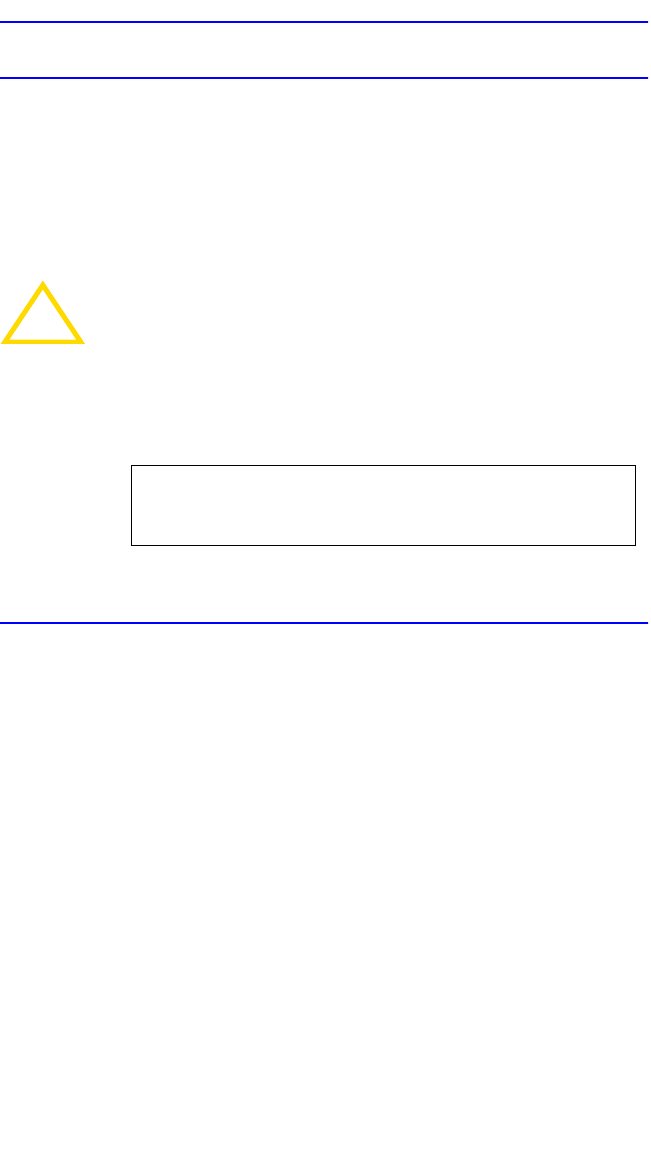
Chapter 5: Local Management
5-102 6H128-08 and 6H129-08 User’s Guide
reset:
Syntax: reset
Description: The reset command allows a soft reset of the
device. The user will be queried to confirm the
reset command to insure against unwanted
resets.
Options: Not Applicable
Example:
show:
Syntax: show [PROTOCOL] [TABLE]
Description: The show command displays information
concerning various components of the device.
Protocols currently supported are IP, IPX,
DECnet, and AppleTalk. Components of those
protocols that are currently supported are ARP
caches, route tables, FIB tables, server tables,
and interface tables. The number of valid
entries in the table will be displayed at the end
of the table display.
Options: Not Applicable
!
CAUTION
The Network Tools connection to the module will be terminated
upon execution of this command.
-> reset
RESET: Are you *SURE* ? -> Y
reset

Network Tools
6H128-08 and 6H129-08 User’s Guide 5-103
Example:
traceroute:
Syntax: traceroute [IP address]
Description: The traceroute command generates a
TRACEROUTE request to a specified IP
address and provides a display of all next-hop
routers in the path to the device. If the device is
not reached, the command displays all next-hop
routers to the point of failure.
Options: Not Applicable.
Example:
-> show Appletalk interfaces
-> show IP ARP
174246
# Interface
# 1
# 2
AdminStatus
enabled
disabled
Framing
ethernet
ethernet
MTU
1500
1500
OperStatus
enabled
disabled
Forwarding
enabled
disabled
# Interface
# 3
# 4
#
# Number of valid entries: 2
MediaType
3 (dynamic)
3 (dynamic)
PhysicalAddress
00:00:1d:04:40:5d
08:00:20:0e:d8:31
NetworkAddress
123.456.40.1
123.456.40.30
-> traceroute 122.144.11.52
# next-hop[0] : 122.144.60.45
# next-hop[1] : 122.144.8.113
051477
# next-hop[2] : 122.144.61.45
# 122.144.11.52 is alive : 3 hops away.
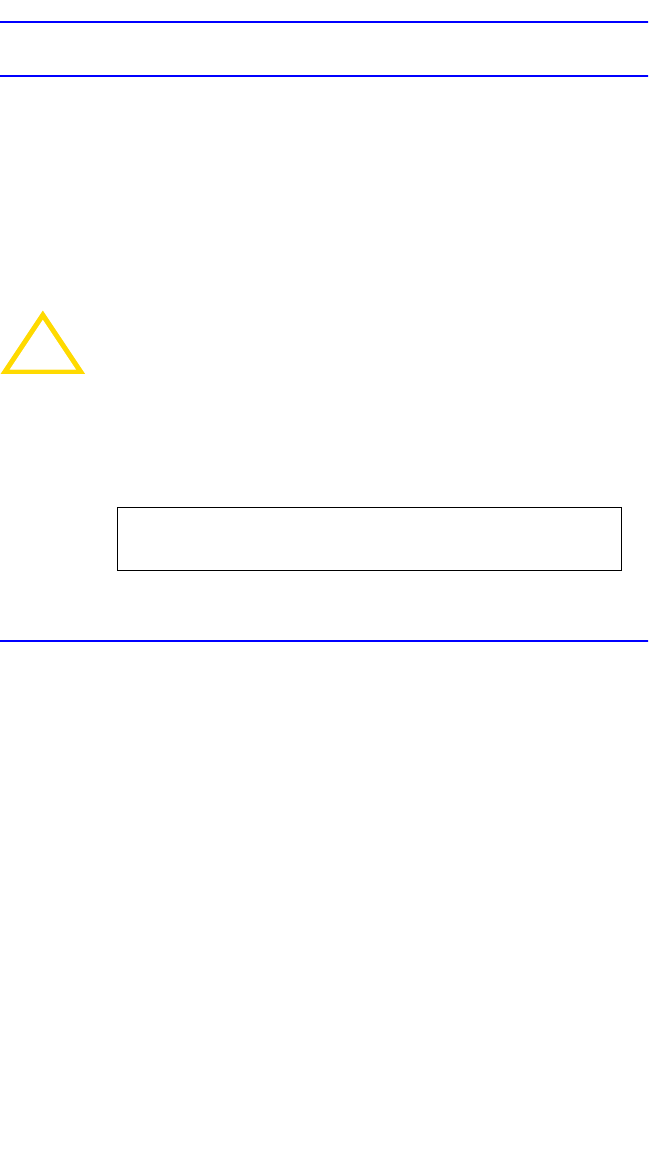
Chapter 5: Local Management
5-104 6H128-08 and 6H129-08 User’s Guide
soft_reset:
Syntax: soft_reset
Description: This command restarts the software image,
which restores the user configuration settings
from NVRAM. The user will be queried to
confirm the reset command to ensure against
unwanted resets.
Options: Not Applicable
Example:
telnet:
Syntax: telnet [IP address] <Port #>
Description: The telnet command allows the user to
communicate with another host (that supports
Telnet connections) using the Telnet protocol.
The user must specify the remote host using its
IP address. The [IP Address] field is mandatory.
If no Port number is specified, telnet will
attempt to contact the host at the default port.
Options: Not Applicable
!
CAUTION
The Network Tools connection to the module will be terminated
upon execution of this command.
-> soft_reset
RESET: Are you *SURE* ? -> Y
s_reset

Network Tools
6H128-08 and 6H129-08 User’s Guide 5-105
Example:
link_trap:
Syntax: link_trap [enable/disable/status] <PORT/all>
Description: The link_trap command allows link traps to be
enabled or disabled when specifying a single
port, or simultaneously when specifying “all”
or no ports. When one or all ports are specified
to enable, disable, or find their status, their
current condition is displayed.
Options: Not Applicable
Example:
->telnet 134.141.12.345
Trying 134.141.12.345
Connected to 134.141.12.345
SunOS UNIX (server1)
login:
099999
-> link_trap status
Port 1 is ENABLED
Port 3 is ENABLED
Port 5 is ENABLED
Port 7 is DISABLED
Port 2 is ENABLED
Port 4 is ENABLED
Port 6 is DISABLED
Port 8 is DISABLED
linktrap
LINK TRAP STATUS:
-> link_trap disable 2
-> link_trap disable all
-> link_trap status 3
Link traps have been DISABLED on port 2
Link traps have been DISABLED on all ports (1-8)
Link traps are ENABLED on port 3

Chapter 5: Local Management
5-106 6H128-08 and 6H129-08 User’s Guide
5.29.2 Special Commands
done, quit, exit:
Syntax: done
Description: The done command enables the user to exit
from Network Tools and return to the Main
Menu screen.
Options: Not Applicable
Example:
-> done
051472

6H128-08 and 6H129-08 User’s Guide A-1
APPENDIX A
SPECIFICATIONS
This appendix provides operating specifications for the Cabletron
Systems 6H128-08 and 6H129-08 Interface Modules. Cabletron Systems
reserves the right to change these specifications at any time without
notice.
A.1 DEVICE SPECIFICATIONS
A.2 PHYSICAL PROPERTIES
A.3 ENVIRONMENTAL REQUIREMENTS
Processor: Intel i960 RISC processor
Dynamic Random Access
Memory (DRAM): 16 MB
FLASH Memory: 4 MB
Dimensions: 43.87 H x 5.71 W x 27.88 D (cm)
18.28 H x 2.38 W x 11.62 D (in)
Weight (Unit): 2.72 kg (6 lb)
MTBF (Predicted): 200,000 hours
Operating Temperature: 5°C to 40°C (41°F to 104°F)
Storage Temperature: -30°C to 73°C (-22°F to 164°F)
Operating Relative Humidity: 5% to 90% (non-condensing)

Appendix A: Specifications
A-2 6H128-08 and 6H129-08 User’s Guide
A.4 INPUT/OUTPUT PORTS
6H128-08 and 6H129-08 Specifications
A.5 COM PORT PINOUT ASSIGNMENTS
The COM port is a serial communications port that supports Local
Management or connection to a UPS.
The COM port has the following pin assignments:
Ports 1 through 6 Fast Ethernet (100BASE-FX compliant)
with SC type connectors. 6H128-08 uses
multimode fiber, and the 6H129-08 uses
single mode fiber.
Slots for optional Fast
Ethernet Interface Modules
(ports 7 and 8)
Slots accept optional Fast Ethernet
Interface Modules: the FE100-TX,
FE100-FX and the FE-100F3, also check
the Release Notes for other Modules that
may be available.
Table A-1 COM Port Pin Assignments
Pin Signal Name Input/Output
1 Transmit Data (XMT) Output
2 Data Carrier Detect (DCD) Output
3 Data Set Ready (DSR) Input
4 Receive Data (RCV) Input
5 Signal Ground (GND) NA
6 Data Terminal Ready (DTR) Output
7 Request to Send (RTS) Input
8 Clear to Send (CTS) NA

Regulatory Compliance
6H128-08 and 6H129-08 User’s Guide A-3
A.6 REGULATORY COMPLIANCE
This equipment meets the following safety and electromagnetic
compatibility (EMC) requirements:
Safety UL 1950, CSA C22.2 No. 950,
EN 60950, IEC 950 and 73/23/EEC
Electromagnetic Compatibility FCC Part 15, EN 50082-1, EN 55022,
VCCI V-3, CSA C108.8, AS/NZS 3548
and 89/336/EEC

Appendix A: Specifications
A-4 6H128-08 and 6H129-08 User’s Guide
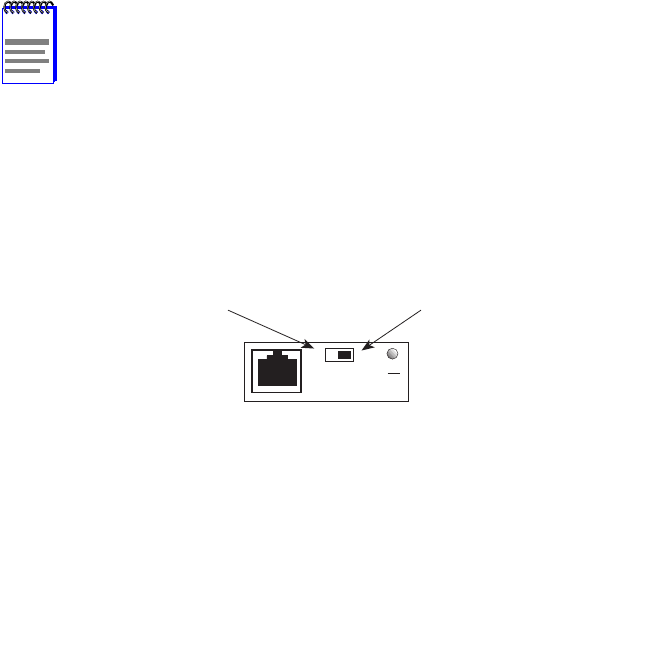
6H128-08 and 6H129-08 User’s Guide B-1
APPENDIX B
FE-100TX, FE-100FX AND FE-100F3
SPECIFICATIONS
The 6H12X-08 supports three Fast Ethernet Interface Modules:
•FE-100TX (Section B.1)
•FE-100FX (Section B.2)
•FE-100F3 (Section B.3)
This appendix provides the specifications for these modules.
B.1 FE-100TX
The slide switch on the FE-100TX determines the crossover status of the
cable pairs. If the switch is on the X side, the pairs are internally crossed
over. If the switch is on the = side, the pairs are not internally crossed
over. Figure B-1 shows the pinouts for the FE-100TX in both positions.
Figure B-1 FE-100TX Pinouts
NOTE The FE-100TX uses an RJ45 connector supporting Unshielded
Twisted Pair (UTP) cabling, which has an impedance of 85 to
111 ohms.
Position X
(crossed over)
1. RX+
2. RX-
3. TX+
4. NC
5. NC
6. TX-
7. NC
8. NC
Position =
(not crossed over)
1. TX+
2. TX-
3. RX+
4. NC
5. NC
6. RX-
7. NC
8. NC
FE-100TX
10
16651_05
100
=
x

Appendix B: FE-100TX, FE-100FX and FE-100F3 Specifications
B-2 6H128-08 and 6H129-08 User’s Guide
B.1.1 Auto-Negotiation
When using the optional FE-100TX Fast Ethernet Interface Modules,
these twisted pair ports have the ability to auto-negotiate the type of
connection required to provide a link to another device. During
Auto-Negotiation, two devices automatically exchange information
“telling” each other what their operating capabilities are. The
Auto-Negotiation feature targets the maximum capabilities that can be
reached between the two devices. For example, the Interface Module port
adjusts to 100 Mbps when the device on the other end of the connection
can also adjust between 10 Mbps or 100 Mbps. If the device on the other
end of the connection can only operate at 10 Mbps, then the port simply
adjusts to 10 Mbps operation.
When Auto-Negotiation is supported at both ends of a link, the two
devices dynamically adjust to full or half duplex operation based on the
maximum capability that can be reached between the two devices. If the
device connected to the 6H12X-08 cannot auto-negotiate, the 6H12X-08
interface operates according to the capabilities of the other device.
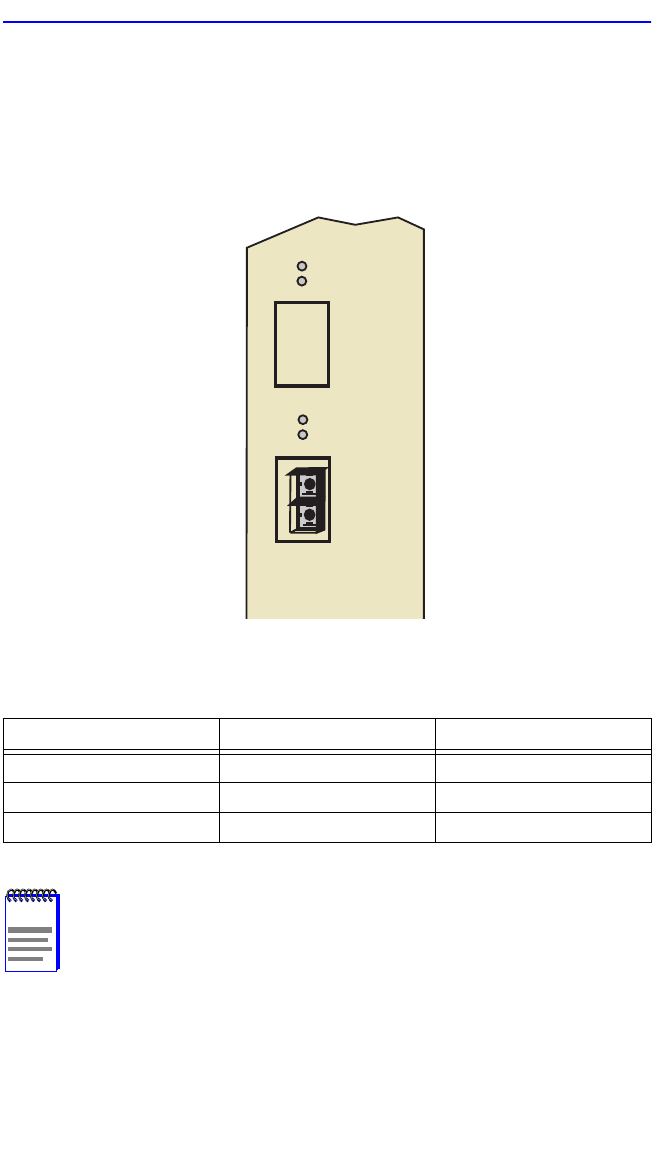
FE-100FX
6H128-08 and 6H129-08 User’s Guide B-3
B.2 FE-100FX
The FE-100FX shown in Figure B-2 uses an SC style connector that
supports multimode fiber optic cabling. Specifications for the FE-100FX
are listed below.
Figure B-2 FE-100FX
Table B-1 Transmitter Power
Cable Type Worst Case Budget Typical Budget
50/125 µm fiber 6.0 dB 9.0 dB
62.5/125 µm fiber 9.0 dB 12.0 dB
100/140 µm fiber 15.0 dB 18.0 dB
NOTE The transmitter power levels and receive sensitivity levels listed
are peak power levels after optical overshoot. A peak power
meter must be used to correctly compare the values given
above to those measured on any particular port. If power levels
are being measured with an average power meter, add 3 dB to
the measurement to compare the measured values to the
values listed above.
FE-100FX
7
8
FE-100FX
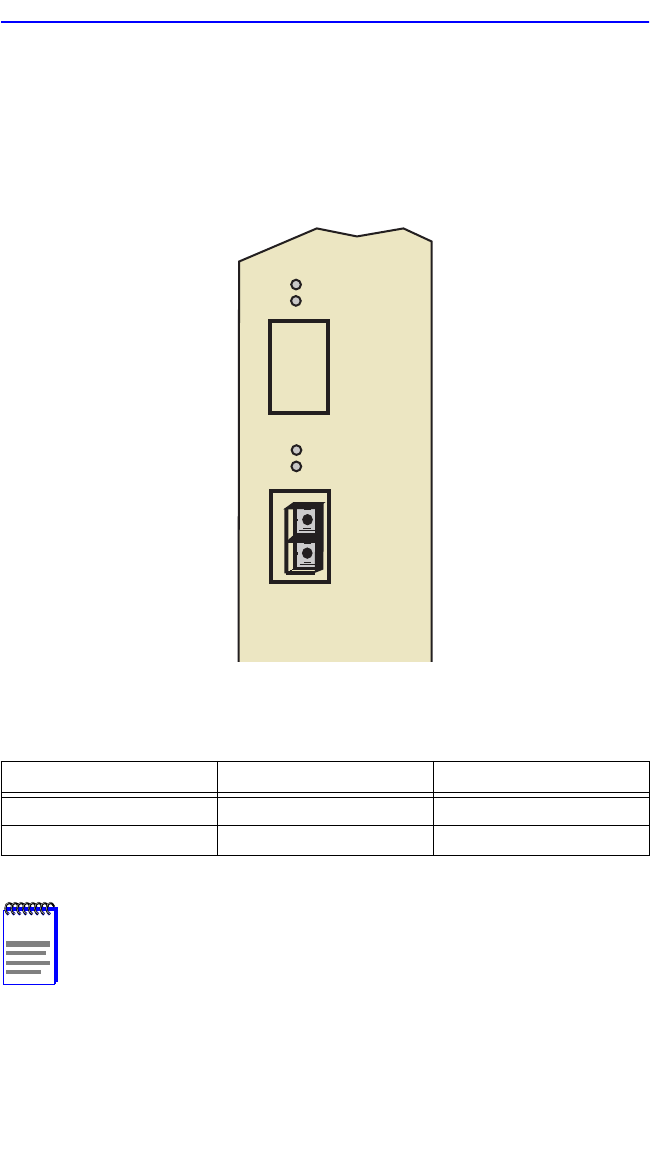
Appendix B: FE-100TX, FE-100FX and FE-100F3 Specifications
B-4 6H128-08 and 6H129-08 User’s Guide
B.3 FE-100F3
The FE-100F3 shown in Figure B-3 uses an SC style connector that
supports single mode fiber optic cabling. Specifications for the FE-100F3
are listed in Table B-2 below.
Figure B-3 FE-100F3
Table B-2 Transmitter Power
Cable Type Worst Case Budget Typical Budget
8/125 µm fiber >10.0 dB <10.0 dB
12/125 µm fiber >10.0 dB <10.0 dB
NOTE The transmitter power levels and receive sensitivity levels listed
are peak power levels after optical overshoot. A peak power
meter must be used to correctly compare the values given
above to those measured on any particular port. If power levels
are being measured with an average power meter, add 3 dB to
the measurement to compare the measured values to the
values listed above.
FE-100FX
7
8
FE-100F3

6H128-08 and 6H129-08 User’s Guide C-1
APPENDIX C
OPTIONAL INSTALLATIONS AND
MODE SWITCH BANK SETTINGS
This appendix covers the following items:
•Required tools (Section C.1)
•Locations, functions, and settings for the mode switches (Section C.2)
•Installing optional Fast Ethernet Interface Modules (Section C.3)
C.1 REQUIRED TOOLS
You need the following tools to perform the procedures in this appendix:
•An antistatic wrist strap (provided with 6C105 chassis).
•A Phillips screwdriver is required when installing optional Fast
Ethernet Interface Modules for ports 7 and 8 into the 6H12X-08.
C.2 SETTING THE MODE SWITCH
These switches are set at the factory and do not need to be changed unless
you intend to perform the following:
•Force download a new image file from a BootP server.
•Clear NVRAM and restore all user-entered parameters such as the IP
address and subnet masks to the 6H12X-08 “default” configuration
settings.
•Clear user-entered passwords stored in NVRAM and restore the
default passwords.
!
CAUTION
Only qualified service personnel should attempt the following
procedures.
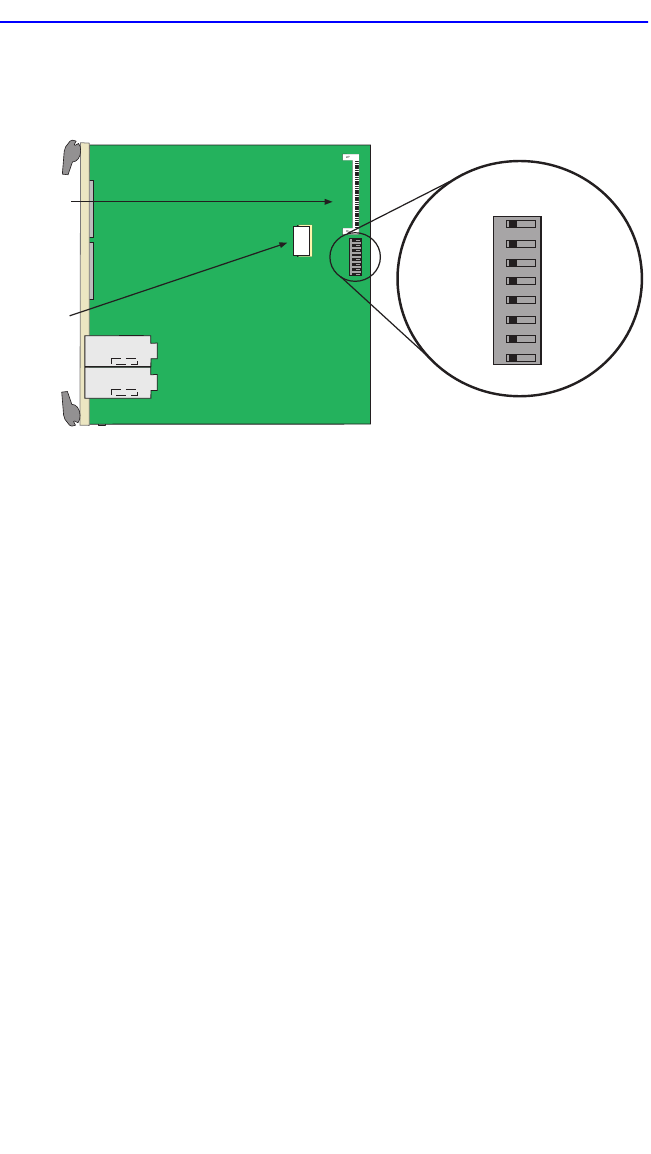
Appendix C: Optional Installations and Mode Switch Bank Settings
C-2 6H128-08 and 6H129-08 User’s Guide
Figure C-1 shows the location of the mode switches and the switch
settings for normal operation.
Figure C-1 6H12X-08 Mode Switch Location/Component Layout
Switch definitions and positions are as follows:
•Switches 1 through 4 – For Cabletron Systems use only.
•Switch 5 – COM Port Autobaud. The default (OFF) position enables
Autobaud sensing on the COM port for Local Management sessions.
Changing the switch to the ON position disables Autobaud sensing and
sets the COM port to 9600 baud for Local Management sessions.
•Switch 6 – Forced BootP. Changing the position of this switch (i.e.,
moving the switch from one position to the other) clears download
information from NVRAM and forces the 6H12X-08 to download a
new image file from a BootP server after power to the chassis is
restored.
After changing the position of switch 6 and restarting the module, the
6H12X-08 requests a new image download until it either receives a
new image or the RESET button on the front panel is pressed. When
the RESET button is pressed, the 6H12X-08 continues trying to
contact a BootP server, but will time out in approximately one minute.
If the module times out, the image is downloaded from its FLASH
memory.
Flash
DRAM
MODE SWITCH
1
2
3
4
5
6
7
8
OFF ON
2159_34
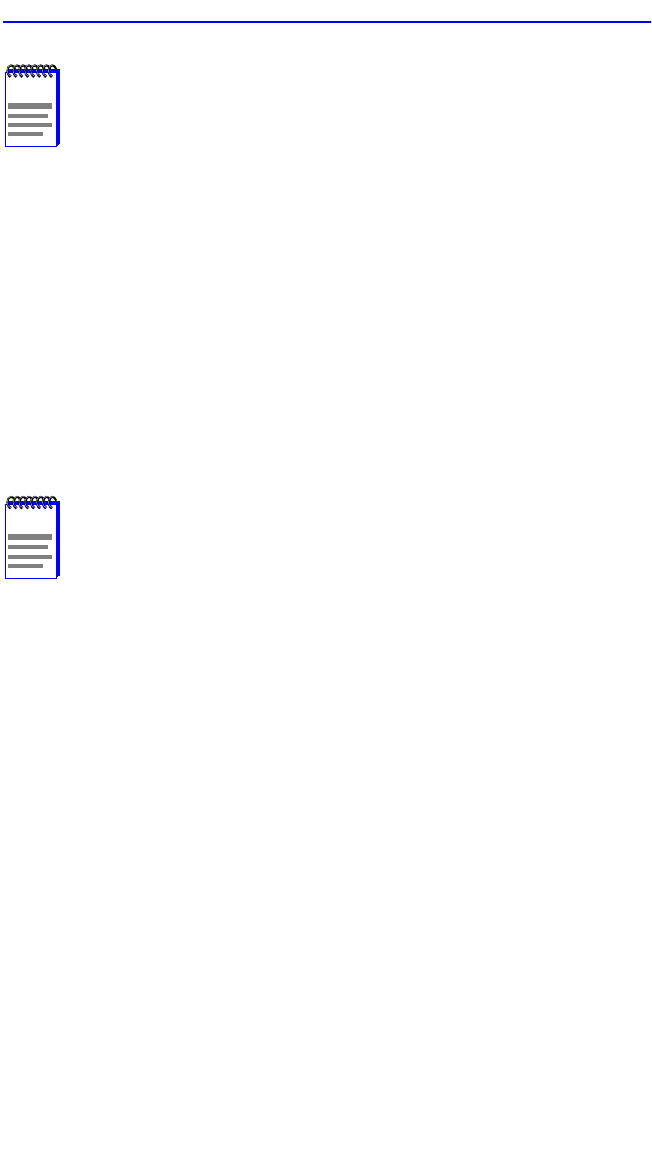
Setting the Mode Switch
6H128-08 and 6H129-08 User’s Guide C-3
•Switch 7 – Clear NVRAM. Changing the position of this switch resets
NVRAM on either the next power up or the next operation of the front
panel RESET switch. ALL user entered parameters, such as IP
addresses, subnet masks, SNMP traps, and switching functions are
restored to their factory default settings.
•Switch 8 – Reset Password/Community Strings. Changing the position
of this switch clears only the user-entered passwords stored in
NVRAM, and restores the default passwords. Once the 6H12X-08
resets, the passwords can either be reentered or the default passwords
(Public and ENTER) may be used.
NOTE After changing the position of switch 6, DO NOT reapply power
to the chassis until there is a station acting as a BootP server,
which contains the image file.
NOTE Do not change the position of switch 8 unless it is necessary to
reset the module super-user configured passwords to their
factory default settings.
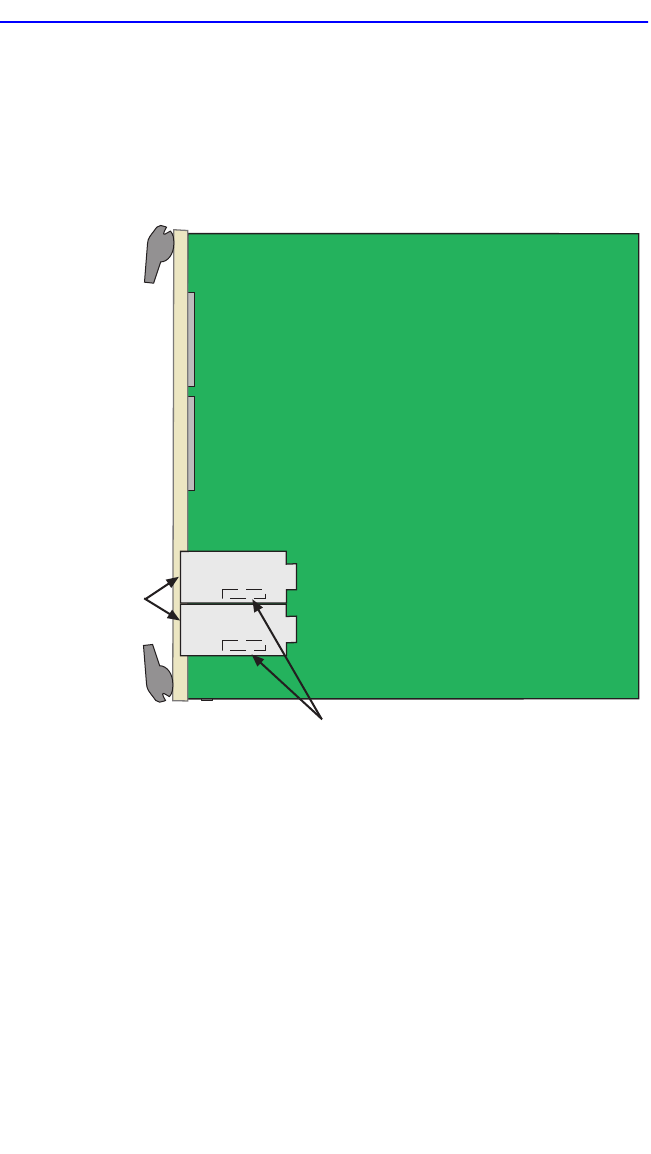
Appendix C: Optional Installations and Mode Switch Bank Settings
C-4 6H128-08 and 6H129-08 User’s Guide
C.3 INSTALLING OPTIONAL FAST ETHERNET
INTERFACE MODULES
Figure C-2 shows the location of the Fast Ethernet Interface Module
connectors on the 6H12X-08 board for port slots 7 and 8.
Figure C-2 Fast Ethernet Interface Module Connector Location
Optional Fast
Ethernet Interface
Modules
Connectors

Installing Optional Fast Ethernet Interface Modules
6H128-08 and 6H129-08 User’s Guide C-5
To install a Fast Ethernet Interface Module in port slot 7 or 8 of the
6H12X-08, proceed as follows:
1. Remove the coverplate from the port slot where the Fast Ethernet
Interface Module will be installed.
To remove a coverplate, refer to Figure C-3 and proceed as follows:
a. Remove the two screws fastening the coverplate to the standoffs.
Save the screws.
b. Lift and remove the coverplate from the top of the front standoffs.
!
CAUTION
The Fast Ethernet Interface Module and the 6H12X-08 are
sensitive to static discharges. Use an antistatic wrist strap and
observe all static precautions during this procedure. Failure to
do so could damage the module or the 6H12X-08.
!
CAUTION
The FE-100F3 uses Class 1 lasers. Do not use optical
instruments to view the laser output. The use of optical
instruments to view laser output increases eye hazard. When
viewing the output optical port, power must be removed from
the network adapter.
TIP
When installing Fast Ethernet Interface Modules in both port
slots 7 and 8, remove the coverplates from both slot openings.
In the following instructions, the optional module is shown
being installed in port slot 8.
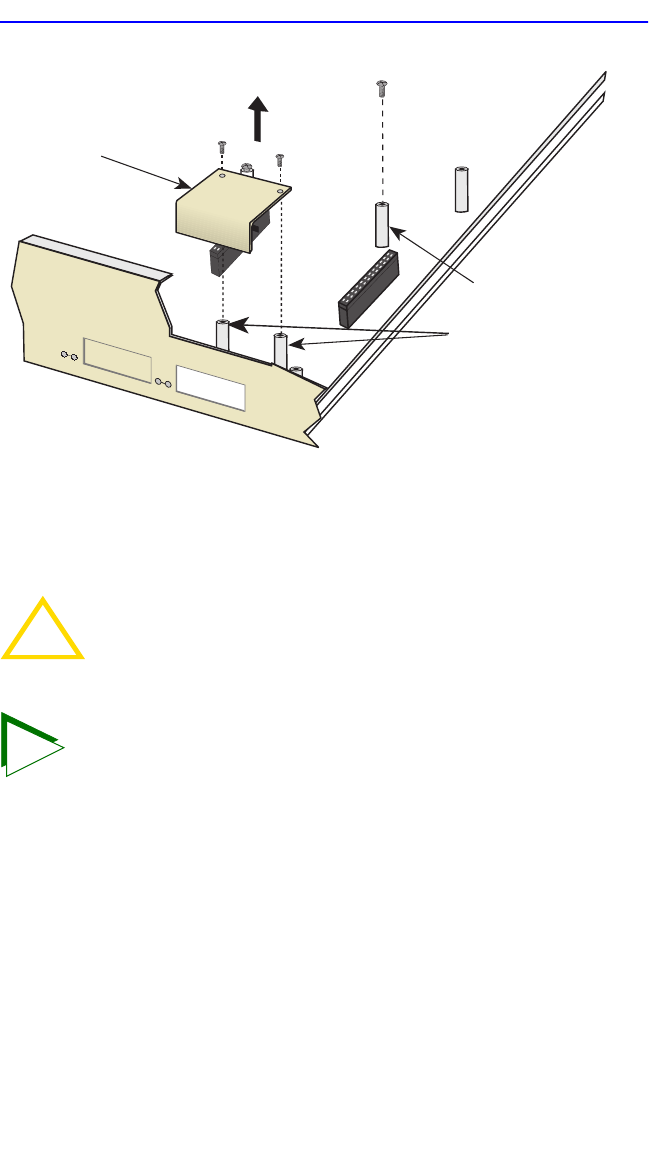
Appendix C: Optional Installations and Mode Switch Bank Settings
C-6 6H128-08 and 6H129-08 User’s Guide
Figure C-3 Coverplate Removal
2. Remove the screw from the rear standoff. Save the screw.
3. See Figure C-4. Gently pull the faceplate of the 6H12X-08 forward to
allow room for the Fast Ethernet Interface Modules to be aligned over
the connector.
!
CAUTION
When installing an FE-100FX or FE-100F3 module into the
6H12X-08, remove the rubber plug on the Fast Ethernet
Interface Module before proceeding.
TIP
If the port is not connected to the network right away, reinstall
the rubber plug to reduce the chance of contaminating the
connector.
Front
Standoffs
Rear
Standoff
Coverplate
78
2159-32
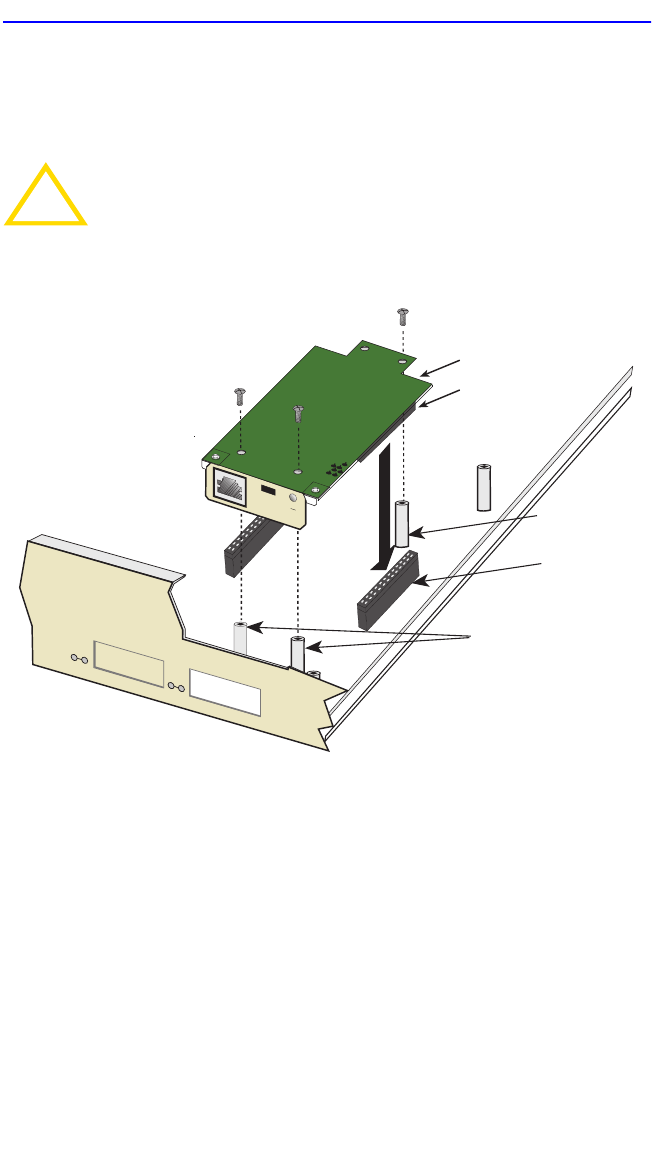
Installing Optional Fast Ethernet Interface Modules
6H128-08 and 6H129-08 User’s Guide C-7
4. Carefully lower the Fast Ethernet Interface Module onto the standoffs
while inserting the module connector into the associated motherboard
connector. See Caution below.
Figure C-4 Installing the Fast Ethernet Interface Module
5. Press down firmly on the Fast Ethernet Interface Module until the pins
slide all the way into the motherboard connector. Ensure that the Fast
Ethernet Interface Module seats flush on the standoffs.
6. Secure the Fast Ethernet Interface Module with the screws saved in
Step 1 and Step 2.
7. Installation is complete.
!
CAUTION
When inserting the Fast Ethernet Interface Module into the
motherboard connector ensure that the pins do not bend, as
this can damage both the Fast Ethernet Interface Module and
the motherboard connector.
2159-33
FE-100TX
10
100
Front
Standoffs
Rear
Standoff
Module
Motherboard
Connector
Module
Connector
78

Appendix C: Optional Installations and Mode Switch Bank Settings
C-8 6H128-08 and 6H129-08 User’s Guide

6H128-08 and 6H129-08 User’s Guide Index-1
INDEX
Numerics
100BASE-FX
cable length 2-2
10BASE-T
connection 3-5, 3-8
802.1Q VLAN configuration 5-16
A
Access policy 5-26, 5-58
B
Broadcast Suppression Screen 5-82,
5-83
C
Cable specifications
100BASE-FX MMF 2-2
100BASE-TX network 2-2
chassis date 5-18
Chassis Environmental Information
Power Supply #X Status 5-30
Chassis Fan Status 5-31
Chassis Power Redundancy 5-30
chassis time 5-18
Chassis Uptime 5-19
Chassis/General Configuration screen
chassis date 5-18
chassis time 5-18
chassis uptime 5-19
IP address 5-17
screen lockout time 5-19
screen refresh time 5-18
subnet mask 5-18
COM port 5-52
pin assignments A-2
COM port Application
SLIP, LM, PPP, UPS 5-54
Connecting to the network 3-5
Crossover switch B-1
Current switch utilization 5-73
D
Default gateway 5-42, 5-46
Download
image file Using BootP 5-78
image file using RUNTIME 5-77
image file using TFTP 5-76
E
Environmental requirements A-1
Ethernet Interface screen
advertised ability 5-69
configuring an FE-100FX 5-69
configuring an FE-100TX 5-70
current operational mode 5-68
desired operational mode 5-68
link status 5-67
port type 5-67
F
FE-100F3 B-4
FE-100FX
transmitter power B-3, B-4
FE-100TX Pinouts B-1
Fiber connection
SC to SC 3-6, 3-10
G
General Configuration screen
application 5-44
COM port 5-52
default gateway 5-42, 5-46
fields 5-41
IP address 5-41, 5-44
MAC address 5-41
module date 5-42, 5-48
module time 5-42, 5-48
screen lockout time 5-23, 5-42,
5-50
screen refresh time 5-22, 5-42, 5-49
subnet mask 5-20, 5-41, 5-46

Index
Index-2 6H128-08 and 6H129-08 User’s Guide
H
Help 1-11
related manuals 1-12
I
Installation
Fast Ethernet Interface Module C-4
IP address 5-17, 5-41, 5-44
setting 5-20
IP Fragmentation 5-44
K
Keyboard conventions 5-3
L
LANVIEW LEDs 4-1
Local Management
exiting 5-12
TELNET 5-4, 5-7
M
MAC Address 5-17
Module Configuration Menu screen
fields 5-39, 5-72
Module date 5-42
Module Statistics Menu screen
switch statistics 5-85
Module time 5-42
N
Network connection
FE-100FX 3-10
FX-100TX 3-8
Network Tools 5-96
commands 5-97
NVRAM 5-44
clearing 5-55
O
Operational Mode 5-42
setting 5-50
P
Peak switch utilization 5-74
Physical specifications A-1
Power Supply #X Status 5-30
R
RESET button 4-7
Runtime IP address discovery 1-5
S
Safety A-3
Safety information
laser iv
Screen lockout time 5-19, 5-42, 5-50
setting 5-23
Screen refresh time 5-18, 5-22, 5-49
SmartTrunk
introduction to 1-8
SNMP Community Names screen
access policy 5-26, 5-58
Community Name 5-26, 5-58
editing 5-27
SNMP Traps screen
enable traps 5-29
trap community name 5-28
trap destination 5-28
trap table configuration 5-29, 5-61
Spanning Tree Algorithm 5-63
Specifications A-1
Standards compatibility 1-6
Subnet mask 5-18, 5-20, 5-41, 5-46
setting 5-20
Switch address 5-63
Switch Configuration screen
MAC address 5-64
port status 5-66
selecting the STA 5-65
state 5-64
status 5-64
Switch address 5-63
type of STA 5-63
System Resources screen
current switch utilization 5-73

Index
6H128-08 and 6H129-08 User’s Guide Index-3
DRAM installed 5-73
Flash memory installed 5-73
NVRAM installed 5-73
peak switch utilization 5-74
reset peak switch utilization 5-74
T
Trap table configuration 5-29, 5-61
Traps 5-29
Troubleshooting 4-1
checklist 4-6
U
Uninterruptible Power Supply
COM configuration for 5-7
connection of 5-7
Unpacking the module 3-1

Index
Index-4 6H128-08 and 6H129-08 User’s Guide